
OCTOBER 2023 • Vol. 37, Issue No. 10 arolinaCCCattle onnection Spotlight on WAGYU

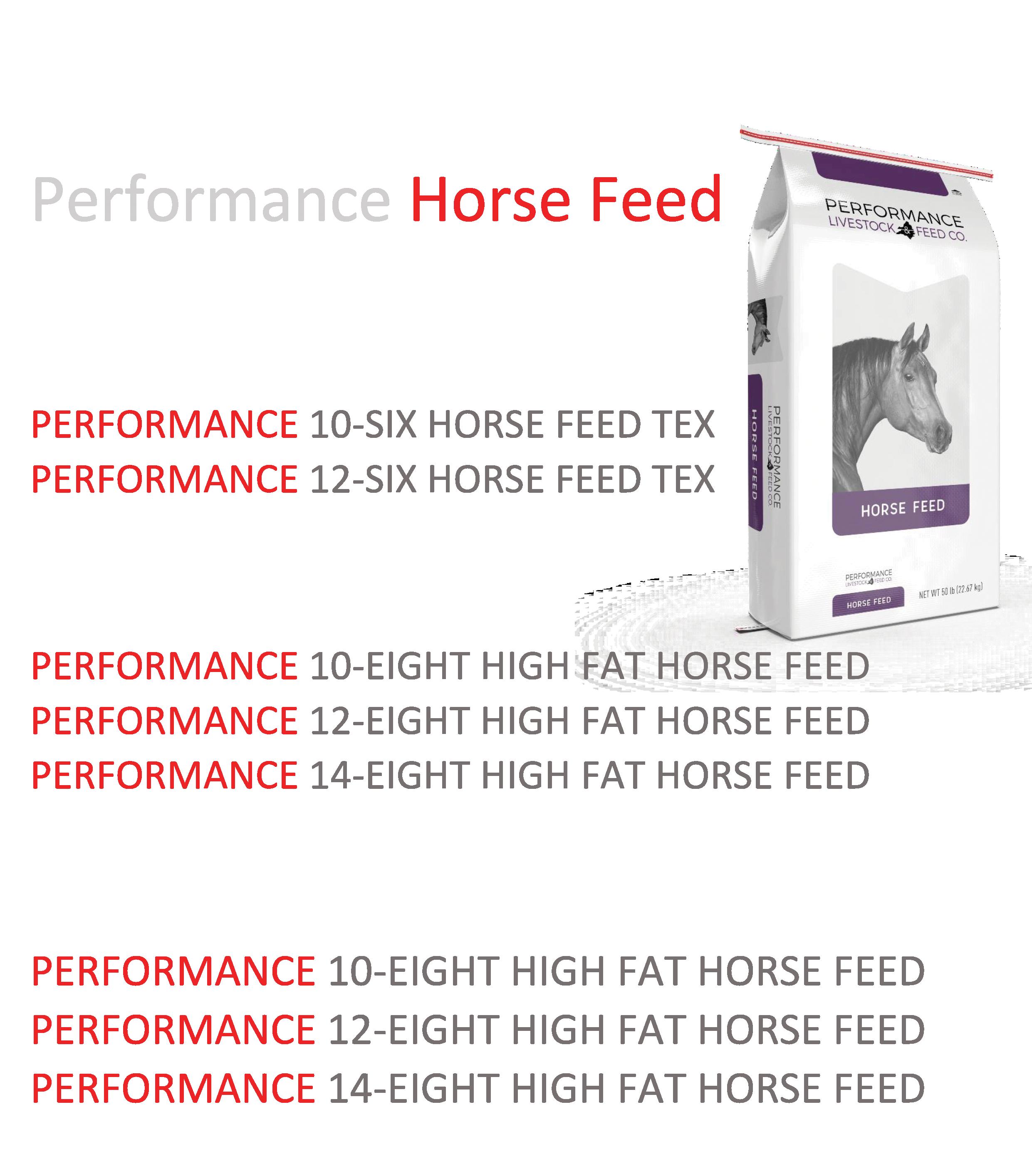

Manufactured by: Performance Livestock and Feed Company 11 Redd Level Plant Road • Martinsville, VA 24112 5767 NC 8 HWY North • Lawsonville, NC 27022 www.performancefeedco.com Office - 888-777-5912
2023 N.C. Junior Beef Round-Up Results .............................................................................. page 72
2023 South Carolina Sale Barn Cattle Receipts .................................................................... page 63
A Message from the CEO — As Grassroots as It Gets, by Colin Woodall .......................... page 66
Alltech News . page 80
Amazing Grazing — Those Amazing Dung Beetles!, by Matt Poore .................................. page 14
American Angus Association News ....................................................................................... page 30
American Gelbvieh Association News .................................................................................. page 49
Animal Agriculture Alliance News .......................................................................................... page 35
Ashley’s Beef Corner — Head Back to Class with Beef, by Ashley W. Herring ................. page 12
Beef Checkoff News ................................................................................................................... page 77
Beef Cuts and Recommended Cooking Methods ................................................................ page 78
BioZyme News ........................................................................................................................... page 84
Carolina Cooking — Cheeseburger Dip ................................................................................. page 57
Cattlemen’s Beef Board Update ............................................................................................ page 71
Certified Angus Beef News ...................................................................................................... page 27
Director’s Report — Beef Quality Assurance Revisited, by Bryan K. Blinson .................... page 3
E.B.’s View from the Cow Pasture
49 National Alfalfa & Forage Alliance News ............................................................................... page 64 National Cattlemen’s Beef Association News ...................................................................... page 63 National Cattlemen’s Beef Association President’s Report — Setting the Standard, by Todd Wilkinson .................................................................................................................. page 58
New NCCA Members for 2023 ................................................................................................. page 73
North American Limousin Foundation News ...................................................................... page 42
North Carolina Cattle Receipts, Trends, and Prices ............................................................ page 35
Pasture Managment Systems, Inc. Mile of Fence Program Update ................................. page 74
Purina News .. page 58
Renovo Seed News .................................................................................................................... page 66
Ridley Block News — The Economics of Self Fed Supplements
— How Crystalyx Pencil Out, by Jon Albo ........................................................................ page 43
Riomax 360º News ..................................................................................................................... page 50
S.C. Charolais News, by Georgeanna Webb ............................................................................ page 20
South Carolina Cattle Receipts, Trends, and Prices ............................................................ page 52
The Chaplain’s Corral — Extreme Mustang Makeover, by Crystal Bowers ....................... page 17
The MVP (Most Valuable Protein) in Retail .......................................................................... page 87
The Simmental Trail, by Jennie Rucker ..................................................................................... page 36
Trending in Food & Media ......................................................................................................... page 76
Understanding Beef Quality Grades ...................................................................................... page 71
Vytelle News — Windy Hill Farms Becomes a News Satellite Location for Vytelle
— Making Better Cattle Through In Vitro Fertilization, .................................................. page 52
You Decide!, by Dr. Mike Walden ............................................................................................. page 20
Zoetis News ... page 44
N.C. Cattlemen’s Association
President SCOTT WEST
489 Panacea Springs Road • Littleton, NC 27850
Vice Presidents
RYAN CLARK
5250 NC 772 Hwy. • Madison, NC 27025
BRANDON BOWMAN
2346 Ann Street • Claremont, NC 28610
JIM LEDFORD
260 Mulberry Lane • Otto, NC 28763
Immediate Past President
BURON LANIER
2877 Piney Woods Road • Burgaw, NC 28425
NCBA Regional Vice President (Policy)
FRED SMITH, JR.
NCBA Policy Division Director - JOHN LANGDON
N.C. Beef Council Director
RALPH BLALOCK, JR.
Beef Board Director - BRIAN WARREN
Secretary/Treasurer - EVERETT JOHNSON
Directors At Large
MATT POORE • NEIL BOWMAN • TODD SEE
Executive Director - BRYAN K. BLINSON
2228 N. Main Street • Fuquay-Varina, NC 27526
N.C. Cattlemen’s Beef Council
Director of Consumer Information
ASHLEY W. HERRING
Administrative Assistant - KIM BURDGE
S.C. Cattlemen’s Association
Executive Director - TRAVIS MITCHELL
P.O. Box 207 • Saluda, SC 29138
Phone: 803-609-2828
Email: twmitch@clemson.edu
Website: www.sccattlemen.wildapricot.org
Executive Committee
President - Timmy Benton
1st Vice President - Joe Oswald IV
2nd Vice President - Gene Crim
Secretary - Carol Hendrix
Treasurer - Eric Seymour
Past President - Roscoe Kyle
John Lews, Chester • Joe Oswald, IV, Allendale
Roscoe Kyle, Inman • Terry Kirkland, Batesburg
Lloyd Baxley, Georgetown • Joe Davis, Westminster
Michael Hall, Abbeville • Richard Sox, Lexington
Carol Hendrix, Westminister • Jamie Driggers, Hamer
Timmy Benton, Walterboro • Michael Bailey, Lancaster
Bonnie Cann, Abbeville • Ashley Mills, Blair
Drake Yon, Ridge Spring • Gene Crim, St. Matthews
Lee Haddon, Gaffney • Eric Seymour, Columbia
S.C. Beef Council
P.O. Box 11280 • Columbia, SC 29211
Phone: 803-917-1119
Email: scbeef@scda.sc.gov
Website: www.sccattle.org
The Carolina Cattle Connection
Vol. 37, No. 10 OCTOBER 2023
Sales & Publication Office 2228 N. Main Street Fuquay-Varina, NC 27526
Phone: 919-552-9111
Fax: 919-552-9216
Email: mail@nccattle.com
Website: www.nccattle.com
The Carolina Cattle Connection is printed on 30 lb recycled newsprint by BN Printing in Benson, N.C.
STAFF
Manager, N.C. BRYAN BLINSON
Manager, S.C. TRAVIS MITCHELL
Editor & Advertising Director CASEY L. HINNANT
Assistant Editor & Proofreader KIM BURDGE
N.C. Circulation KIM BURDGE
S.C. Circulation TRAVIS MITCHELL
Material in The Carolina Cattle Connection is not to be reproduced in total or in part without the written permission of the Editor. All submissions become property of The Carolina Cattle Connection, but we make every effort to return items such as photographs and artwork as requested.
The Carolina Cattle Connection, the official publication of the N.C. Cattlemen’s Association and the S.C. Cattlemen’s Association is published monthly by the N.C. Cattlemen’s Association.
A complementary subscription is included with membership to each state’s association. Nonmember subscriptions are $30 per year.
All address changes for NCCA members to:
The Carolina Cattle Connection 2228 N. Main Street • Fuquay-Varina, NC 27526
All address changes for SCCA members to:
The Carolina Cattle Connection P.O. Box 207 • Saluda, SC 29138
WAGYU
The Value of Participating in a Wagyu Buy Back Program, by Heather Smith Thomas … page 10
UMO Faculty Tour Bigtime Cattle Operation in Small TownTurkey, N.C., by Rhonda Jessup … page 6
Wagyu Beef Has Multiple Health Benefits, by Heather Smith Thomas … page 8
What Are Wagyu? … page 4
The Carolina Cattle Connection q OCTOBER 2023 PAGE 1
ONNECTION
— You Cut All My Horns Off, by E.B. Harris .............. page 16 Endovac Animal Health News .................................................................................................. page 77 Federation of State Beef Councils Update ............................................................................ page 79 Forage News — S.C. Forage & Grazing Lands Coalition Annual Meeting ....................... page 64 Have You Herd — Necessary Cattle Handling Facilities for Small Farms, by Claire Fields ......................................................................................................................... page 18 International Brangus Breeders Association News ............................................................ page 57 John Deere News ........................................................................................................................ page 63 Livestock Marketing Association News ................................................................................ page

PAGE 2 The Carolina Cattle Connection q OCTOBER 2023
Director’s report
By BRYAN K. BLINSON Executive Director, NCCA
Beef Quality Assurance Revisited
We have come to expect that expert artists, craftsmen, chefs, and many others pride themselves in a job well done and a product that others want to enjoy and are willing to pay good money for. I see you, the families that carefully produce beef in North Carolina and across this country, as just such experts. The demand for our beef is stronger than ever, as evidenced by the prices that consumers in the United States and the world over are willing to pay for the beef they feed their families and friends. They have come to expect beef to be not only a pleasure in their day-to-day lives but also a centerpiece for celebrations. This would not be possible without the hard work, dedication, and attention to detail that make the cattle you raise produce the highest quality beef in the world.

Like the skilled experts listed above, cattle producers have embraced the varied demands of consumers to provide a variety of products that appeal to different audiences with different tastes and priorities. Whether the attribute is local, grass fed, grain fed, ultra marbled, or ultra lean, there is a delicious beef choice for every consumer. But consistently, regardless of the breed combination, production method, or part of the country the cattle are raised in, quality and safety of the beef is expected.
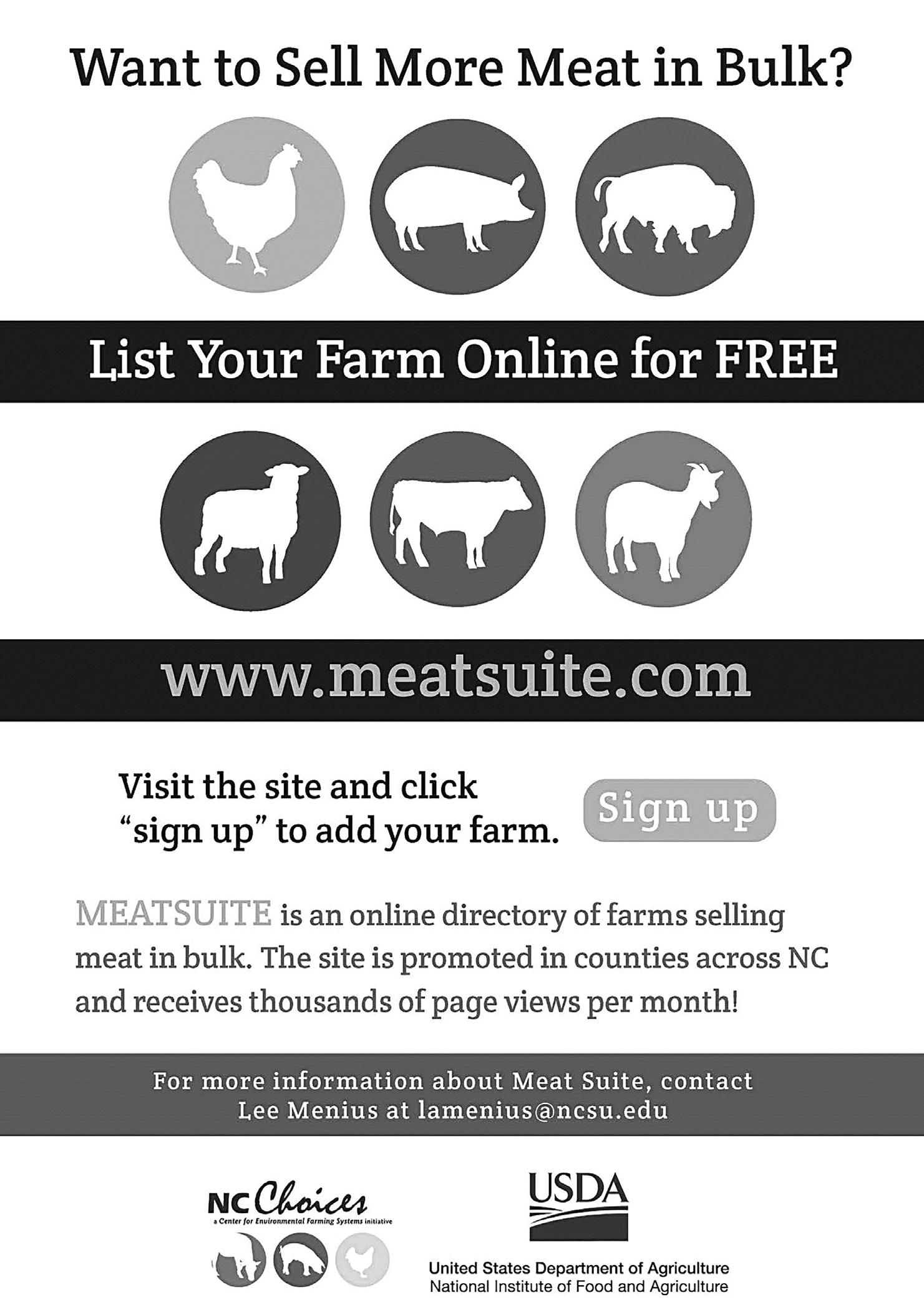
When the first Beef Quality Audit was completed many years ago, the industry found that we had lots of problems. We had major problems with injection site lesions, inconsistency in carcass size and eating qualities, and many others. We set out to help solve these problems with the Beef Quality Assurance program or BQA. Like being told to wear seat belts, some of the practices suggested met with some resistance but now are second nature. Fortunately, the resistance was brief, and we were never regulated into the practices because the practices were embraced, and our industry regained the momentum of demand. While we will continue to discover improvements that can be made
in management that will enhance not only the beef we produce but our bottom line and satisfaction when we walk among our cattle, we have made tremendous strides.
In September, there were five BQA workshops across the state to help new producers learn about BQA and become certified. These workshops also welcomed experienced producers to brush up on their knowledge of BQA practices to enhance their quality while also making their farming experience more satisfying to them and more acceptable to consumers. I enjoyed visiting with producers, young and old, at each of these five events and stressed just how important BQA is to the entire industry. These workshops are a joint effort of the NCSU Cooperative Extension, the National Cattlemen’s Beef Association, and the N.C. Cattlemen’s Association, led by the NCSU Beef Animal Agricultural Program Team. It is our hope that those who attended will become not only producers with new skills but also advocates for the better production of beef through BQA.
The early trainings that many of you remember focused on moving our injections into the neck and away from high valued areas of the carcass. Today, this is still taught, but the practices emphasized in these trainings cover all aspects of production from conception to consumption. We talked about timely culling, good record keeping, proper nutrition, low stress handling (for us and the cattle), transportation, and much more. All of which not only lead to a higher quality beef eating experience but a more profitable and enjoyable experience for those raising the cattle.
One of the biggest challenges we have in our industry is from those who do not understand what we do and want to tell us how we should take care of the cattle we raise. The more farmers we have who can learn and embrace the practices taught through the BQA program, the easier it is to counter the arguments of
our naysayers. I encourage each of you, as well as myself, to continue to improve what we do on our farms and with our cattle to make sure we, personally and as an industry, remain successful.
If you were not able to attend any of these workshops in September, join us at the N.C. Cattlemen’s Conference
on February 23-24 in Hickory, where we will have speakers and workshops that will provide insightful information that will help you whether you are brand new to the industry or a seasoned hand at the craft of raising cattle and producing beef that is the centerpiece of an eating experience that is truly a piece of art.
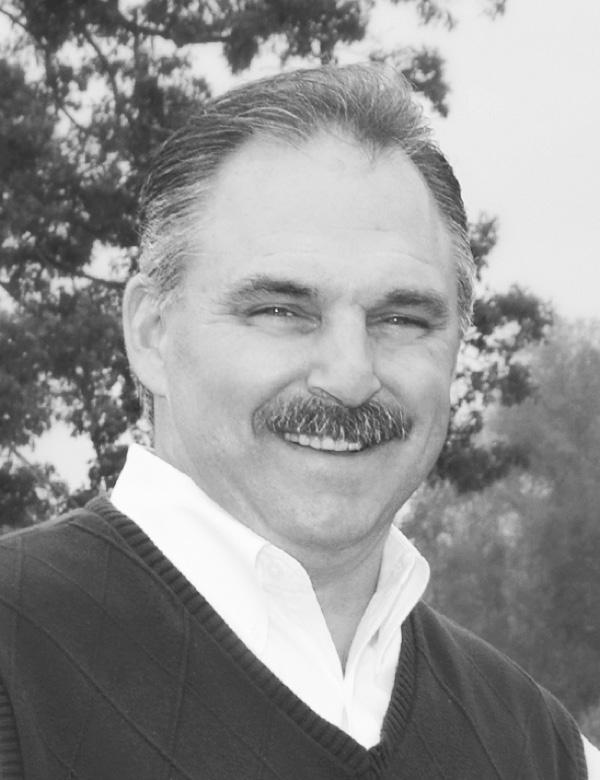
The Carolina Cattle Connection q OCTOBER 2023 PAGE 3
Spotlight on WAgYU e Special Section f
What Are Wagyu?
Wagyu - a Japanese beef cattle breed – derive from native Asian cattle. ‘WAGYU’ refers to all Japanese beef cattle, where ‘Wa’ means Japanese, and ‘gyu’ means cow.
Wagyu were originally draft animals used in agriculture and were selected for their physical endurance. This selection favored animals with more intra-muscular fat cells – ‘marbling’ – which provided a readily available energy source. Wagyu is a horned breed, and the cattle are either black or red in color.
Wagyu Breed History in Japan - There is some evidence of genetic separation into the Wagyu genetic strain as much as 35,000 years ago. Modern Wagyu cattle are the result of crossing the native cattle in Japan with imported breeds. Crossing began in 1868 after the Meiji restoration in that year. The government wanted to introduce Western food habits and culture. Brown Swiss, Devon, Shorthorn, Simmental, Ayrshire, and Korean cattle were imported during this period. The infusions of these British, European, and Asian breeds were closed to outside genetic infusions in 1910.
The variation of conformation within the Wagyu breed is greater than the variation across British and European breeds. The three major black strainsTajiri or Tajima, Fujiyoshi (Shimane), and Kedaka (Tottori) evolved due to regional geographic isolation in Japan. These breeding differences have produced a Japanese national herd that comprises 90 percent black cattle, with the remainder being of the red strains Kochi and Kumamoto. For more information on the genetic diversity of the breed, visit wagyu.org/breed-info/wagyu-origins

In Japan, there are four breeds that
are considered Wagyu, and those are the Japanese Black (the predominant Wagyu exported to the U.S.), Japanese Brown (In the U.S. referred to as Red Wagyu), Japanese Polled, and Japanese Shorthorn. There are no Japanese Polled or Shorthorns being bred outside Japan. Wagyu strains were isolated according to prefecture (state), and breeds imported for crossing were not the same in each prefecture.
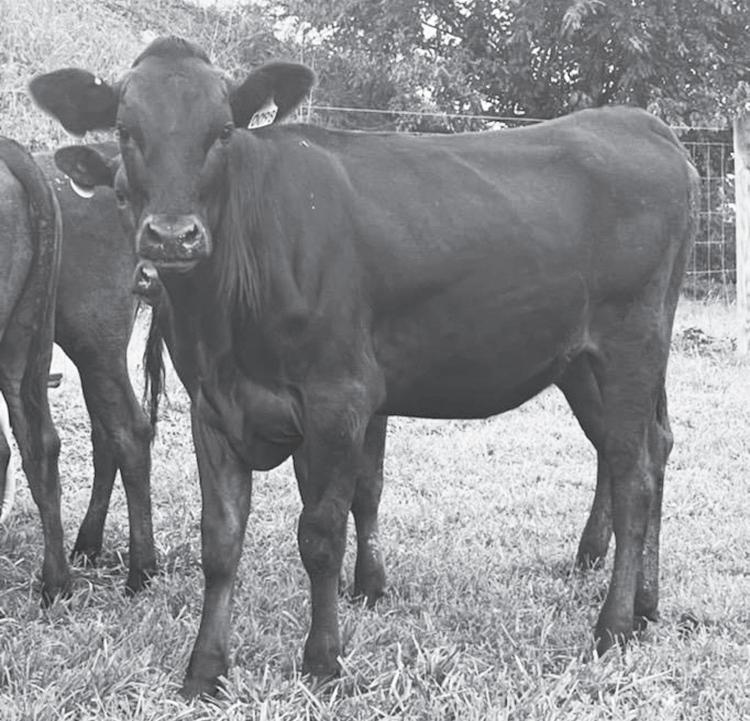
The production of Wagyu beef in Japan is highly regulated, and progeny testing is mandatory. Only the very best proven genetics are kept for breeding. Realizing the value of their unique product, the Japanese government banned the export of Wagyu and declared them a national living treasure. Zenwa is the government held entity in Japan that oversees the Wagyu registry for Japanese Black, Brown, Polled, and Shorthorn.

an unrivaled eating experience. That is why Wagyu beef is finding its way into the repertoires of gourmet cooks and fine restaurants across the United States.
Not only is it a gastronomic delight, but it’s healthy for you too. Health experts have discovered the mono-unsaturated to saturated fat ratio is higher in Wagyu than in other beef, and the saturated fat contained in Wagyu is different. Forty percent is in a version called stearic acid, which is regarded as having a minimal impact in raising cholesterol levels. The profile of marbled Wagyu beef is more beneficial and healthier for human health.
Wagyu is also higher in a type of fatty acid called conjugated linoleic acid (CLA). Wagyu beef contains the highest amount of CLA per gram of any foodstuff – about 30 percent more than other beef breeds – due to higher linoleic acid levels. Foods that are naturally high in CLA have fewer negative health effects.
Wagyu Breed History in U.S.Wagyu cattle were first imported in 1975 when two black and two red bulls were imported by Morris Whitney. In 1989 the Japanese began to reduce their tariffs on imported beef, which encouraged U.S. producers to produce a high quality product for Japan. In the 1990s, there were several importations of quality Wagyu. Most were black, but a few were Red Wagyu. These cattle have the greatest influence on the U.S. herd and those in many other countries.

Most U.S. production was exported to Japan until 2003 when BSE was discovered, and Japan and other countries stopped the import of beef for the United States. However, chefs and others in the U.S. were aware of the superior eating quality of Wagyu and the domestic market then and now utilize much of the U.S. production.
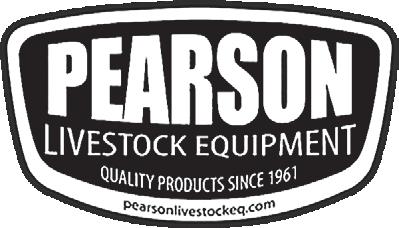

Wagyu Beef — Delicious and Healthy - The unique taste and tenderness of highly marbled Wagyu beef makes for
U.S. Wagyu Today - The American Wagyu Association was incorporated in Texas on March 14, 1990, and serves to register Wagyu cattle in the U.S., Canada, and other countries. The Association headquarters are based in Post Falls, Idaho. The Association has a vibrant membership base and continues to promote and develop a sustainable industry here in the United States.
The opportunities Wagyu beef can offer are endless. This industry caters to the breeder/feeder targeting the high end restaurant trade with highly marbled beef to the bull producer supplying the cow/ calf rearer a crossbred alternative that will offer calving ease ability and premium carcass quality in a single cross which no other beef breed can come close too.
The Wagyu breed has a vital role to play in the U.S. to increase the quality of red meat produced in the U.S. that our health conscious consumer of the 21 st Century is forever seeking.

PAGE 4 The Carolina Cattle Connection q OCTOBER 2023
“DESIGNED FOR CATTLEMEN BY CATTLEMEN” Quality Equipment at Competitive Prices Call about NEW PORTABLE SYSTEMS! National Distributor for Tru-Test Scales Complete Working Facilities for Cattle and Bison Heavy, rugged construction — Built to last! For Information or Brochures, contact: Peter Hostetler 540-810-4605
Scenes from WILDERS FARM


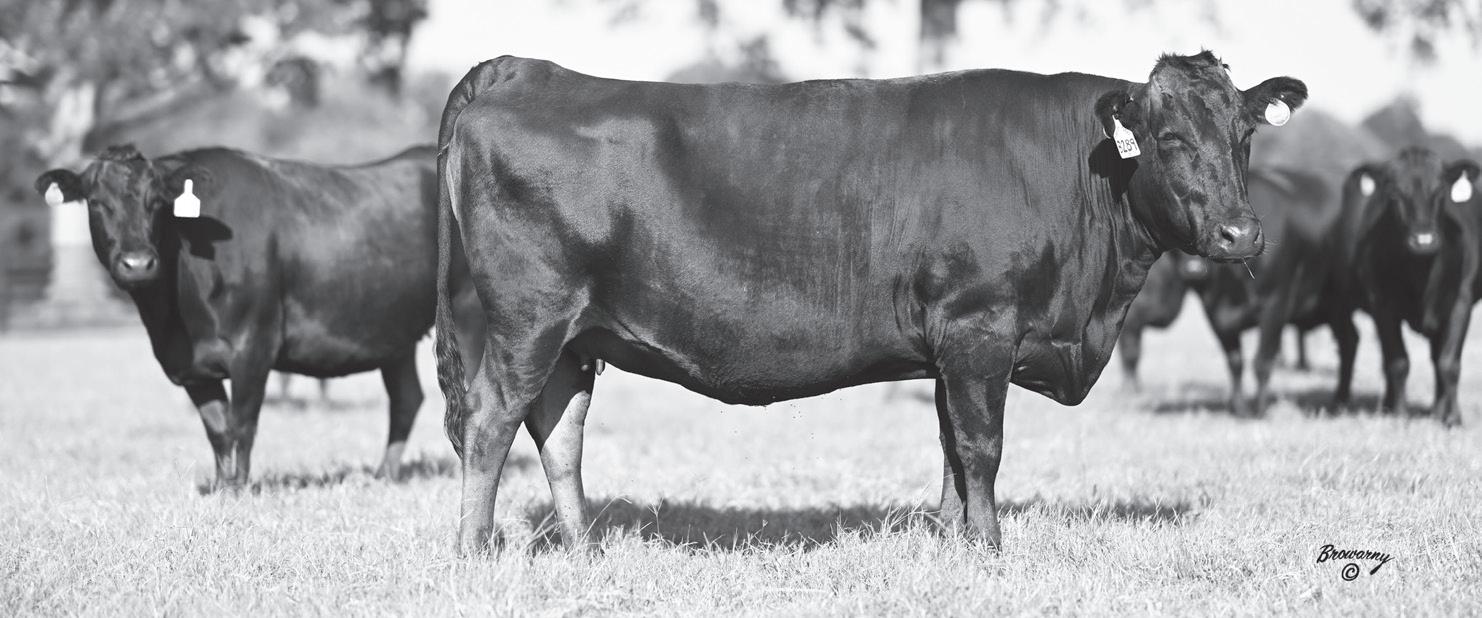






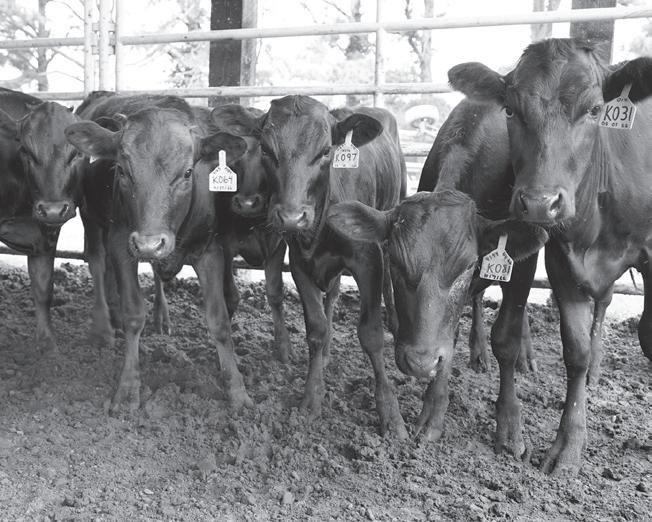


The Carolina Cattle Connection q OCTOBER 2023 PAGE 5
Spotlight on WAgYU e Special Section f
UMO Faculty Tour Bigtime Cattle Operation in Small Town Turkey, N.C.
By RHONDA JESSUP Mount Olive University
Several hundred head of genetically pure, authentic Japanese Wagyu cows and bulls are forging on tender blades of bermudagrass still damp from the late spring frost. Ranch hands are busily checking fences, feeding animals, and cutting hay. Beyond the fence line and into the woods is the sound of Berkshire hogs wallowing lazily in the mud, fresh from the weekend rains.
It may look like a scene from Yellowstone, but the over 1,300 acres of property known as Wilders Farm is located just two miles west of Interstate 40 in the rural Sampson County community of Turkey, North Carolina. Owners Reid and Jaclyn Smith bought the property from the Jeffrey Matthews estate as a means of expanding their pandemic pastime.

“During the height of the COVID -19 pandemic, the Smiths purchased about 30 Wagyu cattle to pass the time and ease the boredom on their Johnston County farm,” said Danielle Lantz, Wilders Brand and Operations Manager. That newfound hobby turned into the start of a profitable venture when the Smiths, who have a strong background in construction and real estate, purchased the Matthews farm.
Former owner, the late Jeffrey Matthews, had a passion for quarter horses and longhorn cattle. Therefore, the many outlying buildings, barns, and fenced-in pastures were well equipped for transitioning to Wagyu cattle.
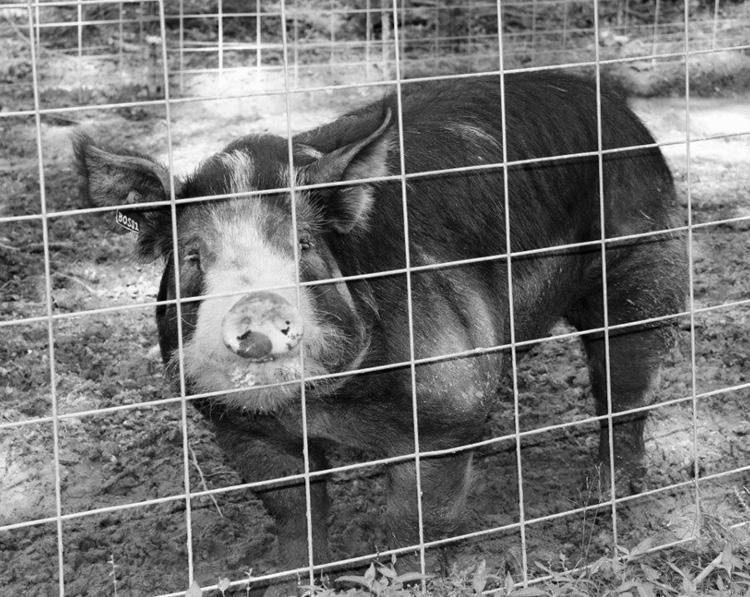

With only a handful of registered Wagyu farmers in North Carolina, the Smiths are forging into relatively new territory. As their website proclaims, “We might be the new kid on the block, but we’re no rookies to farming. Our crew is proud to come from families that have been in farming for generations. We have a deep appreciation for the hard working men and women who make our agriculture community what it is today.”

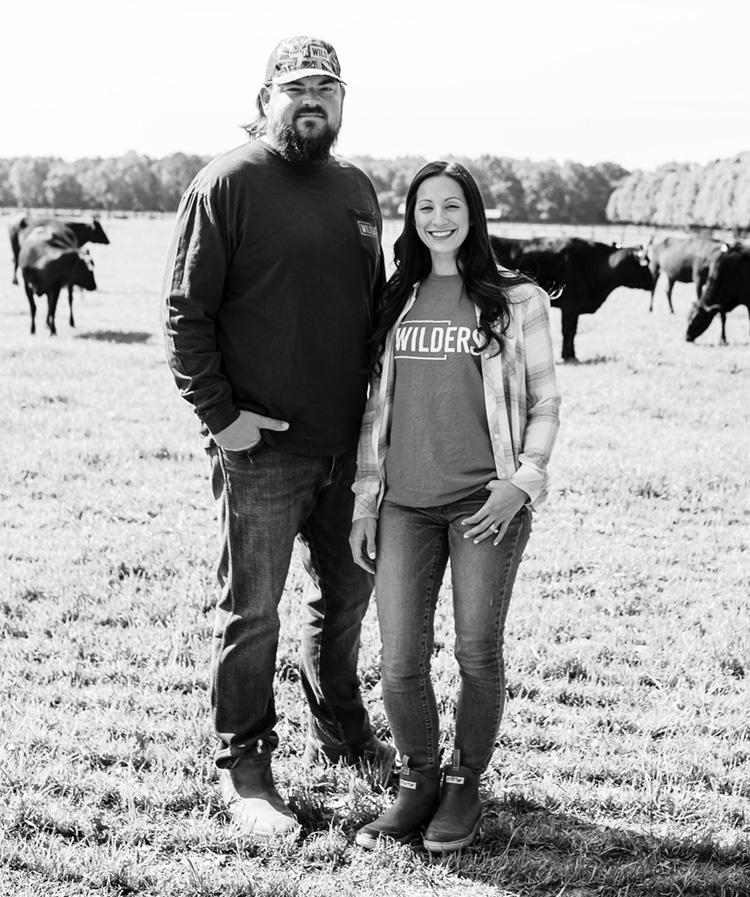
including hay and silage supplements,” she said.

Assistant Professor of Animal Science Dr. William Farmer was especially interested in learning about the farm’s A.I. (artificial insemination) and embryo transfer programs. “We learned that the farm utilizes commercial Angus cows as surrogates,” Farmer said. “This is enabling them to increase their herd at a more rapid and stable rate of production.”
Embracing the community in which they live and work, the Smiths recently extended an invitation to several members of the University of Mount Olive School of Agriculture and Biological Sciences for a farm tour. During the tour, attendees saw the farm’s ten full time staff members managing the day-to-day operations on the farm. “We employ several other part time staff for calving season, breeding season, and retail market days,” said Jake Newbold, Director of Agriculture.
“It is one of our main goals to become a major distributor of authentic Japanese Wagyu genetics for the East Coast in addition to our e-commerce meat sales,” Newbold stated.
Chair of Agricultural Sciences
Heather Glennon said she learned a great deal about feeding and equipment options during the tour. “It was interesting to learn that the Wilders Wagyu are grassfed and grain finished animals, and that the farm is the source of all dietary needs
The Smiths are planning their first cattle sale for early November 2023. They have every expectation that their initial crop of purebred Wagyu will bring a premium price. Known for its’ incredible tenderness, unique marbling, and unmatched flavor, Wilders Wagyu beef is certainly bringing top dollar online and in farmers’ markets across the state.
PAGE 6 The Carolina Cattle Connection q OCTOBER 2023
Jake Newbold talks about the storage of silage.
Wilders Farm uses Angus cows as surrogates for the Wagyu.
Wilders Farm owners Reid and Jaclyn Smith.
Boss, one of the Smith’s Berkshire pasture raised boars.
From left to right - Jake Newbold, Wilders Director of Agriculture; Danielle Lantz, Wilders Brand and Operations Manager; Ed Olive, Director of the Lois G. Britt Agribusiness Center; Dr. Sandy Maddox, Dean of the UMO School of Agriculture and Biological Sciences; UMO Assistant Professor of Animal Science Dr. William Farmer; and UMO Chair of Agricultural Sciences Heather Glennon.
University of Mount Olive School of Agriculture and Biological Sciences faculty members tour Wilders Farm.
Spotlight on WAgYU e Special Section f
A 26 ounce Wagyu porterhouse steak sells for $155, while a 2-3 inch thick cut tomahawk steak carries a whopping $241 price tag. “Once you have tasted it, you will know why,” says Newbold. “Our products speak for themselves,” adds Lantz. “We can’t keep up with demand.”

Beyond Wagyu, the Wilders label is front and center on the Smith’s Berkshire pasture raised pork products as well. They sell everything from sausage to pork chops.
“We really enjoyed and appreciated the opportunity to visit and tour the Wilders operation,” said Dr. Sandy Maddox, Interim Dean of the School of Agriculture and Biological Sciences. “It is well managed and they have a clear vision as to where they want to be in the future. We are excited about forging this new partnership with Wilders Wagyu. They are open to allowing our classes to come and tour the operation and in selecting students to participate in their operation through internships. They are also interested in working with our faculty on A.I. and other areas of production. This should be a productive partnership for both the University and Wilders.”
“We are so happy that we could host UMO, we certainly do not know
everything that there is to know about Wagyu, but what we do know is that none of us can do it alone,” said Lantz. “As much as the Smiths love the breed, they are also in it for the community of breeders and farmers – for the reward of doing it together, which is why the Smith’s brand does business the WILD way: with a Will to Win, Intentional Adaptability, Living Compassionately, and Disciplined Execution. You will see that WILD stamp on everything, from livestock branding


to packaging to the logos on our jacket. Because our owners, Reid and Jaclyn Smith, back their products with family values. It’s more than just their brand; it’s their way of life.”
About the University of Mount Olive. UMO is a private institution rooted in the liberal arts tradition with defining Christian values. The University was founded by the Convention of Original Free Will Baptists. For more information, visit www.umo.edu
The Carolina Cattle Connection q OCTOBER 2023 PAGE 7
Japanese Wagyu bulls at Wilders Farm.
A 100% Wagyu Tomahawk steak.
Wagyu Beef Has Multiple Health Benefits
By HEATHER SMITH THOMAS
Wagyu cattle are quickly gaining a reputation for producing the ultimate eating experience for folks who like beef. The good news is that Wagyu beef is also a very healthy food. Dr. Quentin Emerson has a farm near Owensville, Ind., and became interested in Wagyu cattle about 16 years ago and started a Wagyu breeding program. “I always liked a good steak, and then discovered that Wagyu meat is also good for you because it contains unsaturated fat, the healthy fat. It actually helps a person lower bad cholesterol. It’s also high in omega 3 fatty acids. This makes sense medically. The medical journals tell you not to eat red meat because it’s unhealthy, and that’s just not true,” he says. As a doctor, he is now promoting healthy meat.
Most Wagyu breeders know the healthy aspects of the meat they are producing and are trying to help spread this good news. Les and Cindy Slatter and their three sons own Clearwater Ridge Wagyu in Washington State. One of Cindy’s goals is educating people about the health benefits and advantages of Wagyu meat. She says, “100 percent fullblood Wagyu beef contains higher concentrations of MUFA’s (mono unsaturated fatty acids) and oleic acid — which is an omega 9 fatty acid.”
“It contains more than wild caught salmon. The marbling in Wagyu beef is also rich in omega 3 and omega 6 fatty acids which are essential fatty acids that our bodies cannot produce, and have these in proper balance —
which can lower the risk for cancer, Alzheimer’s, cardiovascular disease and other unhealthy conditions. I am a cancer survivor and have become much more conscious of healthy, natural foods; these are very important to me,” Cindy says.
Clydene and Gary Bultman are enjoying the peaceful beauty of the mountains and pastures on their ranch in northwestern Montana after being involved with big cities and a fast paced life. Clydene is a Stage 4 cancer survivor. After being diagnosed in 2009, she went to battle using traditional Western techniques and Eastern medicine, utilizing diet and lifestyle philosophy. “When you try and balance the two medical philosophies, it is very interesting. My Eastern doctor was adamant that breast cancer occurrences are much higher in affluent areas. He called it ‘the rich woman’s diet’ because of the increased quantities of bad fats in our diets. This was a huge wake up call for me, and I realized that we have a real opportunity in meat production to make an impact in a very healthy way. I think it is extremely important for everyone to know the source of their food and get to know the rancher, the farmer, the fisherman – they play an important part in your life and your health.”
Wagyu beef, if raised properly, is high in good fatty acids. Clydene knew Wagyu was healthier than some other kinds of meat and started focusing on making their Wagyu even healthier by taking control of the entire process —
raising and feeding them from start to finish — and testing the fat profiles.
“It takes 26-36 months for these cattle to reach maturity for slaughter (almost twice as long as other beef cattle in the U.S.), partly because of the meticulous and careful combination of grain and grass. We see a huge swing in the fatty acid profile of beef by what they eat and how long they are fed. We’ve done quite a few studies with different feed programs, and I’m delighted that the AWA has decided to launch an official fatty acid profile research project. This is an area with a lot of potential to differentiate the breed, and it needs to be done in a scientific way to be credible. I believe people will be pleasantly surprised with the results,” says Clydene.

The Bultman’s feed program is focused on maximizing two things — fine marbling and a healthy fatty acid profile. “We perform a fatty acid profile at each slaughter, on the highest grade and the lowest graded animals. We try to hit a mid-range of marbling, combined with a healthy fat profile. We don’t think the U.S. palette and diet necessarily favor the ultra high marbled product like they have in Japan. We’ve been backing off on the quantity of conventional grains to create a healthier product. We are looking for a great tasting and very healthy end product — the best of both worlds.”
Bob Estrin, Lone Mountain Ranch near Golden, N.M., has always been focused on herd performance and carcass evaluation, but another passion has been to educate people about the health benefits of this highly marbled beef. “I was introduced to the concept of fat being good for one’s health; this was dealt with at length in a book called Good Calories, Bad Calories by Gary Taubes. He then wrote another book titled Why We Get Fat and What To Do About It . Gary introduced me to Peter Attia, a physician who is now devoting his life work to nutrition,” Bob said.
Peter Attia is a Canadian-American physician well known for his expertise in researching life extension and enhancing people’s overall health. After graduating
in 2001 from the Stanford University School of Medicine, he specialized in Surgical oncology at the Johns Hopkins Hospital in Baltimore, Md., and did research at the NIH (National Institute of Health) in Bethesda, Maryland. He focused on melanoma treatments based on harnessing the power of the immune system. Later, he founded a private clinic dedicated to extending life expectancy and enhancing general health.
In 2012, Dr. Attia co-founded the Nutrition Science Initiative with Gary Taubes, with a primary focus on promoting research in nutrition and tackling the growing health challenges linked to obesity, diabetes, and metabolic diseases. In 2013, Attia was one of the speakers at TEDMED, where he shared insights on longevity. In March 2023, he published his book Outlive: The Science & Art of Longevity (with Bill Gifford), which was a runaway best seller.
“Peter gave a wonderful TED Talk a few years ago about the currently held belief that fat is evil,” Bob Estrin said. “Nina Teicholz, another investigative journalist, has written a marvelous book documenting how we’ve all been programmed to think of fat as evil, that everything we think we know about dietary fat is wrong. This has been a problem for Wagyu producers who are trying to sell highly marbled beef because of the widely held notion of fat being unhealthy — even though it is a very important part of our diet,” said Estrin. The plus side is that Wagyu beef is rich in healthy fats.
“In our Wagyu program, we always test one carcass at each harvest, to see what the fatty acid profile is. We find that 5560 percent of the beef is monounsaturated fat, the same kind of fat in olive oil and salmon. In three years of testing, we found that Lone Mountain Fullblood Wagyu, in comparison to wild caught salmon, has almost ten times as much monounsaturated Fat and ten times as much oleic acid (omega 9 fatty acid). We made a chart for infographics and pamphlets we generated, showing this comparison. We verified these findings with our nutritional consultant, Dr. Jimmy Horner.”
PAGE 8 The Carolina Cattle Connection q OCTOBER 2023 Spotlight on WAgYU e Special Section f
Spotlight on WAgYU e Special Section f
Dr. Horner, a ruminant nutritionist who founded Protocol Naturals in Bridgeport, Tex., has been researching the health benefits of Wagyu beef for several decades. He is one of the foremost nutrition consultants for producers who raise Wagyu. “Our company has been collecting data on fatty acid profiles in the beef of some of our customers for more than ten years — having carcasses analyzed for fatty acid composition,” he says.

The oleic acid (omega 9) content, considered a good fatty acid, is higher in Wagyu than in other breeds. “Often, it will be as high as 50 percent or more in fullblood Wagyu. There have been studies that show oleic acid reduces coronary heart disease. A few studies showed it had no impact, but even that is a positive. This beef can benefit heart patients. If you want to consider just one component, oleic acid is a good one to focus on because it is the one fatty acid most correlated with health, in a positive way,” Horner says.
“It also has the highest correlation with the good taste and smell of meat. We need to be touting this in Wagyu beef, and looking at ways to get higher levels, even though it is already higher than in any other beef. We know it is heritable, so if people start collecting fatty acid data on carcasses, they could start selecting cattle with the highest oleic acid,” he says.

moderation. None of us need a 12-15 ounce Wagyu steak! In Japan, typically 4-8 ounces is the most a person would eat at a restaurant. Anything we eat should be in moderation, but there is no question that Wagyu is the healthiest beef and even healthier than other meat choices like poultry or fish. This fat is totally different, and when consumed in moderation, it is very good for us.
“Research on this has also been done elsewhere, especially in Japan, Korea, and Vietnam, as well as Texas A&M and other universities around the country. It is obvious that Wagyu have a superior fatty acid profile, compared to any other beef breed. There is a genetic component, with the SCD (Stearoyl CA Desaturase) gene being expressed at a higher intensity and duration in Wagyu, and this is the gene responsible for converting saturated fat to monounsaturated fat,” he explains.
“We, and several of our clients, have also compared Wagyu beef to other beef, such as Certified Angus Beef (CAB), commercial beef at the grocery store, etc. Wagyu has a better fatty acid profile. If you look at the monounsaturated fatty acids versus saturated fatty acid ratio, Wagyu is about 3 times higher than any other beef. Data from Washington State University, Texas A&M, Penn State, and some of our clients’ data, looking at the amount of cholesterol in Wagyu beef, show there is also a very favorable aspect, even compared to salmon, chicken, turkey, bison, etc. — the meat sources people feel are lowest in cholesterol.”
“We can certainly make the claim that Wagyu meat is healthier and tastes better. The Japanese have what they call the Go-Go 55 Program they launched several years ago that awards producers who have more than 55 percent oleic acid in their beef. They get a premium for the meat, because the Japanese have identified the fact that oleic acid is very important for health and flavor,” he says.
People in the U.S. are becoming more health conscious. “We need to get the word out about this beef. The naysayers will say that even though Wagyu has a better fatty acid profile and less cholesterol, it has so much fat that how can we say it’s healthy?” Many people still have a phobia about fat because we were taught for so long that it’s not healthy.
“Even the saturated fat in Wagyu is higher in stearic acid, which has also been shown to have a beneficial effect on cholesterol and fatty acid. Even though Wagyu does have some saturated fat, it is still a healthier saturated fat because of its fatty acid profile. People don’t realize this,” he says.
Humans always need some fat in their diet, but for more than half a century, we’ve been told that it is not healthy. “A lot of the folks who early on recommended cutting out fat in the diet now have egg on their face because that early data didn’t pan out. Fat is important, but like anything else, it’s best to eat in
“We have the most flavorful beef, but also the healthiest. We will be collecting more data as time goes on, and continue looking at ways to improve the fatty acid profile even more, but we already have a substantial amount of data that we are not utilizing enough, to show people what we have. We need to get the word out, especially to the media and some of the medical community,” says Horner.
“Many folks already realize this beef tastes better, but we need to do a better job of touting health benefits. We will be doing research here at our farm, looking at another feed additive that can hopefully directly impact fatty acid profile and elevate oleic acid content in Wagyu beef above and beyond what it is already,” he says.

Many breeders keep looking for an advantage, an edge over the competition, and this is a way to do it. “We know
that the way we feed these animals can influence marbling — not just more marbling but also finer marbling. We’ve learned that farther out in the feeding phase the marbling doesn’t stop; toward the end it starts to differentiate and proliferate. The fat globules start breaking up into finer particles. There is also a correlation with higher oleic acid content. The longer these cattle are on feed, on a high energy diet, this can impact the final product. There are other ways we can beneficially impact this, too, so we are constantly looking at these possibilities.”
The good news is that more people know about Wagyu now, compared to ten years ago, and more people have tried the meat. “We just need to do a better job of advocating the health benefits. We know there is a genetic component and a nutritional component, and we are doing a better job identifying bulls for various traits like marbling, growth, feed efficiency, etc. We also need to take a closer look at fatty acid profile — especially the monounsaturated fats and oleic acid. The breeders who commit to selecting for this will be ahead of the pack; I think this could very well be the most important component in the product we are selling,” he says.
The Carolina Cattle Connection q OCTOBER 2023 PAGE 9
Dr. Jimmy Horner grading Wagyu carcass with a Japanese camera prior to sampling for fatty acid analysis.
You shouldn’t have to have a gun held to your head to take advantage of the expert A.I., superior genetics, the best in purebreds and outstanding farm supplies featured in the Classifieds in this issue!
The Value of Participating in a Wagyu Buy Back Program
By HEATHER SMITH THOMAS
Some Wagyu breeders sell bulls to commercial cattlemen to use on their cow herds, especially for their heifers for ease of calving, and utilize a buy back program to purchase all the F1 calves produced. This gives the Wagyu breeder a wider group of progeny from which to obtain performance and carcass data to evaluate various Wagyu sires and more F1 calves to feed out for beef if they are in that kind of marketing program. It gives the commercial producer a guaranteed market and premium for those calves and can be
a beneficial partnership.
Colon Roberts has a large chicken farm in North Carolina and also runs cattle. “I purchased Wagyu bulls from Sakura Wagyu Farms in Ohio and they buy back my calves,” Roberts says. Sakura buys back calves from farms all over the country. The cooperator farms can retain ownership of the cattle if they wish, or Sakura buys the calves and puts them on feed.
“I’ve also sold F1 Wagyu calves to Renew Livestock, originally in Iowa but

and Processor
now located in Texas — but still has some feedlots in Iowa,” says Roberts. Renew Livestock markets and manages value added programs for buyers and producers — helping buyers source the livestock that fits their needs and helping producers reach their goals in producing livestock for the value added market.
“I’ve also hauled F1 cattle to some retired dairy people in Ohio to feed. Renew Livestock was hiring people who were getting out of the dairy business — to feed out their animals — because dairy people know how to feed cattle and do a good job of it. For the past two years, I’ve sold to Renew, but this year, I’ll probably go back with Sakura because I now have one of their high dollar bulls, and they want the calves. If the producer can find a Wagyu operation to work with to buy back the calves, it can be profitable for both parties. The companies I work with want me to be certified, to make sure the calves are dehorned, wormed, vaccinated, and weaned; they want everything done correctly and also prefer that you have Angus cattle to cross with,” Roberts says.

“I have 425,000 chickens and we use the litter from our chicken houses to spread over pastures, so we don’t have to buy any fertilizer.” He also feeds out a small number of fullblood Wagyu and sells meat directly to individual customers, selling it by the quarter. “Most of our customers, after they start eating Wagyu — whether the F1 or fullblood beef — they always want more!” Roberts says.
“It’s nice to be able to produce meat that everyone enjoys.” As more stockmen learn about Wagyu and the value of these calves, they might consider buying a Wagyu bull to use on their herd, or at least on heifers (for easy calving) and have more valuable calves. An easy way to do this is to enter into a buy back program with a Wagyu breeder to supply the bulls.
Jake Newbold, Director of Agriculture for Wilders Wagyu in Sampson County, North Carolina, says there are many ways to do this. Wilders Wagyu has its own program, but there are a number of other breeders — and
commercial producers — in the Carolinas who do some kind of partnership.
“Sampson County and our neighboring counties have a lot of hog producers and a lot of cattle. Hog producers can put the effluent from the hog houses onto the grass pasture and it is great fertilizer,” he says.
“The potential we see, for a lot of Carolina cattlemen and other cattlemen up and down the East Coast, is the opportunity to add value to their calf crops. This is one of the main reasons we started our own buy back program at Wilders Wagyu — not only to help our fellow cattlemen but also to put more calves on the ground from our bulls. We can collect a lot of data from the bulls we sell to local cattlemen,” says Newbold.
Wilders is a beef company first, selling meat directly to customers, and genetics and seedstock second. “Our beef program is our bread and butter and also gives us the information we need to be cutting edge on the genetic side. For us to be able to get those calves back is important because that information adds a lot of value to our program.”
Even though Wilders is a beef company, they don’t sell F1 or commercial Wagyu beef themselves. They only sell fullblood beef. “For our buy back program to work, we network with other producers who are selling F1 beef. Ultimately, it’s not a profit gaining enterprise for Wilders on the buy back. Our main purposes are to gain data, help local cattlemen, and build a bull market in our area,” says Newbold.
They were pushed into finding a market for F1 cattle early on because they have such a large recip herd. “After we get done with our embryo transferm we clean up with a fullblood Wagyu bull on our Angus based recip cows so we end up with quite a few F1 calves each year. Our main program is pasture-to-plate beef, and if these don’t go into our own beef company we have to find another market for them. Since we already had to find a market for ours, we can help other people market theirs, and find a home for those calves,” he says.
Wilders has the facilities to handle
PAGE 10 The Carolina Cattle Connection q OCTOBER 2023 Spotlight
on WAgYU e Special Section f
BEEF • PORK • LAMB • GOAT • OSTRICH Aged - Cut - Packaged to Your Specifications Livestock Drop Off 347 Thomas Street • North Wilkesboro, NC 28659 Butcher Shop & Processing Pick Up 106 Chestnut Street • North Wilkesboro, NC 28659 Call or Email for an Appointment: 336-667-1346 • abprimecuts@gmail.com
USDA Abattoir
this. “If a producer needs to drop off a calf crop at our farm, we can coordinate a truckload from our facility, since we have corrals and a loading ramp.”
As more producers learn about this type of opportunity to get more money for calves, they might decide to go this route. “There are several ways to structure a buy back program. Some people use a straight per pound or perhundredweight premium on the calves, above the Southeastern Cattlefax index number on prices. Other buyers have a different premium structure that fits their own feeding operation,” says Newbold.
“The neat thing about the various models is that they are either based on market pricing or the Cattlefax index, with the premium added to that. Maybe a neighbor really wants to do this and asks us what the price would be. I’d tell that producer that I can lock in the premium price, but I cannot predict the cattle market and tell what that price would be 18 months from now, but the producer would still know what his premium would be, over the market.” This can be a comfort to know the calves would be worth a little more.
“Here in the Carolinas, it’s tough for smaller producers to market calves if they don’t have a full truckload. Unless you are selling a truckload, you rarely get top market price. This is why we help people combine their calves and put truckloads together. Even if it isn’t accomplished by putting theirs with our own calves here at the farm, we can still get it done within our network.” This can really help producers market their calves effectively with the best prices — plus the buy back premium on top of that.
A Wagyu bull is a great option for breeding heifers. Wagyu calves are generally smaller at birth than other breeds, and many producers like to run Wagyu bulls on their heifers for calving ease. More producers are doing this to save labor and not have to pull calves and enable the heifers to recover faster and breed back.
This is a great option, especially when there’s a good market for the F1 calves from those heifers. The premium for being half Wagyu can make up for the calves being a little smaller since heifers’ calves tend to be smaller than calves from older cows.
The demand for Wagyu and Wagyu
influenced beef is extremely high. Fullblood registered Wagyu producers cannot meet the demand, and the F1 market helps with that, but there’s still not enough supply. “Fullblood Wagyu producers need the commercial Wagyu producers to strengthen bulls markets, and the commercial Wagyu producer needs the fullblood producer so he can source bulls,” says Newbold. There is plenty of market for everyone because of the wide spectrum of what customers want, and having a market for F1 calves is very important so more producers will buy Wagyu bulls.
The F1 calf from a first calf heifer weans a little lighter than the average beef calf, but these F1s do catch up. “We backgrounded some for 60 days and they just exploded with growth; you can put a lot of weight on them quickly,” says Newbold. This is another reason people can offer a premium on these calves on a buy back program. It makes it worth doing for producers who want to breed their heifers to Wagyu bulls.
If commercial producers buy a bull, they have more invested in this enterprise and are more committed, and this can actually make a stronger relationship. “This is one reason we’ve stuck with doing that, rather than leasing,” he says.
“Our philosophy is simple: when you are a Wilders Wagyu customer, you do not have to do it alone. We will do everything in our power to help any of our customers be successful. This makes for great relationships,” says Newbold.
“We often talk about the ‘what’ and the ‘why’ in our business. Wagyu is ‘what’ we do, but it’s not ‘why’ we do it. The people and relationships we form are ‘why’ we do it,” he says.
Commercial cattlemen all around the country are now discovering the advantages of using Wagyu bulls in their herds, especially for heifers. Jerry Reeves, Ph.D. (retired from Washington State University), raises Wagyu on his ranches in Washington and Idaho (Bar R Cattle Company and BR2 Wagyu Genetics). “We have fullblood and percentage cattle but run them like commercial cattle,” he says. He sells and leases bulls to commercial cattlemen.
“Several large ranches in the Western U.S. are using Wagyu in their programs, breeding heifers to Wagyu bulls for ease of calving, and receiving a premium on
the calves, from companies like AgriBeef, Masami Foods, A-Z Feeders, JDH, Premium Beef, and other Wagyu feeders and marketers. The half blood Wagyu calves are in high demand,” says Reeves.
Some of these programs, like AgriBeef, sell or lease bulls to cooperating producers in order to have a good supply of F1 calves to feed out and market the meat.
Wade Small, President of the Livestock Division of Agri-Beef, says their Snake River Farms program started in the mid-1990s after purchasing Wagyu genetics.
“It took a while to get the feeding lined out and figure out the best way to feed and manage them. Our feeding program slowly grew over time. It’s been a good program for people who breed a lot of heifers. This has been our main focus for commercial cow/calf producers with good Angus or English based cow herds who are looking for a solution for heifers,” says Small. The Wagyu provides ease of calving, plus a very marketable calf.
“This has worked well for commercial producers because they don’t have to try to select and manage heifer bulls. It simplifies a lot of things. We have a lot of long term relationships now, including producers who have been sending us calves for more than 20 years. This program continues to grow, and pricing is very transparent; we base our price off an index plus an agreed upon premium. Everyone knows how the cattle are sold, where they are going, and how they will be priced,” says Small.
This makes things simpler for many ranchers, especially for calving. “They don’t have to keep heifers confined during calving, to check them so closely, so this reduces input in feed and labor. We also work with producers to set up vaccination programs to help on their end and our end of the management. Typically, the health is excellent on the Wagyu cross calves from the producers we work with,” he says.

The goal is to build long term relationships. “As we make plans on what we will be breeding (in terms of numbers in our program) and anticipate what our beef demand will be four years down the road, we send bulls to some of the ranchers. It’s 9-10 months later that they get their heifers calved out, another six months before those calves come to
us, and another 550 days before we ship those finished cattle. So you are looking a long way out in the future to try to predict where you want to be,” he explains.
“We look for long term producers because we want this to be a consistent product year after year. We value the relationships we have with the ranchers we do business with. Everyone works together. Our goal is to make sure our genetics work better for them, year after year, and for us,” says Small.
Chase Hibbard of Sieben Livestock Company in central Montana has been using Wagyu bulls for more than 20 years and is pleased with this crossbreeding program for first calf heifers. “Our use of Wagyu genetics came about through acquaintance with Dr. Jerry Reeves and his partner at that time, Gerry Pittenger,” Chase explains.
“It made sense to breed heifers to bulls that would produce a smaller calf — which is easier on the heifer. You have all the benefits of a smaller calf which include easy birth and fewer calving problems (less work during calving season), less recovery time for the heifer, etc. The hybrid vigor of the calf is also a plus,” he says.
The calves are contracted before they are born. “We dealt with Jerry for a long time, selling our calves to him. Now we work with Agri-Beef at Snake River Farms. It works well, with the premium, and raising them is very profitable.”
As the Wagyu industry evolves, there will be more opportunities for people who want to become a part of this — either producing the genetics or purchasing them for use in commercial herds in buy back programs that guarantee a premium for those calves.
NOTICE
The Carolina Cattle Connection q OCTOBER 2023 PAGE 11
Spotlight on WAgYU e Special Section f
Letters to the editor are welcome and we appreciate your input. HOWEVER, letters that are not signed will not be considered for publication.
Ashley’s Beef Corner T
Head Back to Class with Beef
By ASHLEY W. HERRING Director of Consumer Information N.C. Cattlemen’s Beef Council


Our calendars have been telling us all summer that back to school was just around the corner. Now that routines are getting back into place, we’re sharing ways that beef can help the lunchbox and what’s for supper dilemma.
We focus on using leftovers to roll into lunchbox meals to help prevent food waste while also saving time. If your kids have a long afternoon bus route and need a snack, beef jerky granola bars can help them make it to the next meal.
Beef. It’s What’s For Dinner., funded by the Beef Checkoff, has recipes to help make packing lunch easy amid all the hustle and bustle.
Forget about frozen pockets from the grocery store because these roast beef cheddar pockets are a win-win. With just a little planning, your Sunday night pot roast can set you up for success all week as you use the leftover shredded beef to create these lunchtime favorites. They are budget friendly, packed with flavor, and perfect for kids of all ages.
Roast Beef Cheddar Pockets

3 cups shredded beef pot roast (about 24 ounces)
16 ounces whole wheat or regular refrigerated pizza dough
2 cups shredded Cheddar cheese, divided
⅔ cup diced sweet onion
1 egg white, lightly beaten
½ cup light dairy sour cream
Garnish Chopped chives (optional)
Preheat oven to 375°F. On a lightly floured surface, roll the dough into a 12x19 inch rectangle. Cut into 8 rectangles, 4x5½ inches each.
Combine beef, 1½ cups cheese, and onion, if desired, in a large bowl; mix well. Divide beef mixture into eighths; press mixture to compact and place lengthwise in the center of rectangles. Fold long sides of each rectangle over filling, pressing to seal. Place on an ungreased shallow rimmed baking sheet. Brush with egg white. Sprinkle with remaining ½ cup cheese. Cut a small slit in the top of each pocket to vent.
Bake in 375°F oven for 13-16 minutes or until golden brown. Serve with sour cream. Garnish with chives, if desired.
School days are long, and sometimes we need a little something extra to keep us going, especially for kids participating in extracurriculars. That’s why these beef jerky granola bars are the ultimate pickme-up snack any time of day. This recipe combines your favorite beef jerky with oats, mixed nuts, seeds, and fruit. Just bake for 30 minutes, and you have homemade snack bars that are easy to pack and will keep the family fueled all week.
Beef Jerky Granola Bars
16 ounces beef jerky, chopped
4 cups quick oats
1 can (14 ounces) fat free sweetened condensed milk
½ cup slivered almonds
½ cup dried cranberries
½ cup shelled sunflower seeds
½ cup dark chocolate chips
⅓ cup honey
Preheat oven to 350°F. Coat a 9x13 inch baking pan with cooking spray.
Combine all ingredients in a large bowl; mix thoroughly. Pat into prepared baking pan. Bake in 350°F oven for 30 minutes. Refrigerate until cooled; slice into bars. Bars should be covered and stored in the refrigerator.

The N.C. Mountain State Fair’s beef recipe contest featured classic comfort foods at their finest. We sponsor the beef recipe contest as part of our promotional efforts to encourage choosing beef for athome chefs.

This year’s winner is Sharon Gates of Leicester, who took home the top prize. Her recipe, Buncombe’s Best Beefed Up Chili, is fantastic, and I’m sharing it below. I’m sure it could become part of your back to school rotation, especially as our weather cools.
In a large pot over medium heat, cook chuck to an internal temperature of 160ºF as measured by a meat thermometer, 5-6 minutes, while breaking apart meat with a spoon or spatula. Add all other ingredients and spices and lower heat to simmer. Cook chili on low heat until ready to serve, at least 30 minutes, stirring occasionally. To serve, top bowls of chili with cheese, sour cream, or additional chopped onions, or garnish as desired. Serve with tortilla chips or crackers. Makes 10-12 servings.
Lights, camera, action! We are preparing for our educational exhibit as part of the N.C. State Fair. The keystone of our space is a video loop of farm family stories that fairgoers stop to watch and enjoy. The videos are displayed on a large LED screen in the Graham building. Also, we feature an agricultural education engagement game called Barnyard Beango. Ag facts are hidden in our area on signage, and once players find five answers, they can select a prize.
Buncombe’s Best Beefed Up Chili
2½ lbs. of ground chuck
2 tablespoons Worcestershire sauce
½ cup chopped onions
1 (28 oz.) large can crushed tomatoes
1 cup bell pepper, chopped
1 (12 oz.) can diced tomatoes and green chilis
1 jalapeno pepper, ribs, and seeds removed, minced
1 (12 oz.) can of cola
1 teaspoon salt
1 (12 oz.) can of cola
½ teaspoon ground black pepper
1 (15 oz.) can kidney beans, drained
1 teaspoon garlic powder
1 teaspoon chili powder
2 cups beef broth
This summer, we’ve been visiting beef cattle farms that are gracious with their time to be filmed as subjects of the videos. Thanks to Got to Be N.C.’s videographer, Ron Simmons, we can capture beef cattle farm family stories and share them with our audiences. We are excited to showcase these stories at the fair and on our social media. Be sure to stop by our area when you visit the fair. We enjoy partnering with our barnyard friends to bring the exhibit to life - the N.C. Egg Association, N.C. Farm Bureau, the N.C. Pork Council, and the N.C. Soybean Growers Association. See y’all at the fair!

PAGE 12 The Carolina Cattle Connection q OCTOBER 2023


The Carolina Cattle Connection q OCTOBER 2023 PAGE 13
By DR. MATT POORE N.C. State University

Those Amazing Dung Beetles!
I have run across many interesting things over my career, but none more so than dung beetles. My interest in pastureland ecology has grown over the years, and the way all of the species of plants and animals interact in the pasture is one of the most fascinating and poorly appreciated processes in the world.
Many things we take for granted or maybe don’t even recognize due to our busy lives that are preoccupied with the grand challenges of life. As a child, I was especially interested in insects. Like
many children, I had an “ant farm” where I could observe an ant colony in my own bedroom. My ant farm came to a crashing end when I took it to the elementary school “hobby show” and dropped it on the concrete floor!
If I had discovered dung beetles at that early age, it might have sent me in a totally different direction with my career. As it turned out, specializing in beef cattle nutrition and grazing management allowed me to participate in interdisciplinary teams that included
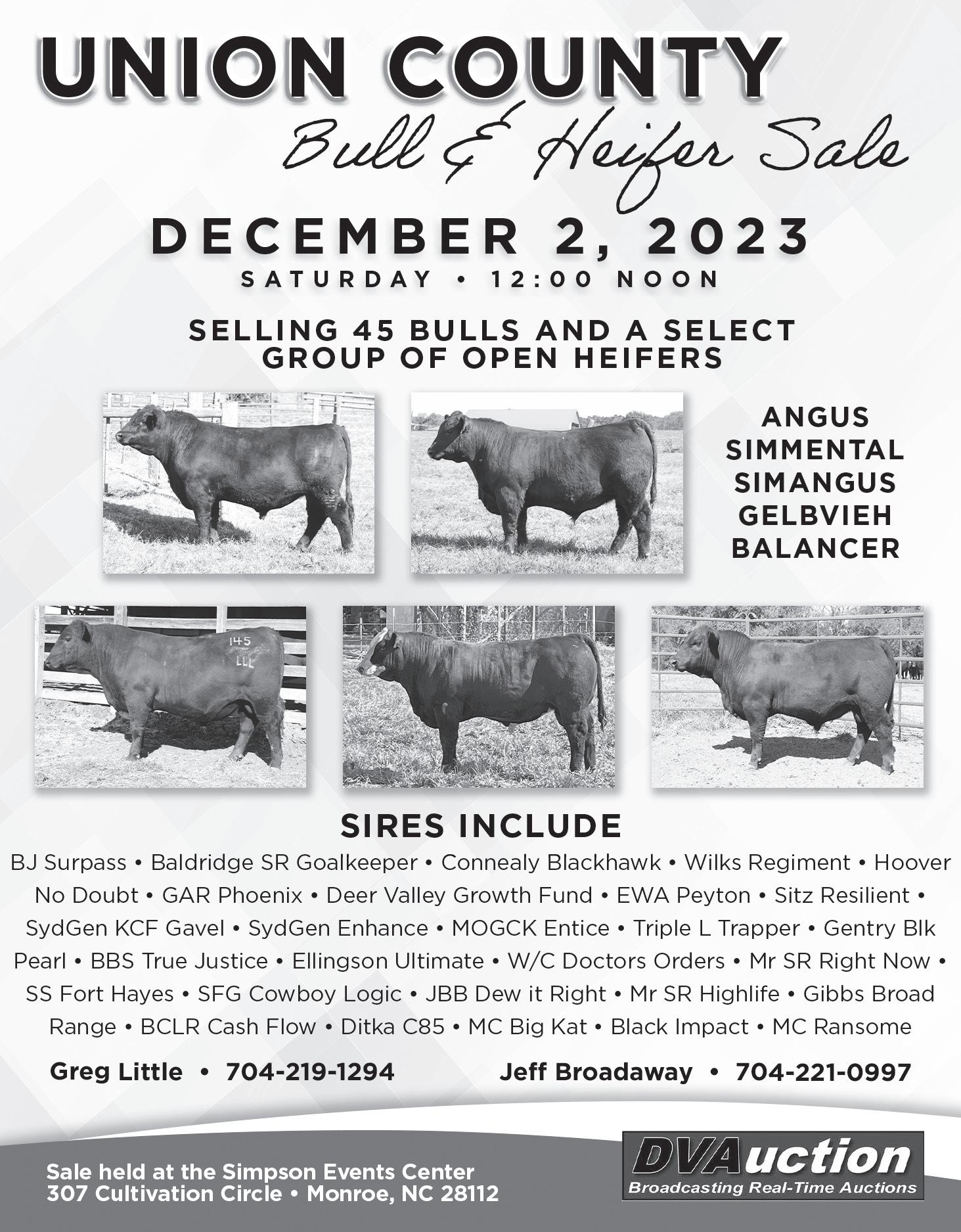
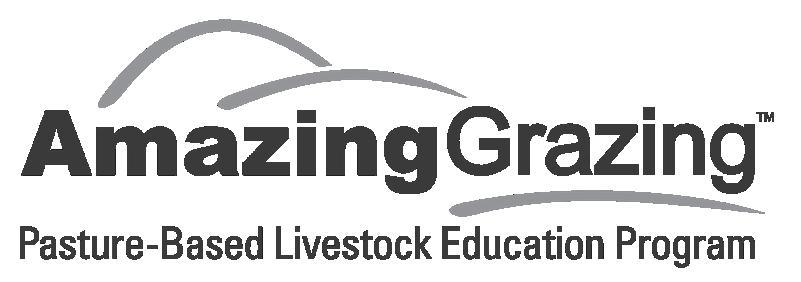
experts in soil health, veterinary entomology, forage agronomy, water quality, etc. All these important aspects of pastureland ecology should be considered in management plans because they are integrated into the system we know.
My colleague Wes Watson first got me interested in dung beetles in the 1990s. I had seen them on nature shows, almost exclusively the “roller” type that makes a ball of manure and rolls it across the pasture to be buried. These shows were typically filmed in Africa, and I never realized that dung beetles are actually found all over the planet, wherever there are animals and the associated piles of poop. My dad once met a field scientist in Alaska who had spent his entire career studying dung beetles specialized to use bear feces!
Once we started talking about dung beetles with Wes, I showed my ignorance and indicated that I didn’t think we had any on our farm. After he showed me how to look for them, I went home and found they were everywhere I looked. I can’t believe they were there all that time, and I never knew it. As our conversations continued, we decided to study them more deeply.
Wes recruited a graduate student, Matt Bertone, to work on improving our understanding of dung beetles in our region. Matt did trapping studies in the Piedmont and Coastal Plain of North Carolina and also did work to show how manure nutrients were transported from the cow pie down into the soil profile.
Through this work, I started learning more about dung beetle ecology. There are three major categories of dung beetles, including: 1) tunnelers, 2) dwellers, and 3) rollers. Tunnelers burrow under the cow pie for several days, where they create brood chambers, which they then pack with manure and eggs. The tunnels may be up to 18 inches deep and are critical to the aeration and water infiltration capability of the soil. The Dwellers stay in the cow pie most of the time and lay their eggs either in the cow pie or in the soil immediately underneath. A large population of dwellers can literally shred a cow pie or pile of horse manure in less than 24 hours. Finally, the Rollers make a ball of manure, which they roll away from the cow pie before burying it with their eggs.
Dung beetles are very beneficial because they increase soil aeration, improve water infiltration, destroy fly and worm habitat, and incorporate manure nutrients deep in the soil. An added benefit shown in recent research at NCSU is that they actually reduce the production of greenhouse gasses associated with the breakdown of feces and urine in the soil.
In Matt Bertone’s trapping studies, we identified 28 species in the Coastal Plain and 14 species in the central Piedmont. At all locations, the vast majority of beetles we found were of the tunneler “Onthophagus taurus.” The dweller “ Labarus pseudolividus ” was the second most common. About 70 percent of the total beetles trapped were O. taurus, and 15 percent were L. pseudolividus . This is consistent with my observations since that time; we see many species, but it seems that the most common and abundant are these two. They both emerge in March and are active through November when the fly season is underway. Both of these species were unintentionally introduced from Europe and have now spread across much of the United States. Onthophagus taurus was first found in the United States in Florida

in 1971. Since that time, it has spread over a wide geographic region.
Of course, there are also many other insects that are attracted to fresh cow pies; many of them are important in dung breakdown, like the beetles, and some of them are pests, including face and horn flies. An active population of dung beetles and other dung dependent insects can reduce fly populations through competition for food resources and destruction of the habitat needed for fly larvae development.
We recently did a series of eight “Amazing Grazing” workshops across the state of North Carolina. At each of these, we discussed dung beetles, and participants were able to see large numbers, especially the O. taurus and L. pseudolividus . We also had a few Digitonthophagus gazella , Phanaeus vindex , Parataenius simulator, and Sphaeridium scarabaeoides . We discussed some fun facts about dung beetles, including how they were revered by the ancient Egyptians, how they were introduced into Australia, Hawaii, and other places where cattle had been imported but there were no dung beetles to degrade their manure, and how Onthophagus taurus is widely considered
PAGE 14 The Carolina Cattle Connection q OCTOBER 2023
Photo by Dr. Matt Bertone
to be the earth’s strongest animal pound for pound.
We had many questions about how to increase dung beetle populations. It is possible to purchase dung beetles at the current time, but they are expensive, and the legality of commercially moving insects across state lines without regulatory approval is questionable. The truth is that if your farm is a good dung beetle habitat, they are probably already there.
The first step in getting more dung beetles is to go to the pasture and look for dung beetles to make sure you don’t already have a lot. The best time to do this is when it is warm and moist in early summer. Look for fresh cow pies that have holes in the top and look to be

flattened and uneven on the surface. Slip a flat shovel under the cow pie, wait 30 seconds, and then turn it over. Dung beetles will have dug down to the surface of the shovel and will be obvious. You can also dunk the cow pie into a bucket of water and stir it up. Gradually, dung beetles will float to the surface and can be easily skimmed off.
If you disturb a cow pie and it appears that it has dead dung beetles in it, just wait a few seconds. Their normal behavior is to play dead to fool birds, and after a short time of being still, they will pop back to life and rapidly dig into the cow pie!
If you really don’t have any dung beetles, then it might be due to things you are doing to your cattle. It is all connected, and research has shown that compounds like ivermectin and other pesticides do reduce populations at least for a short time. If you infrequently use these inputs, they might not cause problems, but aggressive treatment for internal and external parasites undoubtedly reduces the populations of some of these species.

To reduce the impact, reduce the frequency at which you use the pesticides and don’t treat all animals at the same time. Unfortunately, it is probably true that the most effective internal and external parasite control programs probably also reduce dung beetle populations. Reserving these treatments for situations where they are really needed most will help. For example, deworming only young cattle but not mature cows can help keep worm populations under control while reducing the impact on dung beetles.
Using less toxic compounds
whenever you can will also help. An example of this would be to use a “white” dewormer (which is less persistent in manure) rather than an ivermectin type, which will remain in manure for up to a month. Also, using these compounds late in the season after most of the dung beetle activity slows down can also help. Don’t destroy their habitat if you can avoid it. We have known many cattlemen who drag pastures to scatter manure. This is recommended after winter feeding when there are many stacked up cow pies, but during the grazing season, let the biology do its work.
Fly control products in the mineral is also something to think about. Methoprene (the active ingredient in Altosid) is thought to only have a small impact on dung beetles, while diflubenzuron (the active ingredient in ClariFly) is thought to have a greater impact.
Products with a very long residual period need to be carefully considered. Once, there were ivermectin slow release boluses that payed out the compound all grazing season. These worked great on worms but did lead to severe decreases in dung beetle populations. Those

boluses are no longer on the market in the United States, but there are other “long acting” ivermectin family products that undoubtedly have the same impact.
Finally, recent research shows that toxic Kentucky-31 tall fescue results in a reduction in dung beetle breeding success compared to feces from cattle grazing novel endophyte tall fescue. Both O. taurus and D. gazella were less successful in KY-31 feces, and when given a choice, they preferred feces from cows fed novel endophyte tall fescue. This is yet another place where the toxins in KY-31 tall fescue play a destructive role in pastureland ecology. Conversion of KY-31 pastures into non-toxic forages would be very beneficial not only to the cattle but also to the other biology at play in your pastures.
Dung beetles are just one more reason to get interested in the ecology of your pastures. Once you find them and start thinking about how to improve your populations, you will be on the way to improving your pastures in general!
For more on dung beetles, go to our Amazing Grazing Resource page at www. go.ncsu.edu/amazinggrazingresources.
The Carolina Cattle Connection q OCTOBER 2023 PAGE 15
Figure 1. I – Tunnelers (A = P. vindex, B = O. taurus, C = C. minitus, D = Beetle digging tunnel) ; II – Dwellers (A = L. pseudolividus, B = A. erraticus) ; III – Rollers (A = Canthon pilularius, B = buried dung ball). (from Bertone et al., 2004).
Is there a problem? Regular copy deadline is OCTOBER 5 for the NOVEMBER issue!
E.B.'s ViEw from thE Cow PasturE
By E.B. HARRIS
You Cut All My Horns Off
Like I said in last month’s article, we had a good working relationship with Clifford Robertson. One year, probably in the early ‘70s, Clifford got a little short on feed. Jimmy and I made a deal with Clifford that we would winter his cows as we had plenty of silage and hay.

Clifford had his cows at the farm he owned in Liberia, the community just six miles north of our farm at the junction of
Hwy 58 and 43. I had known the cows for years and had been seeing them on this farm all my lifetime. These cows started from milk cows and bred from there on up into a beef herd like a lot of cattle in this county. We were going to bring the cows to our farm to winter them and charge him so much per head per day. He could pick them back up in the spring, or we would deliver them back to his farm.
I loaded the cows on a two ton truck with a 20’ long body and brought them down to our farm. We were going to put them with some of our cows and feed them the same as ours. After about a week of being together, they got pretty dominant with their horns.
It did not take me long to decide that I was going to change all of that. I brought the cows up to the barn. Some
of these cows had horns probably one foot to one and a half feet long. I took my daddy’s long handle Keystone dehorners and made mull heads out of them right quick.
They got along fine after the surgery. We put a cord around the head when we dehorned, kept them up for a day or two, made sure everything was good, and then turned them back out. They had a
22nd ANNUAL E.B. & SHANE HARRIS INFLUENCE FEMALE & BULL SALE



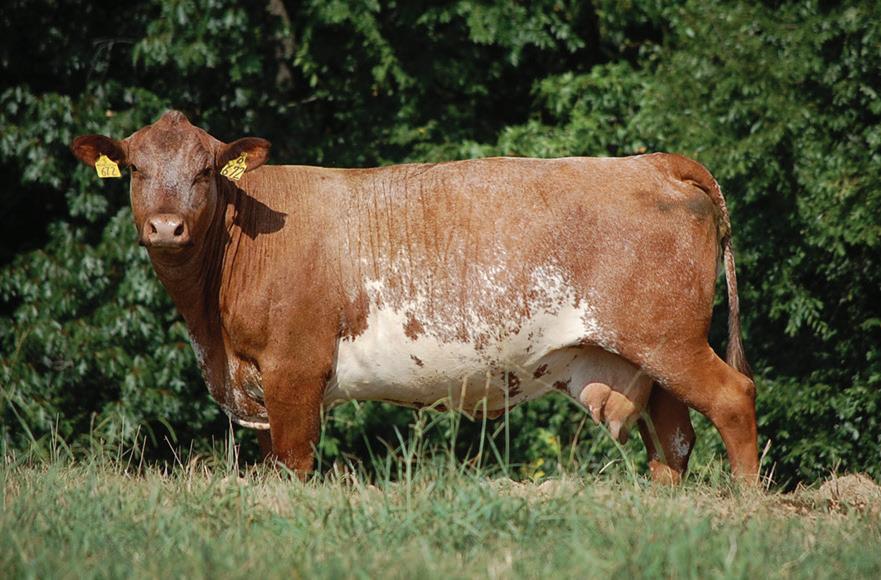
All forage based cattle • Fall and winter calving • All cattle EID
This is a sale with a readily available guarantee service year after year. Longest continuing commercial sale in the country and it continues. Buyer has option to sell first year offspring back to E.B. and Shane with a $50 premium on heifers and a $25 premium on steers.
• 17 First Calf Heifers with October Calf at Side - Angus, BWF, Simmental X, and Santa Gertrudis - all bred to Angus CE bulls
• 46 Fall & Winter Calving Angus Based Bred Heifers - all bred to Angus or Wagyu bulls
• 38 ‘16 Model Proven Commercial Matrons Coming with 6th Calf - consists of Angus, SimAngus, Santa Gertrudis X, and Profit or Prestige - the highest percentage body weight weaned for percentage of cow weight that we own - all bred to Angus bulls
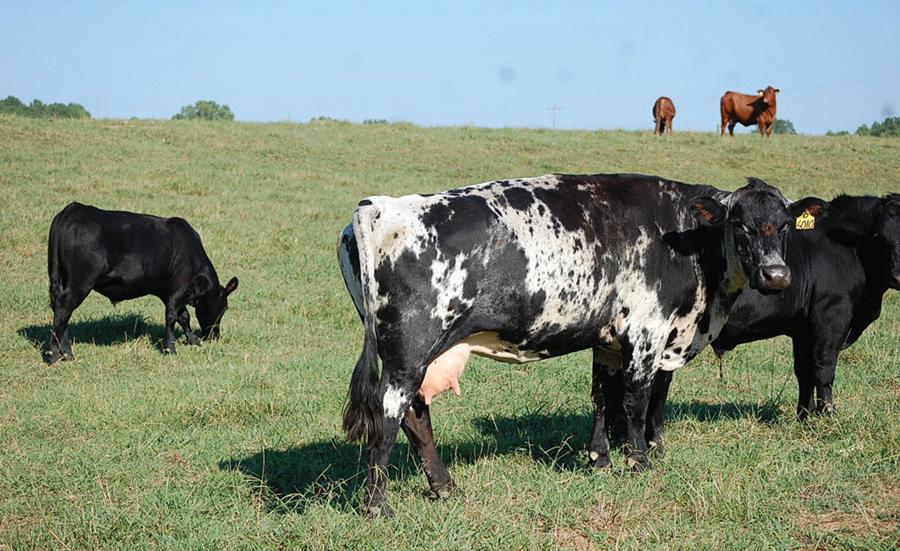
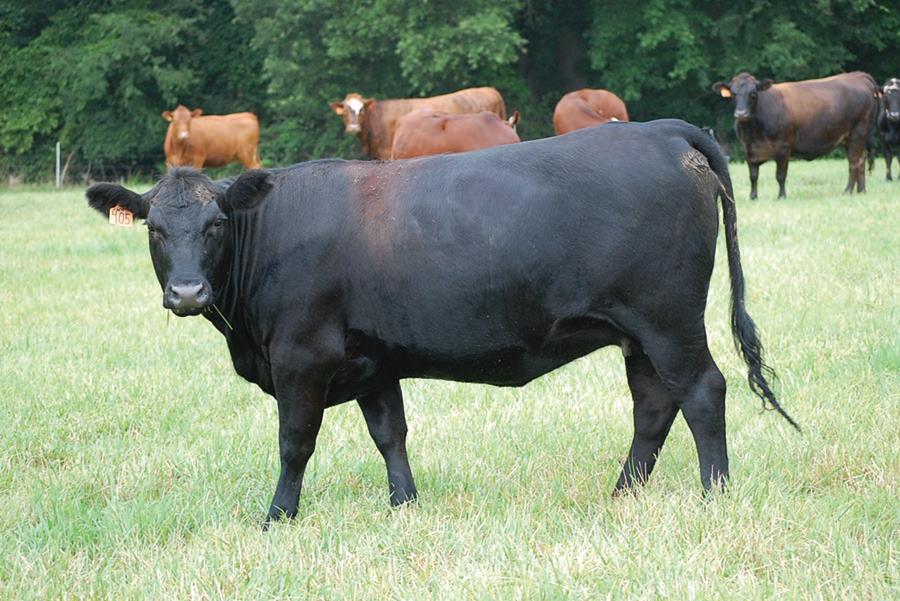
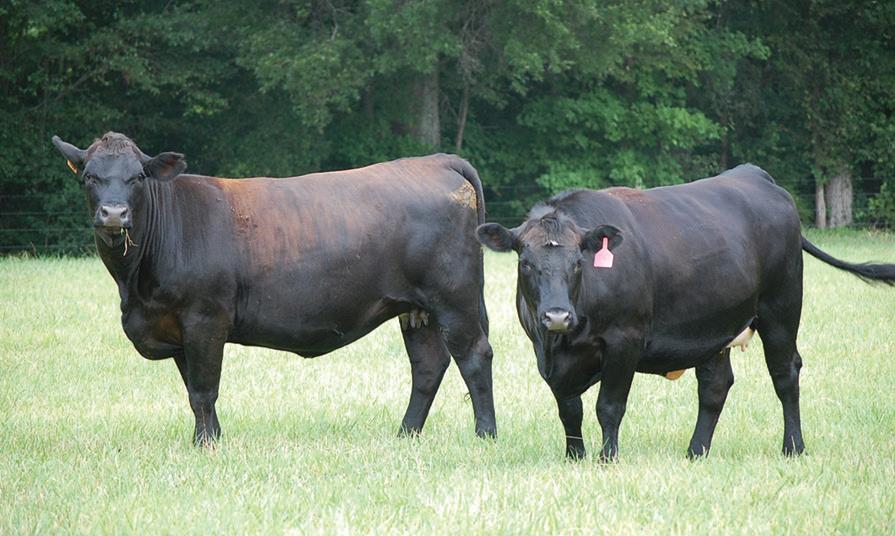
* All mature cows and heifers to start calving the week after the sale *
• 10 ½ Blood Wagyu Open Heifers - FIRST TIME EVER!
• 2 11-Month-Old Commercial Bulls - Purebred Angus and Angus X
• 3 4-5½-Month-Old Jacks

The sale will be held at the Granville Livestock Arena
4200 Cannady Mill Rd • Oxford, N.C.
Directions: From I-85, take Exit 204, go south on Hwy. 96 for 1.1 mile, turn left on Fairport Rd., go 2.4 miles, right on Cannady Mill Rd., sale ¼ mile on left at Granville County Livestock Arena. Also from jct. of Hwy. 96 & 56 at Wilton, take Hwy. 96 north 2 miles, turn right on Cannady Mill Rd., arena approximately 6 miles on right. Watch for cattle auction arrows leading way to sale.
For more information, call E.B or Shane 252-257-2140 • 252-430-9595 • 919-497-7990 or visit www.ebharris.com for live online bidding NCAL 1468
PAGE 16 The Carolina Cattle Connection q OCTOBER 2023
•
• OXFORD, NC 120 HEAD All Cattle Sell With a Guarantee the Buyer Will Like!
NOVEMBER 11, 2023
10:00 AM
completely new attitude toward my cows. Everybody kind of comingled and got along fine. There was no horn hooking, scaring up my cows. Everybody got around the feed bunks and hay rings at the same time with ease.
Springtime came, and Clifford called and said his grass had put out, and he was ready for his cows. He came down to the farm. We had his cows in the barn. He looked at them and turned to me, and said, “You cut all my horns off.” I said,
“Clifford, we could not have all those cows down here hooking my cows. They were dominant over the hay ring. They were going to put my cows on a diet if they stayed out there with those horns.”
I could tell he did not really like it, but he accepted it. We got together on the settlement, and I delivered the cows back to his farm. You never can tell – maybe you need to have an understanding before having a misunderstanding about taking horns off cows.

corral
By CRYSTAL BOWERS Chaplain, Cowboys for Christ
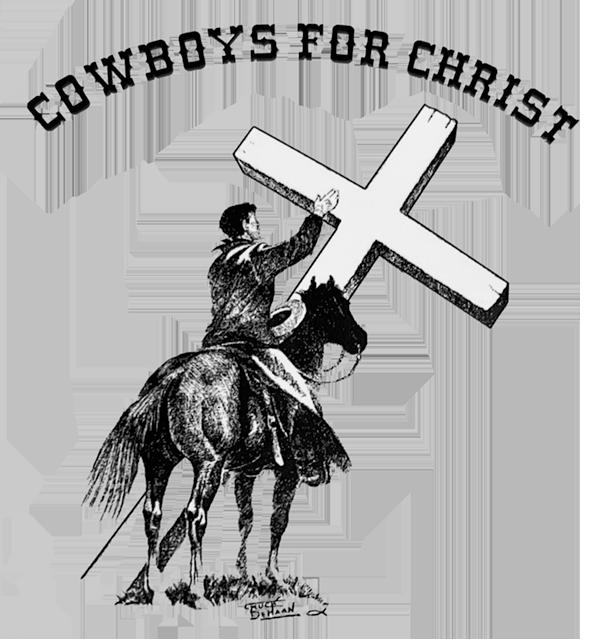
Extreme Mustang Makeover
Lowell Amerine and I had the joy and privilege of representing Cowboys for Christ of Tennessee by sharing God’s love and the Gospel at the Extreme Mustang Makeover in Franklin, Tenn., on June 22-24. We had wonderful, deep scriptural conversations. People were prayed with, saved, and felt Jesus’s presence. They received free literature, Bibles, “Jesus loves you” bracelets, key chains, etc. This was my first time at an Extreme Mustang Makeover. The correlation between the mustang’s life changes and our life changes in Christ was incredible!
Just 100 days before the event, these feral mustangs lived wild. They were the prey and part of a herd. They survived under a pecking order with a lifestyle of kicking, biting, pawing, bullying, and running away in fear. They ran free, grazing on grass and shrubbery. Upon meeting their trainer, the life they knew no longer exists, as all the rules changed. They were no longer hunted, bullied, treated with anger or revenge, had to run for their lives, or have to forage for food, water, and safety. The trainer provided them with all that they needed and more: a good, healthy variety of food, clean water, extra comfortable shelter, and incessant loving kindness. The feral horse reacts with hostility at first, not understanding this new “world.” With consistency and patience, the trainer woos the “rebellious” mustang so the horse learns to trust his master or owner. The feral equine is served, spoken to gently, touched, fed,
nurtured, and cared for like he has never before experienced. The trainer builds a relationship of trust, so in the end, the horse entirely relies on and desires to be in the presence of his owner always.
At the Extreme Mustang Makeover, we witnessed feral mustangs who now entirely trust their masters and live in devotion to them, seeking to please them with their lives. There is mutual deep affection and respect. By surrendering and following his good master, the mustang
is able to do things he’s never imagined or knew how to do before. Now his life is based on love, not fear (1 John 4:18) For example, one mustang was trained and obeyed without wearing a bridle. He was calm and obedient while he had flags flapping above his head, walked on a plastic sheet not knowing what was beneath it, heard loud cracking sounds of a whip on all sides of himself while laying down bowed down, sat down on a huge cushion, ran, then cantered and shifted leads because of a knee nudge from his rider, walked backward, did all four gaits, sidestepped, pulled a stuffed cow from behind, pushed a cart in front of himself, and much more. The transformation was completed within 100 days.
This resembles the life of a born again child of God. The Lord God Almighty adopts us, buys us, trains us, and we live lives that are beyond our own ability because of the blood of Jesus, the word of God, and the indwelling Holy Spirit. Lord Jesus Christ woos us to repentance with His loving kindness (Romans 2:4-6 and Isaiah 1:18-20). Lord Jesus’ gentle and humble heart teaches us, heals us, and gives us rest for our souls (Matthew 11:28-30) . When we surrender to the living God, He adopts us as His child. We become a new creation born of the Holy Spirit and the Word of God and are in the Kingdom of God (John 1:12-13, John 3:3, 5-8, 16-21, 1 Peter 1:23, 1 John 3:1-3, 2 Corinthians 5:17-21, Ezekiel 36:26-29, Jerimiah 31:33, and Ephesians 1-2)
Just like feral horses, we, as feral people, live on our own in any way we see fit in our own eyes. (Judges 21:25) But Lord Jesus Christ bought us with His blood on the cross, (1 Corinthians 6:19-20, 1 Peter
1:15-21) . Jesus sets us free from our old feral patterns of sin. (John 8:31,34-36, 58) Jesus says we are to live by “every word that proceeds from the mouth of God.” (Matthew 4:4, 2 Corinthians 10:3-6). We become filled with Jesus’ Love because He first loved us (1 John 4:19). Jesus tells us to abide in Him and that He’ll never leave us (John 15 and Hebrews 13:5-6). Out of gratitude for our relationship with the Lord Jesus Christ, for who He is and who we are to Him, we seek to please Jesus (2 Corinthians 5:6-10 and Colossians 3:22-23)
For me, my life is far beyond what I could have ever imagined! I live in Jesus’ peace, joy, hope, faith, forgiveness, wisdom, the Fruit of the Holy Spirit, and so much more! I am God’s handiwork (Ephesians 2:4-10). My life is a good adventure with Christ Jesus! Of course, it’s not perfect, but with Jesus, I am full and cared for.
God says in Romans 8:28 - “All things work together for good to those who love God, to those who are the called according to His purpose,” and in 1 Corinthians 2:9 - “Eye has not seen, nor ear heard, nor have entered into the heart of man The things which God has prepared for those who love Him.”
Such was shown in the Extreme Mustang Makeover, as it is seen in the true children of God, the followers of the Lord Jesus Christ. – Reader, Please remember we are always a work in progress. You will never see perfection in God’s people. But you will see it in our Lord, Savior, Redeemer, and Master Jesus Christ. Trust Jesus, only Jesus.
I close with these wise words from Lowell, “Tell someone every day that Jesus loves them.” Lord Jesus Christ loves you, dear reader!
“If you have cattle, pastureland, or raise hay like I do, you need to call Donna Byrum. In 10 minutes on the hood of my pickup, she signed me up for a program that I had no idea about. The next time she came by the farm, she brought me a check!
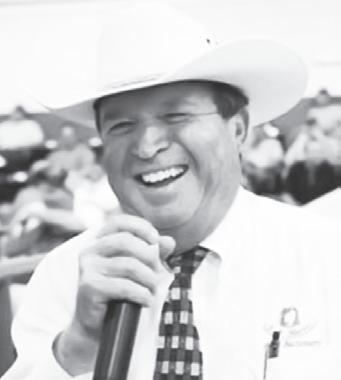
 ~ E.B. Harris
~ E.B. Harris
The Carolina Cattle Connection q OCTOBER 2023 PAGE 17
DONNA BYRUM First Choice Insurance 252-792-1189 • fcipllc@gmail.com For all your crop insurance needs! Visit us online at cattleandhay.net the chaplain’s
By CLAIRE FIELDS N.C. State University -- ANS 402 Beef Management
Necessary Cattle Handling Facilities for Small Farms
Arguably, one of the most important aspects to consider when improving efficiency on any cattle operation is your handling facilities. There are many details that should be considered when deciding which equipment will work best for each individual farm. For instance, management must take into consideration their farm’s goals in the industry, the budget that they may spend on equipment, and what will work best for their herd. Depending on which industry segment you may be in will also make a difference in what you need to include in your handling facility. Ultimately, handling facilities, even those on a smaller scale, are necessary as they allow for safe and easy management of the cattle while also protecting the people involved.

Having a well thought out handling facility can have many benefits for you and your cattle. For instance, creating an efficient and low stress environment for management will reduce the frequency of animal injuries and sickness as well as possible injuries to the people working with them (Troxel, Gadberry) . This handling equipment will be utilized by operation managers to complete tasks such as administering vaccinations, checking for pregnancy, and other important practices that go into a quality herd health program. After an operation considers what they need their work facilities to help them achieve, it is important to find a balance between the cost and safety of the equipment while also considering herd size (Parish, Vann) Luckily, there are many resources in the beef cattle industry, such as knowledgeable equipment manufacturers, local extension services, and veterinarians, that can help in designing and constructing a modern handling facility (Troxel, Gadberry) Obtaining the proper facilities and equipment for your farm’s specific needs will improve efficiency and ultimately save you time and money.
With smaller scale farms, a basic facility will be adequate, but it is critical that it is properly maintained. A basic handling facility consists of catch pen(s), a crowding pen, an alley, and a squeeze
chute with a head gate (Rhinehart) The number of catch pens will depend on the size of the herd, but for a small farm operator, two pens may suffice and will serve as a place to sort cattle that you intend to run through the chute (Rhinehart) . Figure 1 is a common example of a head catch system that can accommodate different sized cattle. The crowding pen will hold a few animals to eventually connect them to the alley in which they will be worked up to the squeeze chute and head gate. It is also important to consider how many times a year you will be running your cattle through the handling facilities, as this will help you determine the size and
quality of equipment needed. Table 1 lists example prices for equipment that may make up your facility based on different factors such as quality and the amount of labor required depending on the product. For around a 4,000 square foot working facility, it will likely cost between $900$2,100 to purchase materials just to fence the perimeter (Drover’s Admin) . It is possible to find equipment that may be cheaper depending on what and where you are making your purchase, but safety must always be the first consideration. You may also be able to use some resources that you have on hand. For example, you could use wood or metal fencing to build the alleyway to the chute.

Other things to consider in a basic handling facility are flooring types, environment, lighting, and positioning of equipment (Boyles et al.). Operators must decide whether to make their facilities indoors or outdoors while also considering proper flooring that will not cause the herd or staff to slip or fall. This may be an outdoor facility that is easily accessible from the pasture or you may choose to put it in a barn or covered area that may also connect to loading equipment. This would be most beneficial to the beef sectors that are
commonly loading and unloading cattle. The positioning of the crowding pen and alley is important due to a cattle’s tentative nature as a prey animal. As seen in Figure 2, a curved chute system is helpful because it blocks the cattle’s view of the squeeze chute until it is almost time to catch them, encouraging them to move forward (Boyles et al.). Maintaining a quiet environment and considering your animals’ flight zone when working them through your facilities is crucial to decrease stress for smooth handling. To determine the best place to put your handling facility, you must decide where it will be the safest and easiest for both the managers and the cattle.

Some other things a small beef cattle operation may want to obtain in their handling facilities are scales, slider gates, worktables, loading areas/ramps, and/or having a palpation cage (Parish, Vann) These possible additions may be utilized by smaller operations, especially for those that fall within the cow/calf sector of the beef industry or for any managers who regularly breed their cows. It is crucial to consider that there are many options with varying costs and utilities within each category of equipment that may be used in a farm’s handling facility. Decisions regarding these will ultimately depend on the specific needs and preferences of an operation. For example, Figure 3 shows a palpation cage attached to a hydraulic squeeze chute. Hydraulic chutes tend to be expensive; a smaller farm may choose a manual chute, which is just as reliable and a more accessible option.
Ultimately, investing in a quality handling system will allow small beef cattle operations to increase efficiency in many ways. Once you plan and obtain working facilities that satisfy the needs of the operation and the herd, it is key to maintain the equipment, when necessary, in order to maintain safety and capitalize. Remember that there are many things to
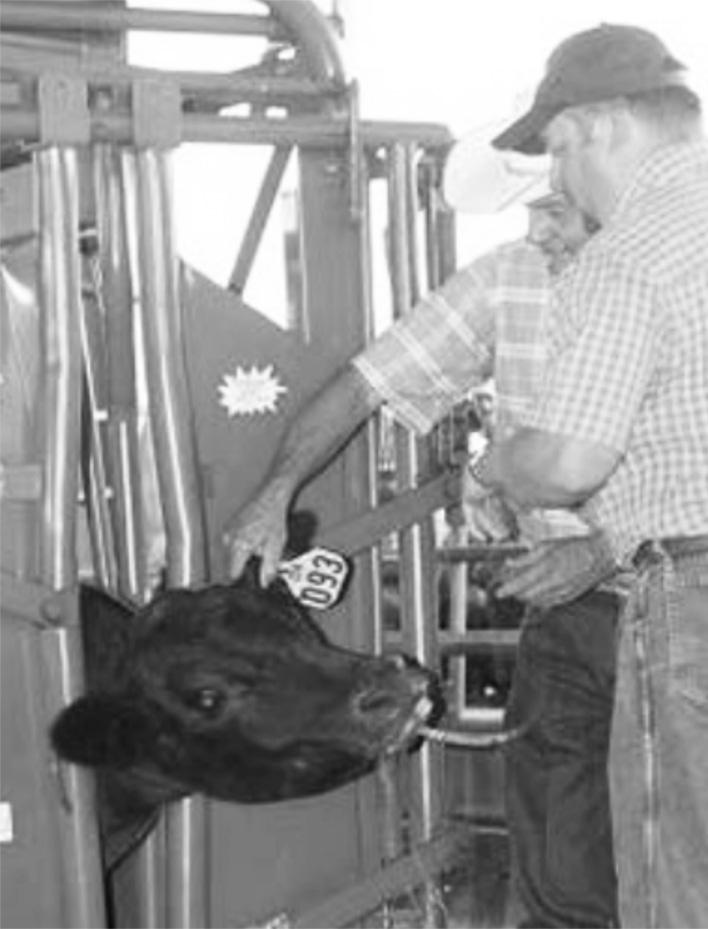
PAGE 18 The Carolina Cattle Connection q OCTOBER 2023
Table 1: Price examples and ranges of Handling Facility equipment.
Figure 2: Handling Facility example (Boyles et al.)
Figure 1: Head Gate system (Parish, Vann)
consider when tailoring your working system to your needs, but there are also many different options when it comes to the equipment you may invest in. The newest and most expensive equipment on the market is not necessary when you can build a basic facility on a budget that can heighten the success of your farm. In the end, having the right facilities is essential when it comes to safely and successfully managing a small beef cattle operation.
Regular copy deadline is OCTOBER 5 for the NOVEMBER issue
Spotlight material is due OCTOBER 1 for the NOVEMBER issue
References

Boyles, S., Fisher, J., Fike, G., DiCostanzo, A., & Lamb, C. “Facilities and Cattle Handling.” University of Minnesota Extension Service. www. agnr.osu.edu
Drovers Admin, 2017. Livestock Working Facilities: How Much Does it Cost? Drovers Newsletter. www.drovers.com

Parish, J.A., Karisch, B.B., & Vann, R.C. (2015) Beef Cattle Handling Facilities. Mississippi State University
Extension. www.extension.msstate.edu
Rhinehart, J. (2015) Even low input operations need at least basic handling facilities to load cattle for transport to market or to treat health issues. Drovers Farm Journal. www.drovers.com

Troxel, T.R., & Gadberry, S. (2019) Working Facilities and Handling Equipment. American Cattlemen. www. americancattlemen.com
Have You Herd Article written as a portion of ANS 402 Beef Management course requirement at N.C. State University Department of Animal Science under the instruction of Dr. Carrie Pickworth. The opinions of Claire Fields are not necessarily those of N.C. State University or Dr. Carrie Pickworth.
The Carolina Cattle Connection q OCTOBER 2023 PAGE 19
Figure 3: Palpation Cage (Parish, Vann)
You Decide!
By DR. MIKE WALDEN
William Neal Reynolds Distinguished Professor Emeritus N.C. State University
You Decide: Is There a Winner in the Debate Over Taxes? Few public policy issues create more debate than taxes. That’s because taxes are linked to several complementary issues that are also controversial. When you talk about taxes, you don’t get one debate; you get several debates. Among them are questions about fairness, income distribution, simplicity, economic growth, and funding of public programs.

North Carolina is an ideal state to examine questions about taxes. With the divided government we’ve frequently had at the state level in recent years — meaning the General Assembly is controlled by one party with the governor from the other party — debates about taxes are typical. So, let me delve into the multiple issues tied to taxes and let you make the decisions about winners and losers.
The debate over fairness in the tax system is one of the most contentious. The fairness issue is most readily seen in
the question about tax rates, especially tax rates on income. Should all households pay the same tax rate on a dollar of income, regardless of their total income?
Those who agree would call this a “flat” or “fair” tax rate. Or should households with more income pay a higher tax rate than those with lower income? Supporters call this a “progressive” tax system.
Currently, North Carolina has a flat personal income tax — meaning the same rate for all households regardless of their income. The federal government has a progressive income tax system, with higher tax rates applied to brackets of higher income. Of course, there’s a continuous discussion of the range of income brackets and the level of tax rates.


There’s a direct link between the question of tax rates and the issue of income distribution. Some advocate using the tax system as a way of redistributing income or transferring income from higher income households to lower income households. One simple way
of doing this is to tax the income of upper income households at higher rates and to tax the income of lower income households at lower rates.
Automatically, this makes higher income households pay more tax per dollar of income than lower income households. Advocates of spreading income more equally across households would applaud this tactic, while opponents counter that the tactic punishes accomplishment.
The question of simplicity in the tax system is part of the discussion about tax rates. But there’s more to the issue, mainly revolving around the idea of deductions. Deductions are offsets to income occurring when taxpayers spend their money a certain way.
For federal and North Carolina income taxes, all taxpaying households can take a standard deduction based on the number of people in the household. But most other deductions, both for businesses and households, are based on specific kinds of spending. One of the largest household deductions is for the
interest a homebuyer pays on a mortgage. Renters receive nothing comparable. Another example is the federal tax credit — worth more than a deduction — that buyers of electric vehicles can take.
These offsets to taxes have been questioned on two points. First, they complicate the tax system, often making taxes — especially income taxes — hard to understand. And if something is not easily understood, it can create attitudes that the system is manipulated to favor certain groups.
Second, the tax offsets can seem unfair since they only come with the catch that the household or business spends money in a certain way. The broader question is whether the government should be giving tax favors to people who make certain kinds of expenditures. But in response, supporters of the deductions and credits say they are justified if people are motivated to make expenditures that
Continued on page 22
S.C. CharolaiS NewS
By GEORGEANNE WEBB S.C. Charolais Association
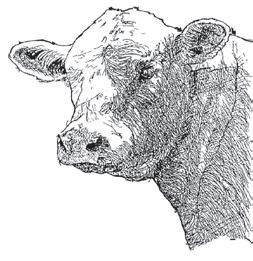
I have nothing but good news to report this month. First of all, I did something that I have never done before in my 71 years. A friend of mine, Gwen McPhail, wrote a book and had it published! She had a book signing, and I went, and no, the book was not about cattle. I have never personally known an author nor been to a book signing. We had mimosas and fancy finger food. It was my first time having a mimosa, so that day was packed full of a lot of firsts.
The next great news was I had invited Clint Rusk, the Executive Vice President of the AICA, to our sale on October 7. He called me the other night and told me he had booked his flight to Knoxville for the sale, so if you get this before the sale, be sure and show up to show him some Southern hospitality. No past executive vice president has ever come to our sale, so this will be another first.
I had already been told, but I didn’t say anything about our next good news until the people it was about contacted me. Well, Delores Templeton contacted me to let me know that they were notified that Wayne Templeton was nominated,
and the national Charolais show at the North American International Livestock Exposition in Louisville, Ken., will be dedicated to honor Wayne. Wayne Jr. and his wife Libby will attend on November 13 to accept the honor for him since Wayne is unable to travel due to his health. Congratulations Wayne!
Dr. John Dykers sent me an email with some good news to report. His farm manager’s son, Jackson Headen, headed to N.C. State University on August 17. He is focused on bringing all that education back to New Hope Farm to work with his daddy. Charolais are the backbone, but the exploding sheep herd will have John Will Headen hollering for him to help. Dr. Dykers is still having fun with the group of yearling heifers in the pasture in front of his house. He picks up a bag of sweet feed, and they have quickly learned to come to snack where he can feed easily.
Now, just how nice is that story? I guess all my fussing has paid off. Now it is your turn to share some nice things happening in your family and farm.
See you at the Southern Connection Sale in Knoxville on October 7.
PAGE 20 The Carolina Cattle Connection q OCTOBER 2023
276-228-5024 Wytheville, Virginia 8 ft Concrete Feed Bunks U or J Bunks - $200 • Calf Bunks - $150 Water Troughs • Pads • Silo Sides Septic Tanks • Reservoirs
West End Precast

The Carolina Cattle Connection q OCTOBER 2023 PAGE 21
help broader public purposes.
Economists have long recognized that taxes can impact the economic activities of both businesses and households. Taxes can hinder the economy by taking away funds that could be used for business expansion, investment in the private sector, or simply personal spending that can make households happy. If tax rates are very high, they can also reduce the motivation for a person to work or a business to expand.
Yet, at the same time, taxes are needed to fund the functions of government, such as public safety, transportation, and international protection provided by the military and the court system. There can be a healthy debate about the degree of need for these functions, but collecting tax revenues is the only alternative to borrowing if some level of government programs is to be provided.
Interestingly, economic research has long shown that higher tax rates are not necessarily the way to provide
more funding for government programs. Research by some economists has shown that raising tax rates may deter enough work and investment to result in lower tax revenues. Reducing tax rates may do the opposite — encourage enough additional work and investment so as to increase growth in the economy and generate larger tax revenues. There are ongoing efforts by researchers to find the best tax rate that provides the most tax revenue.
Taxes are both controversial and complicated. Hopefully, I’ve exposed and explained the areas of disagreement. And since I’ve addressed many issues, I’ve left you with multiple “you decides”!
You Decide: Is Higher Education
Facing a Reset? I spent all of my professional career – totaling 43 years –in higher education. When I joined the faculty of N.C. State University in 1978, colleges and universities were expanding. Enrollment was rising, programs were growing, and faculty positions were being added. One of the biggest challenges for academic departments was deciding what types of specializations to recruit for the
new hires.
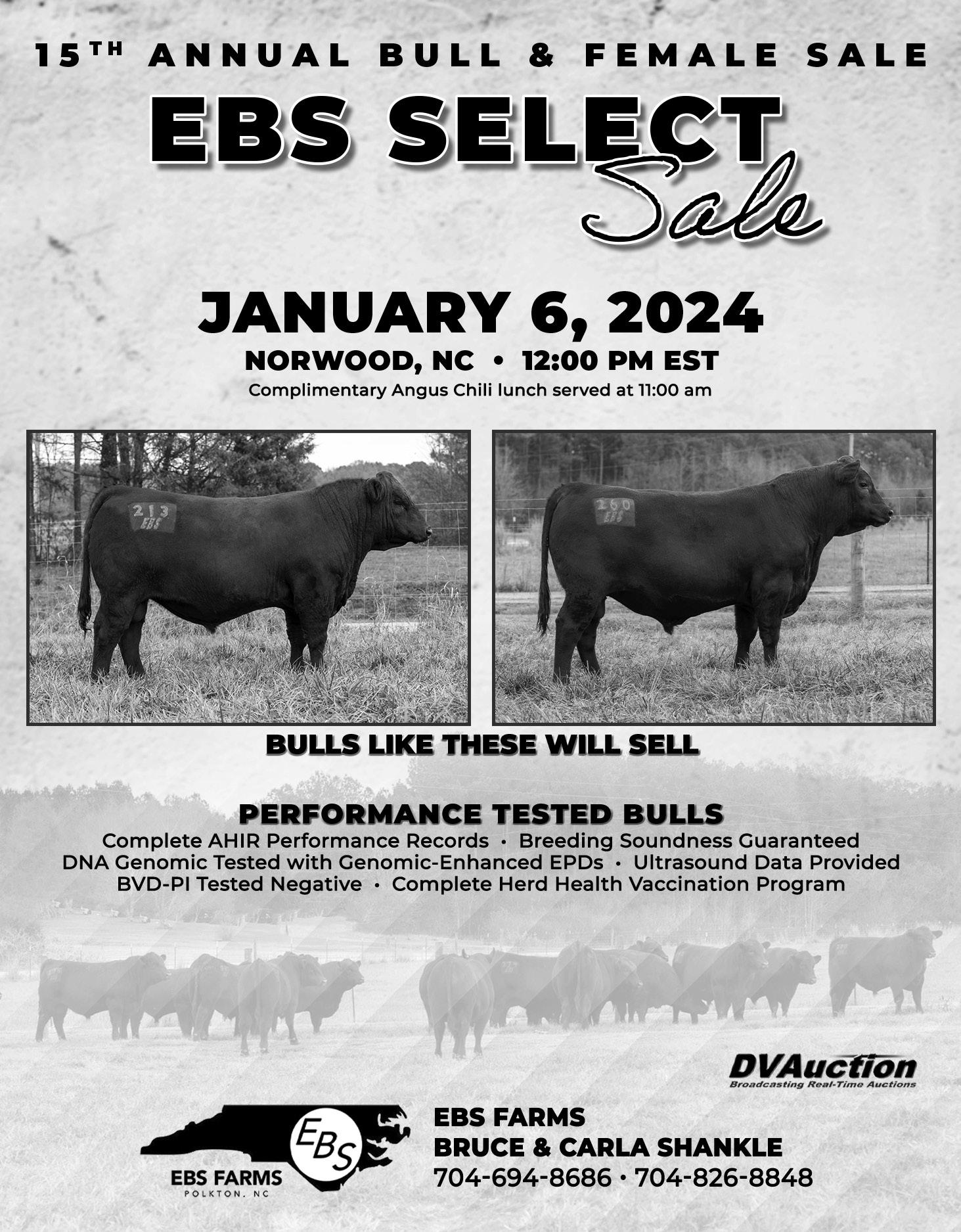
The recent news about West Virginia University (WVU) couldn’t present more of a contrast. WVU, the largest university in West Virginia, announced enrollment declines are forcing a 16 percent cut in faculty and the elimination of 32 programs. These changes to a well respected institution in operation since 1867 sent shock waves throughout higher education nationwide. While most higher education institutions are not currently sharing WVU’s plight, there are worries they may in the near future.
A look at enrollment trends at fouryear colleges and universities in the nation is causing worry. From 1970 to 2010, which some call the “golden age” of higher education, enrollment in higher education jumped 100 percent. However, enrollment growth from 2010 to 2030 is expected to be only 9 percent. After 2030, projections show nationwide college enrollment falling, just as has happened in West Virginia. This trend has been dubbed the “enrollment cliff.”
There are other issues facing higher education. A big one is cost. Annual tuition and fees for the school year 202223 at public four year institutions are over two times higher than 30 years earlier in 1992-93. This is after adjusting for general inflation, meaning the dollars have the same purchasing power in both time periods. For private four year institutions, the increase was slightly lower, at 1.8 times higher than in 1992-93.
A second issue is the financial return from a higher education degree. Traditionally, jobs requiring a college degree paid much more than other jobs, thereby making the expense of a college education worthwhile. A recent study from the Federal Reserve Bank of St. Louis confirms this is still the case. If paying for a college education is thought of as an investment, the study shows the annual interest rate earned is in the double digits.
Yet, there are important exceptions to this generalization. The national dropout rate for enrolled college students is 40 percent. Research shows college dropouts actually earn less than high school graduates. Also, almost 60 percent of college students take more than four years to graduate, thereby increasing their total costs and reducing the net benefits from the degree. Lastly, the investment returns from a college degree vary significantly by the student’s degree major.
There are significant regional differences in these issues facing higher education. While several analyses predict
college enrollment will begin to dip in North Carolina before the end of the current decade, the drop will be less than in many other states.
College costs also vary among states. Student expenses at public universities in North Carolina are more affordable than elsewhere. North Carolina public universities have the 8th lowest tuition and fees among all states. The UNC System also has better results for student completion than comparable institutions.
Nevertheless, the conclusion is that higher education – including in North Carolina - will face important challenges in the future, including challenges that could significantly change how they operate.
Consider enrollment. If colleges and universities find their traditional base of 18-24-year-olds shrinking or even just slowing in growth, they could increase their focus on older age groups. In fact, with the labor market and occupations expected to radically change in the future as technology continues to develop and expand, there will likely be a need to retrain and reskill a significant percentage of existing workers. Colleges and universities could develop programs to address this need. We could see the college and university of the future teaching a very different age demographic.
To control costs, higher education institutions will be under increased pressure to evaluate programs and services on a cost/benefit basis and make some very hard decisions about generating savings. Based on my experience as a faculty member over seven different decades, I know most faculty strongly believe their work is essential. I don’t envy those administrators and leaders who may have to make decisions like those at West Virginia University.
While academics are usually rated on their teaching and publishing, academic advising of students is often under appreciated. It shouldn’t be. Advising is the link between the student’s academic work and their future occupation. The role of the adviser is to align the student’s interests with the reality of the kinds of occupations they can pursue. Improved and expanded academic advising can both reduce the time needed for students to graduate as well as be a guide for students to jobs they understand and expect.
In short, higher education may be facing a reset. While I won’t be there to participate, I, like you, will decide if it’s successful.
PAGE 22 The Carolina Cattle Connection q OCTOBER 2023
You Decide! continued from page 20
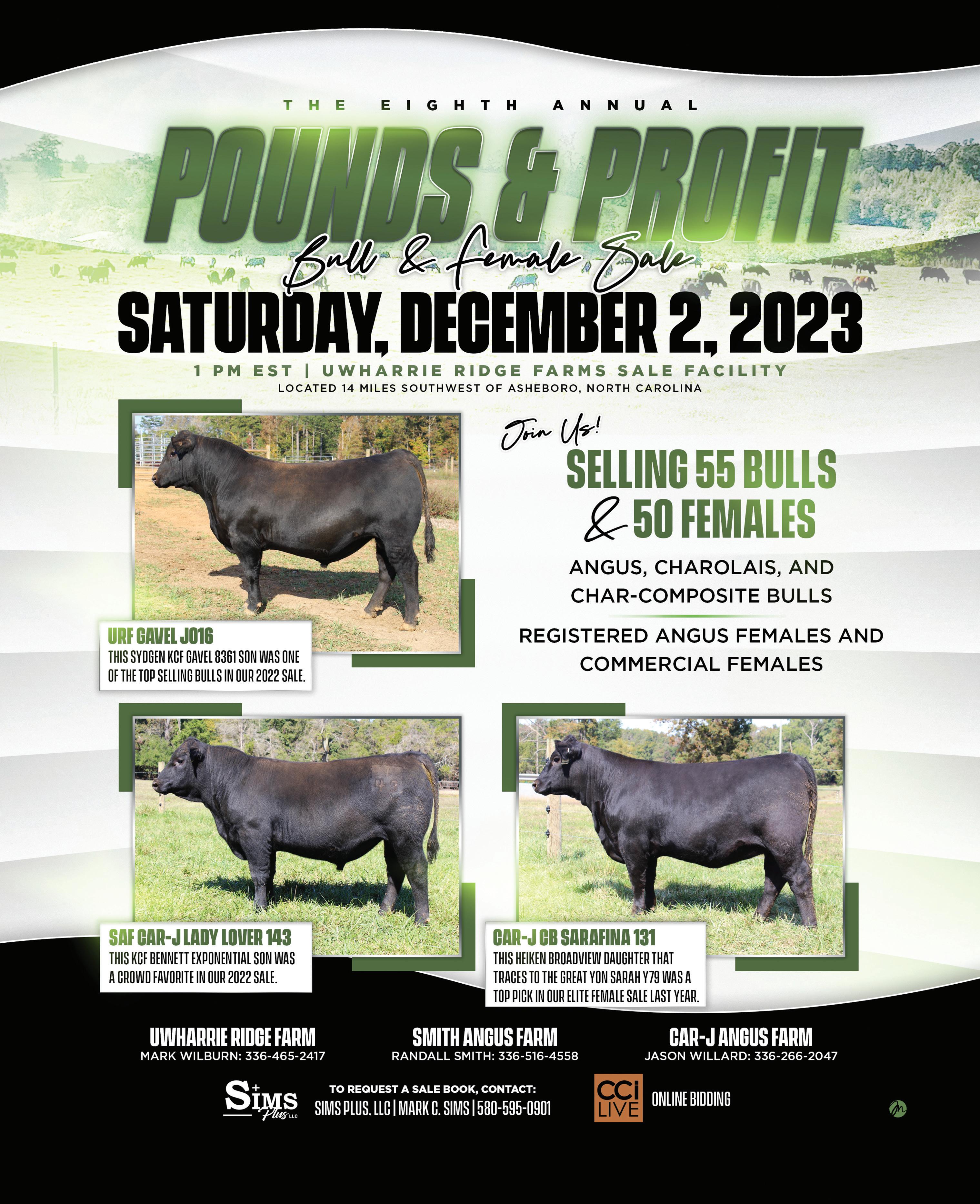
The Carolina Cattle Connection q OCTOBER 2023 PAGE 23
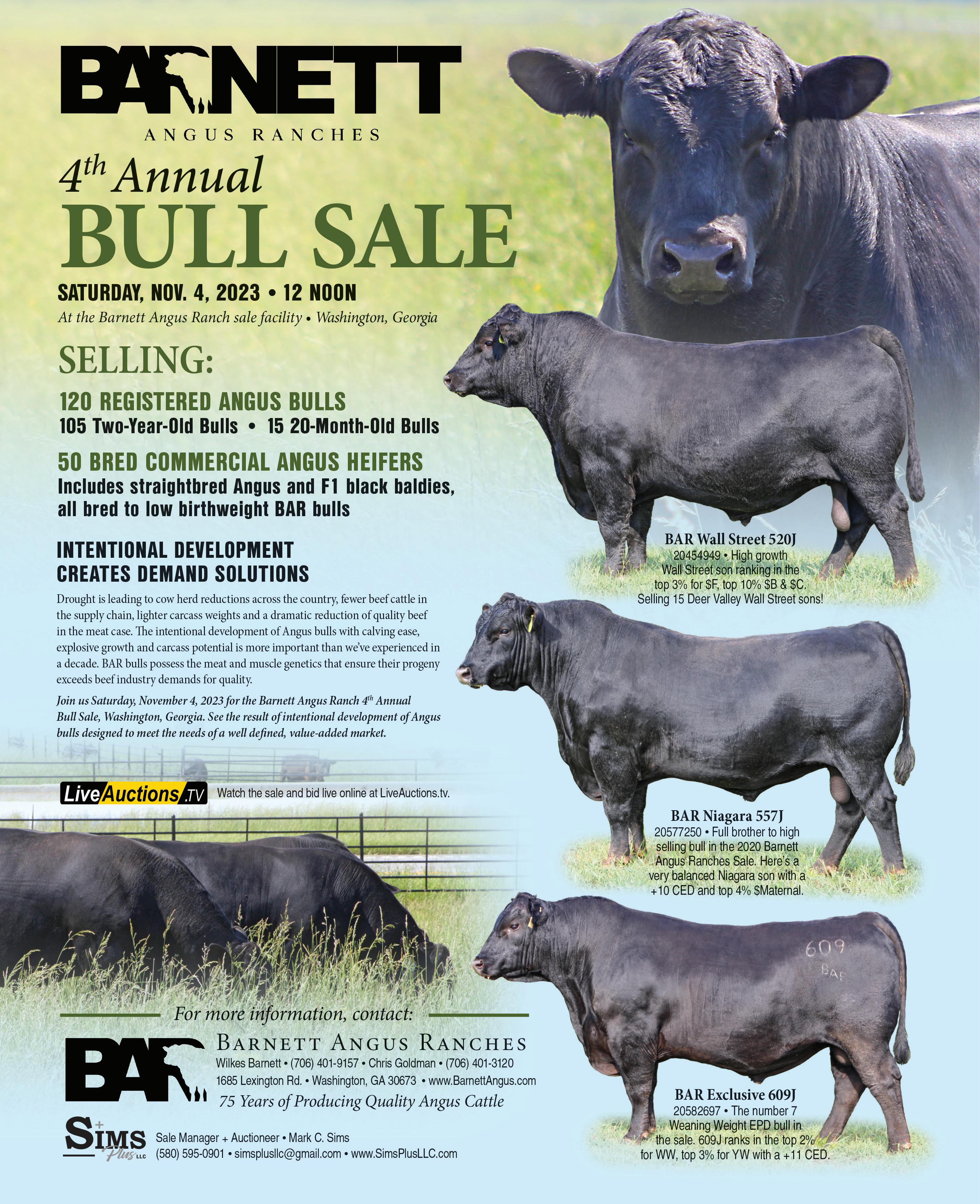
PAGE 24 The Carolina Cattle Connection q OCTOBER 2023

The Carolina Cattle Connection q OCTOBER 2023 PAGE 25

PAGE 26 The Carolina Cattle Connection q OCTOBER 2023
Certified Angus Beef news

The 2023 Colvin Scholarship Fund Awards Future Beef Leaders. The Colvin Scholarship Fund supports the next generation of leaders in agriculture who are devoting their studies and careers to making the beef industry better. This year, 23 students were awarded $81,500 through the Colvin Scholarship Fund.
Each recipient strives for a career in production agriculture, industry research, or an agricultural pursuit that influences the beef business. The students recognized for this scholarship are carrying the legacy of the Certified Angus Beef (CAB) brand’s co-founder and executive director for 22 years, Louis “Mick” Colvin.
The 24-year-old fund has now reached 144 students with $500,000 in scholarships.
The recipients recognized are impact leaders who have a strong commitment and passion for the beef industry.
“We are so impressed by them because they have shown a true, servant leadership heart,” Danielle Matter says, CAB director of brand experience and education. “They will be the industry’s next movers and shakers by impacting on many tiers from agricultural communication to meat science to production agriculture. And we get to support it all.”
The top recipients in each category were awarded $7,500 with additional scholarships recognizing educational merit and community involvement for production agriculture undergraduate and graduate students.
James Ulmer of Clemson University received a $2,000 undergraduate award.
Top award winners receive an all expense paid trip to the CAB Annual Conference. Recipients get the opportunity to network with leaders in the beef industry and share their story.
The largest fundraisers for this fund are auctions and a golf tournament held at the brand’s Annual Conference in September. Generous donation efforts from partners help the brand’s growing contributions to the Colvin Scholarship Fund.
“This is all credited to our partners and committee members,” Matter says. “It’s humbling to see how everyone involved chose this to be near and dear to their hearts.”
Tim Hussman, a Colvin Scholarship
Fund committee member, was the first full time employee that Colvin hired at the brand. After retiring in 2018 as president of the specialty meat division for Sysco, he now serves on the Colvin Scholarship Fund selection committee.
Hussman shares his excitement for the positive influence this fund has on the next generation of beef industry leaders.
“In the spirit of Mick Colvin, I hope this scholarship continues to grow,” he says. “I think this is just the beginning, and we were really excited to see the level of talent and interest. The more we can grow, the more interested students can benefit from the scholarship. I’m happy to give back and bring more young people into the industry.”
Steve Hunt Honored with the 2023 Industry Achievement Award. Hunt’s visionary leadership of U.S. Premium Beef was recognized at Feeding Quality Forum. When the cattle industry needed a leader, Steve Hunt stepped up.
Sure, it was a group effort to launch U.S. Premium Beef (USPB) – ranchers, cattle feeders, and allied industry – but they all say one man made the difference between success and failure.
USPB board member Jerry Bohn calls Hunt “a leader, an innovator, an entrepreneur, an idea guy, and an executer.” All of that and more made Hunt shine. He was honored on August 22 with the Certified Angus Beef 2023 Industry Achievement Award, presented at the Feeding Quality Forum event.
The beef industry was in trouble in the 1980s and ‘90s when more than 400,000 ranchers exited. Choice and Prime were no more than 55 percent of fed cattle production, so “it was a coin toss whether a steak was going to be good or bad,” says Randy Blach, CattleFax CEO. “Beef demand was cut in half from 1979-1998. The industry was like a buoy in the ocean, directionless.”
Fear of irrelevance had sparked conversations among a group of 21 cow/ calf producers in 1995. Always with economics in mind, Hunt says he saw an opportunity to integrate from the bottom up.
First need — value based pricing to pay on individual carcass merit. Second,
Continued on the next page
North Carolina Angus Association
ANGUS MEANS BUSINESS
Backed by the world’s largest and most reliable genetic evaluation program.
Registered Angus genetics deliver better calving ease, more growth, and superior marbling.

455 GORE FAMILY ANGUS Mark & Lori Gore Tabor City
702-401-8005 • 455goreangus@gmail.com www.455farms.com
4K FARMS/TARHEEL ANGUS Richard D. Kirkman, DVM Siler City 919-742-5500 • rdk.cefa@gmail.com
BACK CREEK Joe & Robin Hampton Mt. Ulla
704-880-2488 (Joe); 704-880-3572 (Robin) robinbackcreek@att.net
Facebook: Back Creek Angus
BILTMORE ESTATE Kyle Mayberry - Manager Asheville
828-768-1956 • livestock@biltmore.com www.biltmorelivestock.com
CARSON FAMILY FARM, LLC John, Callie, Isaac & J.R. Carson Laurel Springs 336-818-9087 • carsonfamilyfarm@gmail.com
CHAPMAN CATTLE COMPANY Bryant Chapman Taylorsville 828-514-0526
FOUR S FARMS
Kim & Connie and Jason & Robin Starnes Luther Lyerly - Manager Salisbury
704-640-5875 • kim-4sfarms@carolina.rr.com
GENTRY HOMEPLACE ANGUS Howard & Donna Gentry King 336-413-6698 • whgentry@windstream.net
GRAGG FARMS
Paul, Chris & David Gragg Boone 828-268-4136 (Paul); 828-268-4137 (Chris) 828-268-4135 (David) gragg_farms@hotmail.com
H&H FARMS
Buddy & Jennifer Hamrick - Owners Bly Hamrick - Manager Boiling Springs 704-472-1912 • jennham@bellsouth.net
HI-LO FARMS, LLC William & Kate Reichert Fuquay-Varina 919-812-0435 • hilofarmsblackangus.gmail.com
Cortney Holshouser
NCAA Executive Secretary
919-796-2346
ncaa.sec@gmail.com
www.ncangus.org

HILL ANGUS FARM
Dr. Gary M. Hill Hendersonville 229-848-3695 • gmhill@uga.edu
JACK KNOB FARMS
Karl, Janet & Logan Gillespie Franklin 828-371-2220 • karl@jackknobfarms.com www.jackknobfarms.com
JENKINS ANGUS FARM
Jaime & Christy Jenkins Marshall 828-206-1345 • jenkinsangusfarm@gmail.com
KNOLL CREST FARM
The Bennett Family Red House, VA 434-376-3567 • knollcrestfarm@knollcrestfarm.com www.knollcrestfarm.com
LANE ANGUS
Roger & Bundy Lane Bundy Lane - Manager Gates 252-398-7705 (Bundy); 252-398-7719 (Miranda) 252-357-1279 (Office) bundylane@hughes.net; laneangusbeef@gmail.com www.laneangusbeef.com
PANTHER CREEK FARMS
John C. Smith, Jr. Pink Hill 252-526-1929 • johnsmith3982@embarqmail.com
S&J Farms
Steven & Julie Lung Nathan Lung - Manager Carthage 910-947-3414 • sandjfarms2013@gmail.com
SMITH CREEK ANGUS FARM
Marty & Lynne Rooker Norlina 252-213-1553 • mrooker@mrookerlaw.com
SPRINGFIELD ANGUS
Phil Goodson Louisburg 919-880-9062 • philgoodson2@gmail.com www.springfieldangus.com
TRIPLE LLL ANGUS
Greg Little Monroe 704-219-1294 • greg.little@atimetals.com
VANDEMARK ANGUS
Keaton & Janie Vandemark Spring Hope 252-885-0210 • keaton@vandemarkfarms.com
WINDY HILL FARMS, LLC
Michael A. Moss
Will Moss - Manager Ramseur 336-460-7451 • windyhillfarmsllc@gmail.com
WINSLOW GENETICS
Ben & Kathleen Winslow Halifax 252-578-5487 • bensbulls@gmail.com
WOOD ANGUS FARM, LLC

Russell Wood Willow Spring 919-275-4397 • rwood4400@gmail.com
www.woodangus.com
The Carolina Cattle Connection q OCTOBER 2023 PAGE 27
information back to producers from the packer to guide changes at the ranch and feedyard. Third, they needed to gain a direct influence on processing. The group embarked on what they called the “Blue Sky Tour” to share their vision with potential stakeholders.
“As you can imagine, a lot of eyes fogged over when we mentioned that we wanted to become a processor,” Hunt says. Trust was a major challenge.
“Steve would tell you he’s the worst salesman, but he’s very good at explaining the big concept and relating it to producers, too,” says Stan Linville,
current CEO of USPB. “He broke down barriers and effectively communicated with each partner what they had to do to make this idea work.”
Hesitancy often met the campaign to find nearly 500 cattlemen to purchase at least 100 shares at $55 apiece. That would secure 100 carcass hooks and payment on their individual merit. Perseverance paid.

“His confidence gave the rest of us confidence to buy in,” says Mark Gardiner, partner at Gardiner Angus Ranch and founding USPB member.
With nearly a million cattle lined up, Hunt and this rogue group of cattlemen
negotiated an opportunity to buy up to 50 percent ownership of the fourth largest beef processor in the United States.
Naturally, Hunt was named CEO.
“Steve was a bridge builder,” says Tracy Thomas, vice president of marketing for USPB. “He built relationships so that all segments would talk to each other. Everybody involved learned the quality of their cattle, what we were doing well, and what we needed to improve.”
“The biggest thing Steve did for producers was say, ‘Do what you do best: produce,’” says Linville. “And he let National Beef do what they do best, which was run the beef processing side.”
It was a journey to grow pounds efficiently while marbling also increased. While USPB members received feedback from the packer first, Hunt realized improvements in quality and opportunity for value based marketing were important for the whole industry.
“I like to say it was synergistic: when we incentivized quality cattle, the other processors did, too,” Gardiner says. “We egged them on to do the same thing to compete. That is what has changed the demand equation for beef cattle today.”
For 15 years, Hunt led USPB with its shareholders in mind as the company continued to grow and succeed. He oversaw USPB, becoming a majority owner and parent company of the packer and renamed it National Beef Packing Company in 2003. Then, in 2004, he restructured USPB into a limited liability company to allow for more market opportunities.
Hunt’s last mark as CEO was leading negotiations for USPB to sell the majority interest in the packing company to Leucadia National Corporation. This gave USPB members liquidity to pass along to the next generation while maintaining the value based pricing and information
transfer.
Some would look at the data to define success. Numbers like $730 million in premiums USPB members earned through 2022 by delivering more than 18.3 million cattle. Members who made the equity investment, plus associates who lease and deliver cattle, total 2,900 producers from 38 states.
The average grid premium the first year was barely $10 per head. In 2022, premiums averaged over $70 per head. USPB cattle have improved from just 45 percent Choice to an average of 88 percent Choice or higher today.
Value based marketing might have saved beef demand, Hunt says. “But the measure of success is looking at our members and seeing their sons and daughters in business with them.”
Certified Angus Beef Launches Direct-to-Consumer Program. Ranchers can leverage CAB logo to market beef directly to consumers. Could your freezer beef carry the Certified Angus Beef (CAB) brand logo? Perhaps. With the launch of a new program, Angus farmers and ranchers have the option to market their beef directly to consumers as CAB product.
Ranch to Table, a direct partnership program between CAB and cattle operations using Angus genetics, allows ranchers to use the brand’s trusted reputation for increased gain.
“Many Angus ranchers take a tremendous amount of pride when they see the Certified Angus Beef logo on product, whether in their local grocery store or on a restaurant menu,” says Kara Lee, director of producer engagement for CAB. “This is just another way for them to continue to have equity in the brand by being able to hang brand standards on those cattle that ultimately qualify.”
To participate in the Ranch to Table program, a producer’s cattle supply must incorporate registered Angus genetics,

PAGE 28 The Carolina Cattle Connection q OCTOBER 2023
Certified
Angus Beef News continued from the previous page
Our advertisers are “Champions” too. For expert A.I., superior genetics, the best in purebreds and outstanding farm supplies, check the Classifieds in this issue!
which may require American Angus Association active membership or proof of bull registrations. Producers must also be Beef Quality Assurance certified.
As with any CAB product, cattle must meet the brand’s live animal evaluation with a predominantly solid black hide. In addition, carcasses must meet CAB’s ten specifications.
“One of the beautiful things about the Ranch to Table program is that the end product itself is going to be just as consistent with the end product of other traditional CAB outlets,” Lee says. “So, we are not compromising on any of our brand standards.”
Typically, cattle move from a feedyard to a CAB licensed packing plant and then are distributed to the end user. With the Ranch to Table program, licensed producers are responsible for working with a processor and USDA grader to verify that brand specifications are met. A marketing plan is required for the application process, but upon being licensed, producers will have access to a tool kit and marketing resources to use in leveraging the brand’s quality.
“For some, direct-to-consumer beef merchandising is an expanded financial opportunity. Perhaps it’s the opportunity for the next generation to come back and join the family business,” Lee says. “A lot of members have years of carcass data that supports the quality of the cattle they are raising. Previously, we didn’t have an infrastructure that allowed them to access CAB brand merchandising, and the Ranch to Table initiative allows us to do just that.”
The program is not restrictive solely based on the quantity of cattle a producer would process. Instead, CAB will evaluate the business’ operating plans and marketing approach for the beef
produced.
“Ultimately, we’re looking to put an asset in the toolbox of registered Angus breeders — something that allows them to add value to their own product or to the calves they’re purchasing back from customers whose genetics tie to the breeder’s own operation,” says Lee.
Farmers and ranchers interested in becoming part of the Ranch to Table program should visit www.cabcattle.com/ ranch-to-table for more information or to begin the application process.
Who is Certified Angus Beef? At Certified Angus Beef, we know people want to put great meals on the table. Our employees work across the beef supply chain to ensure chefs and home cooks find and prepare the best Angus beef.
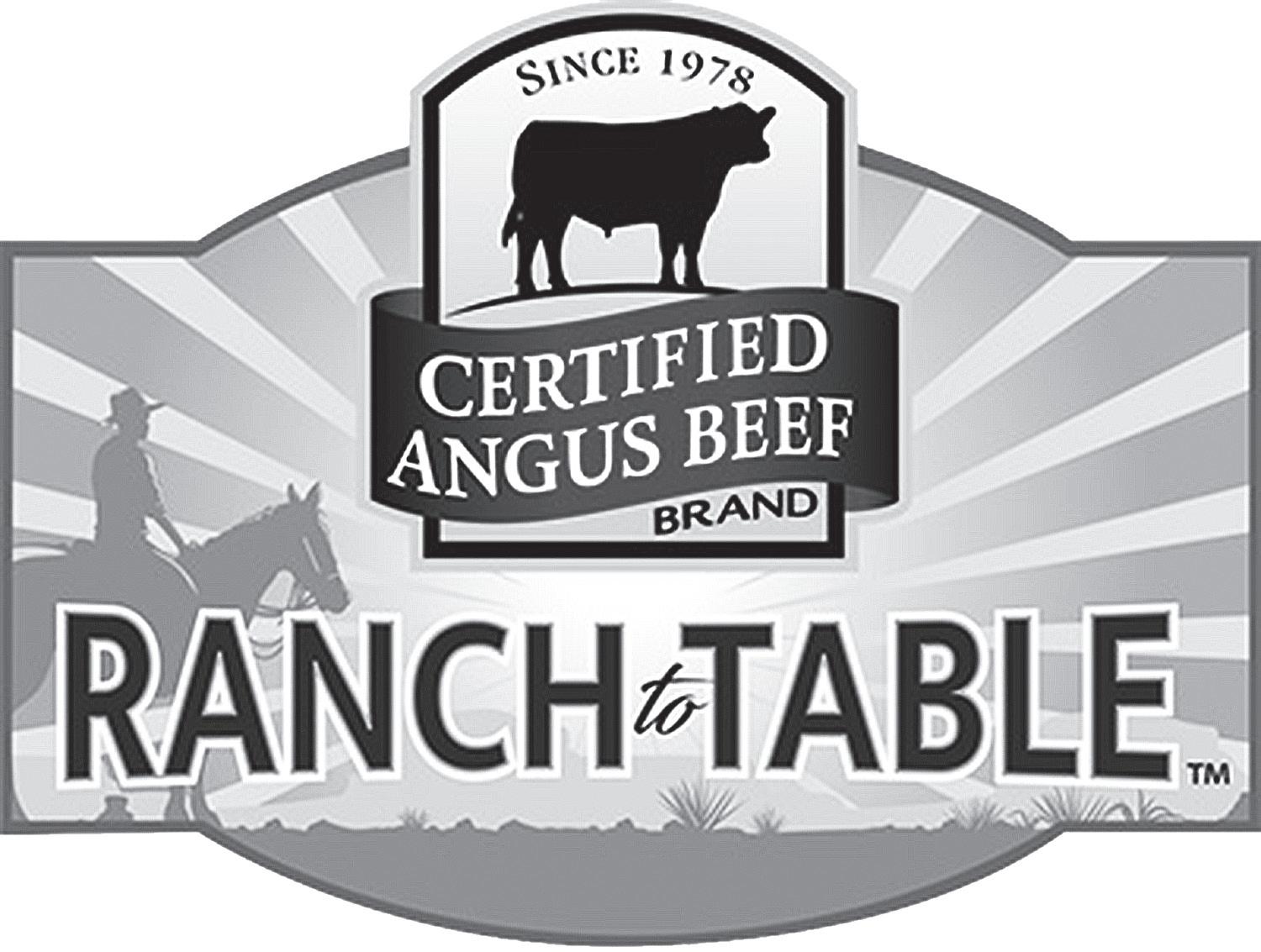
McMahan Farm & Hancock Angus
Annual Registered Angus Bull Sale

November 18, 2023 • 12:00 noon at the farm in Mocksville, N.C.

*All bulls will have passed a BSE exam before the sale* * Bulls are forage fed with little supplement*
Led by our culinary, beef, and marketing experts, our team provides consultation, marketing materials, training, market insights, and tools that help businesses
like grocery stores and restaurants thrive. Our team is also dedicated to sharing the story of family farmers and ranchers who supply the brand.
The Carolina Cattle Connection q OCTOBER 2023 PAGE 29
Sons from these A.I. sires: Black Hawk • Dual Threat • Tahoe Growth Fund • Phoenix • Trailblazer
•
•
299
336-998-2695
McMahan Farm Steven • Becky
Cassidy
Taylor • Blake
Applewood Road • Mocksville, NC 27028
(home) • 336-909-1494 (cell)
FFFFFFFFFFFFFFFFFFFFFFFF FFFFFFFFFFFFFFFFFFFFFFFF
Hancock Angus Mark Hancock • 336-909-1082 (cell)
ANGUS NEWS
Talon Youth Education Learning Program interns and host ranches complete summer experiences. Five students join Angus operations across the nation for the summer. The Angus Foundation congratulates the students who
expanded their horizons this summer as Angus/Talon Youth Education Learning Program interns. The interns joined five Angus host ranches throughout the United States for an immersive learning experience in the cattle industry. The Talon Youth
Education Learning Program internship is the legacy of the late Camron “Cam” Cooper of The Talon Ranch in Twin Bridges, Montana. Cooper set up the Angus/ Talon Youth Education Learning Program Endowment Fund in 2009 to be a holistic educational opportunity for students.
“We had an excellent group of interns for the summer,” said Jaclyn Boester, Angus Foundation executive director. “We enjoyed watching the growth our interns achieved while working and learning alongside their hosts.”
The five individuals hailed from a variety of regions and backgrounds. Talon interns “learn by doing” through hands-on
experiences provided by their host ranches.
“By participating in the Talon Internship, I enhanced my networking skills along with technical skills that I couldn’t have learned in a classroom,” said Garrett Ulmer, 2023 Talon intern.
Cadence Bass of Nampa, Id., interned with Bear Mountain Angus in Palisade, Nebraska. Bass currently studies animal science at the College of Southern Idaho. She grew up on her family’s registered Angus operation, Bell Key Angus, and remains an active member of the Idaho Junior Angus Association. Bass plans to continue her family’s Angus operation, providing high quality bulls and females.
Bear Mountain Angus is operated by Brian and Tiffany Stoller. The ranch hosts an annual bull sale in January and female sale in November. Bass assisted the operation with a variety of tasks ranging from daily animal care to heat detection. In addition to livestock care, she was involved with irrigation and fencing.

Kacey Dethlefs of Ravenna, Neb., interned with Blueprint Genetics/Henning Farms in Janesville, Wisconsin. Dethlefs studies animal science at the University of Nebraska-Lincoln. She grew up as a fourth generation Angus breeder on her family’s operation, Dethlefs Angus Ranch, and has been involved in the Nebraska Junior Angus Association and National Junior Angus Association. Dethlefs plans to pursue a career in beef reproduction while staying involved in her family’s ranch.
Blueprint Genetics/Henning Farms provided Dethlefs with a unique combination of experiences. Henning Farms is a family run program focused on providing high quality Angus cattle. In addition to annually marketing heifers, the farm has an embryointensive program through work with Blueprint Genetics. As an intern, Dethlefs spent time assisting with both operational duties at Henning Farms and at the Blueprint Genetics IVF collection facility.
Jessica Keilhoz of Chamois, Mo., interned with Audley Farm in Berryville, Virginia. Keilhoz studies business administration at William Woods University. She grew up on her family’s cattle operation and was involved in 4-H and FFA as she built her own registered herd of cattle. Keilhoz hopes to continue expanding her herd, developing her knowledge of the livestock industry, and eventually helping manage her mother’s veterinary clinic.
Audley Farm has been in the Angus business for over ten years and hosts an annual production sale in May. The farm also markets its Angus beef to local restaurants and families. Keilhoz assisted with all facets of the farm, including
Continued on page 32

PAGE 30 The Carolina Cattle Connection q OCTOBER 2023

The Carolina Cattle Connection q OCTOBER 2023 PAGE 31
Angus
continued from page 30

overseeing daily animal care and health, haymaking, harvesting silage, and assisting with reproductive work.
Emily Ratajczak of Standish, Mich., interned with Bar 69 Angus Ranch in Belle Fourche, South Dakota. Ratajczak studies agribusiness management at Southwest Minnesota State University. She grew up on her family’s beef farm and was involved in 4-H and FFA, sparking her passion for the livestock industry. Ratajczak plans to remain involved in the cattle business and hopes to one day raise show cattle on her own operation.
Bar 69 Angus Ranch is operated by Craig and Debbie Kukuchka, along with their children, Chase and Callie. The ranch hosts an annual production sale in April and runs a band of approximately 1,000 ewes in addition to their Angus cow herd. Throughout her internship, Ratajczak gained experience in a variety of tasks ranging from heat detection and breeding to fencing and making hay.
Garrett Ulmer of Lodge, South
Carolina, interned with Eleven Milliron Ranch in Sumner, Nebraska. Ulmer studies animal and veterinary science at Clemson University. He developed a passion for the beef industry growing up on a commercial beef operation and showing heifers in 4-H and is a member of the South Carolina Junior Angus Association. Ulmer plans to pursue a master’s degree in animal reproduction or heifer development and one day hopes to have his own herd of Angus cattle.
Eleven Milliron Ranch is operated by Greg and Teresa Ibach and their son, Alec. The commercial operation focuses on raising feeder cattle with both high carcass merit and growability while retaining females with desirable maternal traits. Ulmer took part in cow synchronization and breeding, grazing management, and crop and forage production on the ranch.
“Taking a big step like moving 22 hours away from home is intimidating for sure,” Ulmer said. “But as long as you work hard and have fun, it won’t be something you

regret doing. By taking this step, I’ve gained so much experience — not to mention the memories that will last a lifetime.”
The internship program pairs motivated youth with registered Angus breeders/ranches to provide valuable education and work experience. The program is open to college sophomores, juniors, seniors, graduate students, and recent college graduates under age 25 who major in an agricultural field of study.
“The Talon internship is an immersive learning experience to enhance students’ skills in a variety of areas,” Boester said. “The Foundation is proud to support such a unique opportunity to shape these future leaders for the Angus breed and the beef industry.”
Applications for Talon host ranches are due October 31. Students interested in serving as a Talon intern should apply by December 1. To apply or learn more about the Angus/Talon Youth Education Learning Program, visit www.angus.org/Foundation/ WhatWeDo/Youth/TalonYouth
About the Angus Foundation. Established as a 501(c)(3) organization in 1980, the Angus Foundation remains focused on its mission to support Angus education, youth, and research. The organization has distributed more than $4.2 million in youth scholarships since 1998 and has also invested more than $1.3 million in beef cattle research in the past decade. For more information, contact the Angus Foundation at 816-383-5100.
Angus Means Business. The American Angus Association is the nation’s largest beef breed organization, serving nearly 22,000 members across the United States, Canada, and several other countries. It’s home to an extensive breed registry that grows by more than 300,000 animals each year. The Association also provides programs and services to farmers, ranchers, and others who rely on Angus to produce quality genetics for the beef industry and quality beef for consumers. For more information about Angus cattle and the American Angus Association, visit www.angus.org

PAGE 32 The Carolina Cattle Connection q OCTOBER 2023 Thank you to everyone who came out to our inaugural sale! We hope to see you at next year’s sale on SEPTEMBER 28, 2024! BILTMORELIVESTOCK.COM Bred to perform, Biltmore Angus represents a livestock legacy more than a century in the making. Contact Kyle Mayberry 828-768-1956 • livestock@biltmore.com
News

The Carolina Cattle Connection q OCTOBER 2023 PAGE 33

PAGE 34 The Carolina Cattle Connection q OCTOBER 2023
Animal Agriculture Alliance Exposes Radical Animal Rights Organizations. The Animal Agriculture Alliance has officially designated five new organizations as animal rights extremists. Among the groups listed are the Organization for Competitive Markets (OCM) and Farm Action.
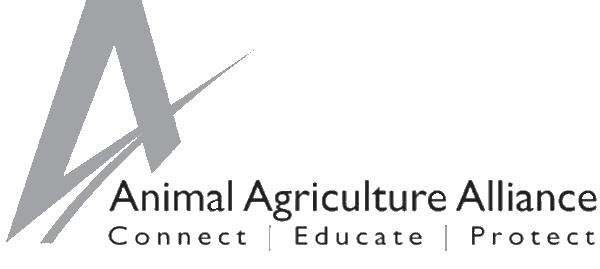
The designation was made as part of the Alliance’s annual report, which revealed that animal rights groups are bringing in over $800 million annually, often through misleading advertisements that claim donations will benefit pets when, in reality, those contributions are funding attacks on livestock producers.
“No matter the animal rights extremist group or the tactics used, they all share the same goal of eliminating animal agriculture and taking meat, dairy, poultry, eggs, and seafood off of our grocery store shelves and family tables,” said Abby Kornegay, Animal Agriculture Alliance’s manager of issues and engagement. “These reports succinctly detail those true intentions, the strategic efforts of the animal rights movement to further their agenda, and key tactics for the animal agriculture community to be aware of.”
OCM and Farm Action are two particularly deceiving organizations that frequently lobby against cattle
producers and National Cattlemen’s Beef Association (NCBA) members. Both groups have ties to the Humane Society of the United States. According to the Animal Agriculture Alliance, OCM was added to the list of activist groups because of Marty Irby’s involvement as a board member. Irby is a former employee of HSUS and has ties to former HSUS President and CEO Wayne Pacelle. Farm Action has also shared employees with both HSUS and OCM, with Farm Action co-founder Joe Maxwell previously serving as a leader in OCM.
Both OCM and Farm Action have recently attacked the cattle industry by pushing the deceptively named “Opportunities for Fairness in Farming” or OFF Act. Proponents of the OFF Act claim that the bill increases transparency and oversight of commodity checkoff programs. However, the legislation is a sneaky way for activists to reduce producer oversight of checkoffs and ultimately harm the effectiveness of these programs.
Several components of the OFF Act duplicate existing law. For example, the bill would require audits of checkoff funds (which already occurs with these audits being posted on the Cattlemen’s Beef Board website), prohibit checkoffs from disparaging other commodities (already federal law), and prohibit checkoff dollars from being used to lobby (already federal law). One key change in the bill is a provision preventing checkoff boards from contracting with any organization that also hires lobbyists. This provision would prevent groups like NCBA, the American Farm Bureau Federation, land grant universities, and many research institutions from contracting with the Beef Checkoff, harming the producer-direction of checkoff programs.

Hart. “Although this case was specific to the pork industry, without action from Congress, the door is wide open for states to start passing all sorts of new regulations that could impact cattle production practices, target feedlots, and create a confusing patchwork of state laws that hampers interstate commerce.”
In pushing for the EATS Act, animal rights organizations are following a familiar strategy of attempting to make livestock production increasingly hard. Without legislation like the EATS Act in place, individual states could pass a whole host of politically motivated agricultural rules that close key markets, make livestock production increasingly difficult, and drive up the cost of food as a result.
The listing of OCM and Farm Action as radical animal rights organizations
is the first step to ensuring that policymakers understand who is truly behind the misleading attacks on the cattle industry. For more information on the Animal Agriculture Alliance’s work, please visit www.animalagalliance.org
About the Animal Agriculture Alliance. The Alliance safeguards the future of animal agriculture and its value to society by bridging the communication gap between the farm and food communities. We connect key food industry stakeholders to arm them with responses to emerging issues. We engage food chain influencers and promote consumer choice by helping them better understand modern animal agriculture. We protect by exposing those who threaten our nation’s food security with damaging misinformation.
N.C. Cattle Receipts, Trends, and Prices for the Month of AUGUST 2023
Cattle Receipts: 15,764 • Previous Month: 11,954
Feeder supply - 26% steers • 43% heifers • 31% bulls
Y’all have stumbled on the best place to advertise expert A.I., superior genetics, the best in purebreds and outstanding farm supplies. Check the Classifieds in this issue!
These organizations are also lobbying against the Ending Agricultural Trade Suppression (EATS) Act. The EATS Act was introduced by Senator Roger Marshall (R-Kan.) and Representative Ashley Hinson (R-Iowa) following the Supreme Court’s decision on California’s Proposition 12.
In their decision in National Pork Producers Council v. Ross, the Supreme Court issued a troubling decision that allows states to restrict agricultural production practices across the country,” said NCBA Chief Counsel Mary-Thomas
The Carolina Cattle Connection q OCTOBER 2023 PAGE 35
NEWS
FEEDER STEERS (Medium and Large 1-2) Wt. Range Avg. Wt. CWT Avg. Price 400-450 426 $230.84 $983.38 450-500 471 $241.62 $1,138.03 500-550 527 $242.24 $1,276.60 550-600 574 $242.46 $1,391.72 600-650 627 $241.90 $1,516.71 650-700 672 $229.70 $1,543.58 FEEDER BULLS (Medium and Large 1-2) Wt. Range Avg. Wt. CWT Avg. Price 400-450 424 $217.39 $921.73 450-500 474 $211.26 $1,001.37 500-550 524 $203.98 $1,068.86 550-600 576 $201.80 $1,162.37 600-650 620 $192.53 $1,193.69 650-700 673 $186.76 $1,256.89 FEEDER HEIFERS (Medium and Large 1-2) Wt. Range Avg. Wt. CWT Avg. Price 400-450 422 $202.40 $854.13 450-500 472 $202.31 $954.90 500-550 524 $197.11 $1,032.86 550-600 571 $201.45 $1,150.28 600-650 622 $195.10 $1,213.52 650-700 670 $193.49 $1,296.38 Source: N.C. Dept. of Agriculture - USDA Market News Service, Raleigh, N.C. - 919-707-3156 SLAUGHTER CLASSES Avg. Wt. Price Cows - % Lean Breaker 1,477 $103.54 Boner 1,218 $103.29 Lean 1,025 $91.38 Bulls - Yield Grade 1-2 1,458 $121.25 FEEDER CLASSES
N.C. Junior Beef Round-Up. The N.C. Junior Beef Round-Up was held on August 12-13 in Fletcher, North Carolina. There were a good number of Simmental exhibitors present, with 16 heifers in the purebred Simmental show and 27 in the Percentage Simmental show. In the purebred show, Marcie Harward of Richfield exhibited the grand champion
By JENNIE RUCKER Executive Secretary N.C. Simmental Association

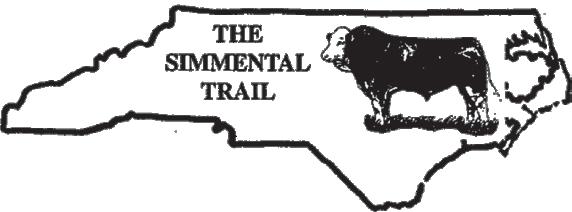
Simmental heifer with AALB Boy Katie 207K, sired by Holt Kamp CLAS Change Is Coming. This heifer was also the junior champion heifer. Cullen Joines of Blacksburg, Va., exhibited the reserve champion heifer with CTJ Stop and Stare L357, the champion junior heifer calf. Stop and Stare is a daughter of JSUL Something About Mary 8421.
The reserve junior calf champion was TX Jemberly, shown by Cooper Joines of Virginia and sired by CDI Innovator 325D. Cooper also exhibited the champion senior heifer calf with CRJ Dana K227, a daughter of WLE Copacetic E02. The reserve junior champion heifer was another heifer shown by Cooper Joines, TX Electra, sired by Conley GCC Shocker C19. Cullen Joines exhibited the senior champion heifer, CRJ Dana J128. This heifer is sired by JSUL Something About Mary 8421. Sarah Weaver of Catawba exhibited the reserve senior champion heifer with TX Charlene, sired by LLSF Vantage Point F398. Rylea
Suddreth of Catawba was the exhibitor of the champion Simmental cow/calf pair, which also went on to become the supreme champion cow/calf pair. This cow was STCC Lila’s Gift 064J, sired by TJSC Hammer Time 35D.


In the Percentage Simmental show, Trey Davis of Iva, S.C., had the grand champion and reserve champion heifers. The grand champion heifer was the senior champion heifer, 909J, sired by W/C Bankroll 811D. This heifer went on to be named the reserve supreme heifer overall. The reserve champion Percentage Simmental heifer was S&S Hara Princess Mary 2514K, the junior champion
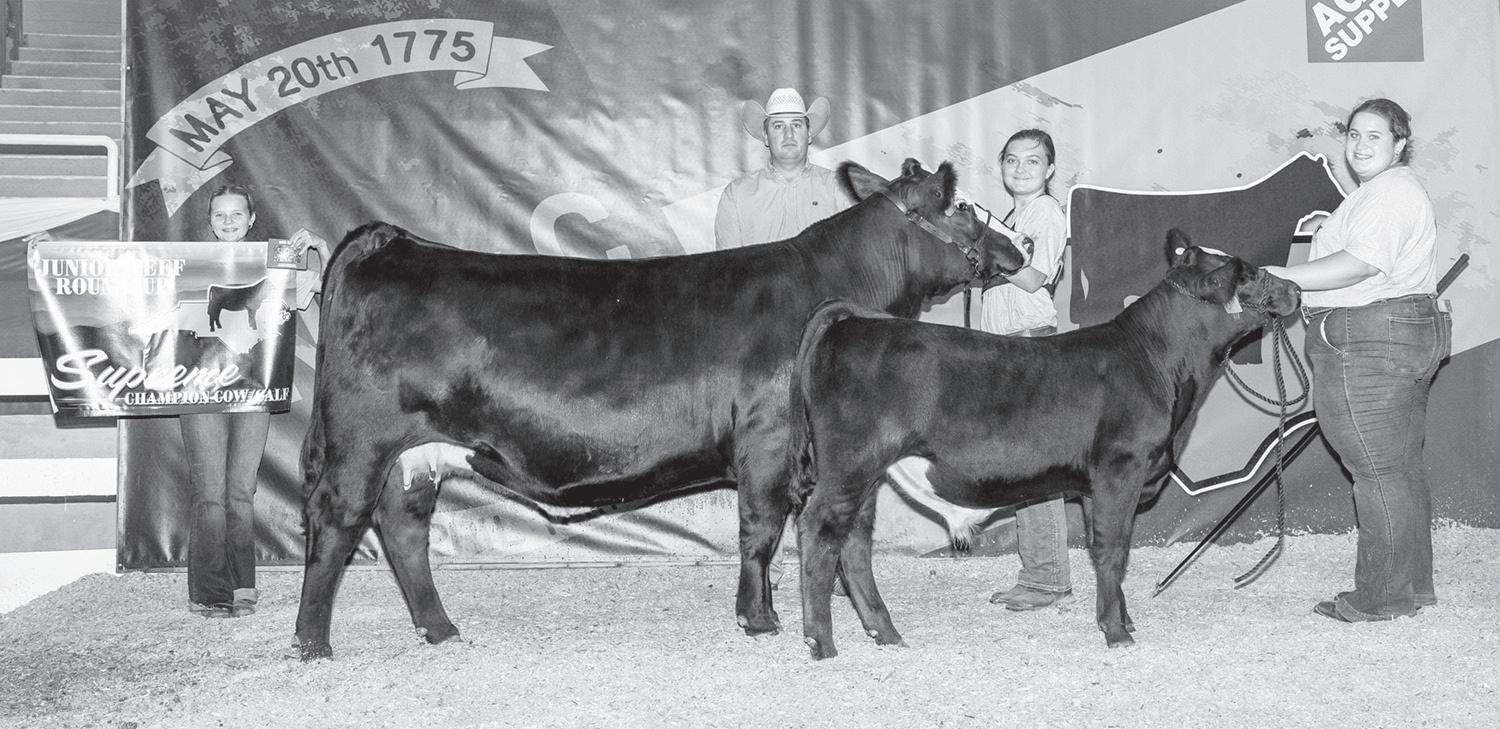
PAGE 36 The Carolina Cattle Connection q OCTOBER 2023
THE SIMMENTAL TRAIL American Simmental Association 1 Genetics Way • Bozeman, MT 59718 406-587-4531 • www.simmental.org N.C. Simmental Association 1341 US Hwy 21 • Hamptonville, NC 27020 336-468-1679 • www.ncsimmental.com • NCSA@yadtel.net Like us on Facebook!
Grand champion Simmental and supreme champion cow/calf pair shown by Rylea Suddreth.
Reserve champion Simmental shown by Cullen Joines.
Grand champion Simmental shown by Marcie Harward.
heifer. This heifer is a daughter of JSUL Something About Mary 8421 and went on to be named the 5th overall heifer at the Round-Up.



Cullen Joines exhibited the champion junior calf with TX Desert Rose, sired by W/C Bank On It 273H. Evie Jones of Shelby exhibited the reserve champion junior calf with Miss Prowler L16, a daughter of OMF Epic E27. Rex Howard of Shelby exhibited the champion senior calf with JSUK PCC Who 2549K, sired by JBSF Berwick 41F. The reserve champion senior calf was shown by Cooper Joines with CRJ Shadoe K277, sired by JSUL Something
About Mary 8421. The intermediate champion heifer was shown by Blaine Abruzzio of Enoree, South Carolina. This daughter of Reckoning 711F is ELMR Cream And Sugar 206K. Isaac Miller of Virginia exhibited the reserve champion intermediate heifer with Huckleberry Karma, sired by Huckleberry Walk Off. Reserve champion junior heifer was shown by Emma Vanhoy of Catawba, and this heifer is Rose High On Love 92K, sired by Rose MC Encore 0463. Rex Howard exhibited the reserve senior champion heifer with PCC Glamour Girl 1525J, a daughter of THSF Lover Boy B33. Congratulations to all these juniors!

The Carolina Cattle Connection q OCTOBER 2023 PAGE 37
Grand champion Percentage Simmental and supreme champion heifer shown by Trey Davis.
Reserve champion Percentage Simmental and 5th overall heifer shown by Trey Davis.
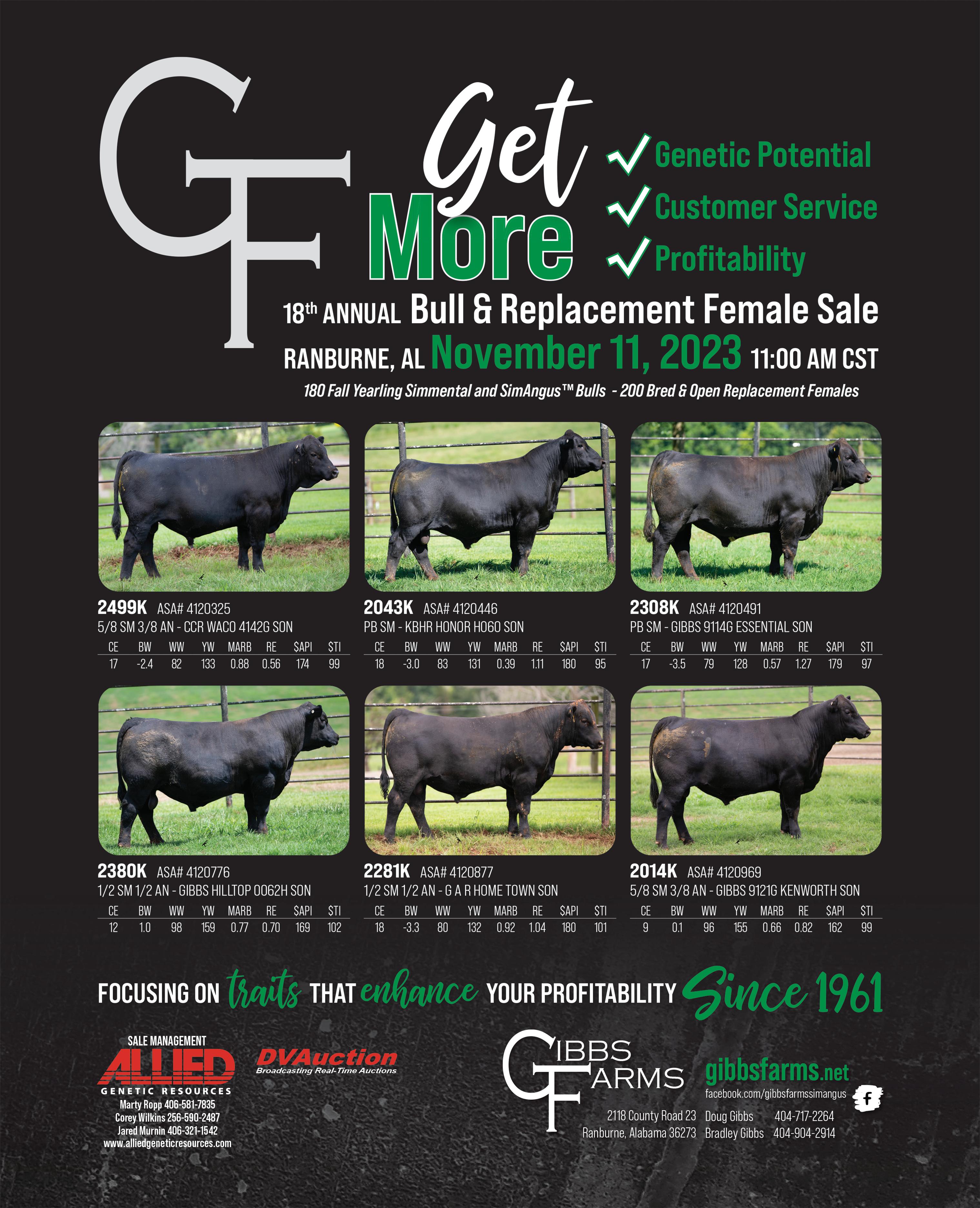
PAGE 38 The Carolina Cattle Connection q OCTOBER 2023
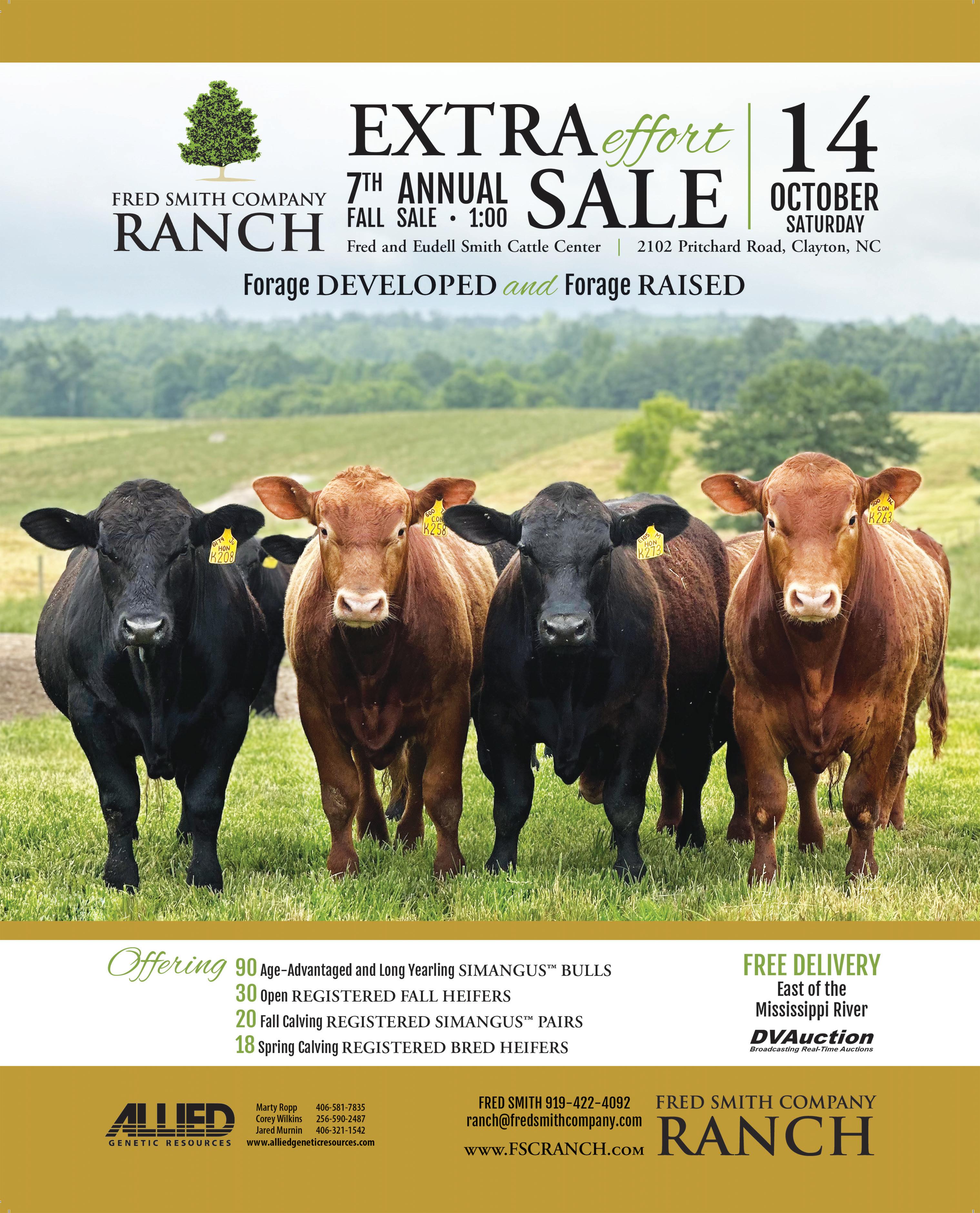
The Carolina Cattle Connection q OCTOBER 2023 PAGE 39
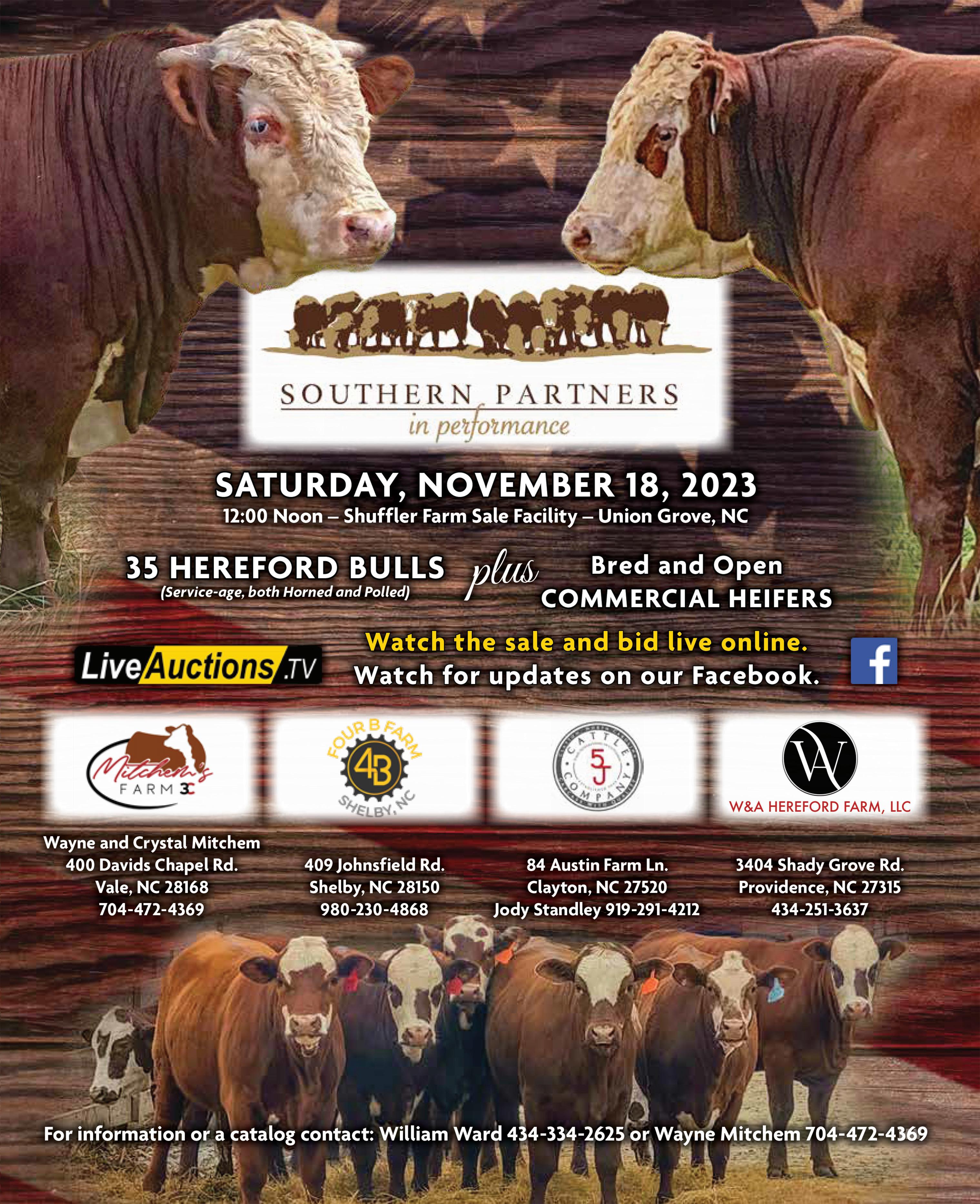
PAGE 40 The Carolina Cattle Connection q OCTOBER 2023
OCTOBER EVENTS
Carolina Classic Fair Open Heifer Show, Winston-Salem - October 6

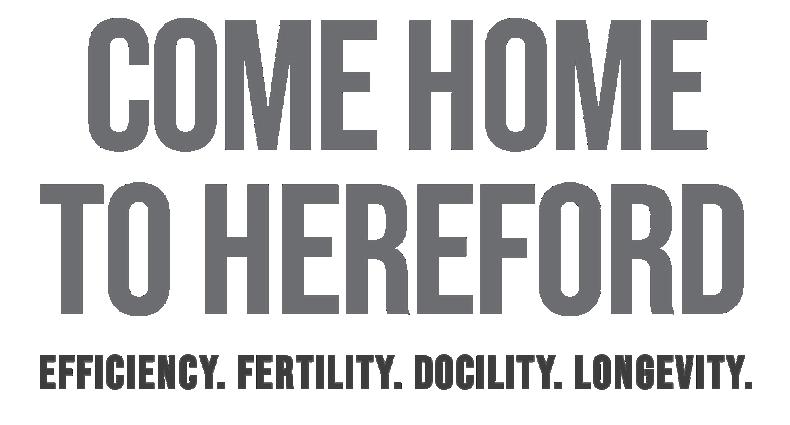

N.C. State Fair, Raleigh - October 12-22
2023 AHA Annual Membership Meeting and Conference, Kansas City Marriott Downtown, Kansas City, Mo. - October 19-22
To advertise here, contact Myron McCoy ncherefordassociation@gmail.com
4B FARMS, LLC
Shelby, NC
Bryson Westbrook
Ed Soto (Manager) 980-230-4868 - Bryson 704-974-1407 - Ed brysonw@thewestbrookco.com

BLINSON POLLED HEREFORDS
Lenoir, NC
Keith & Peggy Blinson - 828-310-4526
Bryan & Beth Blinson - 919-422-9108
DOUBLE J FARM
Traphill, NC • Earlysville, VA
John Wheeler 910-489-0024
doublejfarmllc@yahoo.com www.doublejfarmllc.com
E. CARROLL JOYNER
BEEF UNIT
Raleigh, NC
Matt Morrison 716-720-0227
FIVE J’S BEEF & CATTLE COMPANY

Clayton, NC
Jody & Angela Standley
Kim Prestwood (Manager) 828-320-7317 - Kim jodystandley@gmail.com
HEREFORD HILLS
Greensboro, NC
Bill Kirkman III 336-382-9635 ST Genetics Representative

LOOKABILL FAMILY LIVESTOCK
Lexington, NC
Reggie, Patty, Tyler & Noah Lookabill 336-240-2142 rlookabill6015@gmail.com
McCOY CATTLE FARM Cove City, NC Myron & Charlie McCoy 252-229-4602 mccoycattlefarms@gmail.com
COMING SOON
November Bull Sale
MITCHEM’S FARM 3C
Vale, NC
Wayne, Crystal, Regan & Jordan Mitchem 704-472-4369 mitchemsfarm@bellsouth.net
NORTH PINO LAND & CATTLE COMPANY Mocksville, NC Kevin Robinson 336-940-2547 kevrob1@aol.com
LOVE FARMS Blowing Rock, NC Jim Love 828-266-1458 cell • 828-295-4236
P and J FARMS Monroe, NC Andy Smith 704-400-3436 pandjfarmsherefords@gmail.com
PRESTWOOD BEEF CATTLE Lenoir, NC Kim & Lori Prestwood 828-320-7317 - Kim 828-432-7434 - Lori brownloriclyde@yahoo

QUAIL RIDGE FARM Rutherfordton, NC Mark Brewer 828-329-2074 markbrewer65@gmail.com
TAYLOR’S MILL FARM Zebulon, NC J. Brent Creech 919-801-7561 tmfherefords@icloud.com
TERRACE FARM Lexington, NC Jim, Linda & Chad Davis 336-247-1554 jgdavis101@yahoo.com
TRIPLETT POLLED HEREFORDS Statesville, NC James Triplett 704-902-2250 triplettmarble@bellsouth.net
W&A HEREFORD FARM Providence, NC George, Tammy, William, & Andy Ward 434-251-3637 gwwardjr@comcast.net
WILL-VIA POLLED HEREFORDS Mooresville NC Lavette Teeter 704-662-5262
The Carolina Cattle Connection q OCTOBER 2023 PAGE 41 Check out the North Carolina Hereford Advantage at www.nchereford.com Myron McCoy N.C. Hereford Association Secretary/Treasurer 252-637-4995
www.nchereford.com
ncherefordassociation@gmail.com
North American Limousin Foundation Board Actions of the 2023 August Board of Directors Meeting. Rate Increase - Due to continued increases in inflation and the cost of doing business the previous three years, the North American Limousin Foundation (NALF) Board of Directors has approved a modest increase in registration fees that will become effective on September 1. Non-Lim registrations will increase by $3 per head, and LIMS registrations will increase by $1 per head for the upcoming 2023-2024 fiscal year. All other fees will remain the same.

Annual average increases with inflation rates averaging nearly six percent over the previous three years has increased cost for NALF, like other businesses. Utilities, travel, postage, and rent, among other items, have impacted the cost of doing business like other industries. The NALF board desires to maintain the level of services provided by
the association.

Registrations look to end the 2022-2023 fiscal year slightly higher than the previous year but increases in actual normal business costs have offset registration totals the previous three years. The NALF board desires to keep the finances of the association on sound footing while providing a full array of services to its membership in the upcoming years.
New EPDs Release - During the summer of 2022, the NALF board voted to move forward with the build and production of five new EPDs and two new indexes, which are anticipated to be released over the next three months. Look for the additional EPDs of Dry Matter Intake, Feed Conversion, Average Daily Gain, Cost of Gain, and Mature Cow weight to be released this fall. NALF will soon provide details of these new EPDs to membership prior to their release.

Soon after the release of these five

EPDs, the board also approved the release of two new indexes that will be more reflective of today’s current cattle marketing conditions. The production of a new terminal index and maternal index will be released through the IGENDEC software owned by the Beef Improvement Federation. The production of NALF’s mainstream terminal index will continue into the future as well.
North American Limousin Research Foundation - The North American Limousin Research Foundation (NALRF) research project is also moving forward. Calves at our Montana ranch cooperators are scheduled to ship to South Dakota State University this fall. Feed performance data and carcass data will be collected and analyzed in an effort to measure the effects of heterosis among contemporary breed groups of Limousin, Lim-Flex, and Angus sires when bred to commercial Angus cows.
NALF Board of Director Candidates
- The Nominating Committee reported to the board it had slated three new candidates for the NALF Board of Directors for 2024. They include Dr. Matt Spangler of Nebraska, Trent Coleman of Montana, and Brian Duplaga of Ohio. In addition to three new slates, the board
also approved two candidates to re-up for their second three year term, which included Rob Brawner of Nebraska and Joey Freund of Colorado.
Annual Meeting - The board also approved to move the NALF annual business meeting at the Embassy Suites in Oklahoma City to the grounds of the Cattlemen’s Congress for members and exhibitors to attend the annual meeting more easily. Details of the annual meeting, Ken Holloway Genetics on Ice Annual Auction, National Limousin Sale, as well as the hill and pen show at the National Western Stock Show, will be made available this fall via Limousin Latest and NALF’s social media outlets. About the North American Limousin Foundation. The North American Limousin Foundation, headquartered in Englewood, Colo., provides programs and services, including the documentation of more than 25,000 head of cattle annually, for approximately 4,000 members and their commercial customers. The Limousin breed and Lim-Flex® hybrid offer industry leading growth and efficiency while being an ideal complement to British breeds. For more information about NALF, please visit www.nalf.org
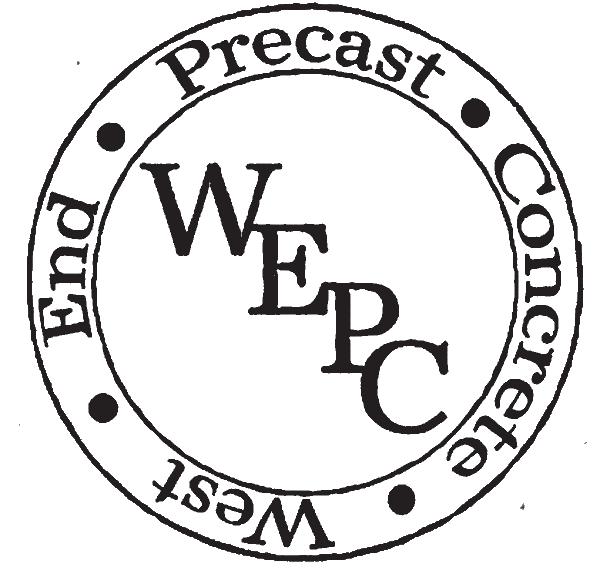
PAGE 42 The Carolina Cattle Connection q OCTOBER 2023
West End Precast 276-228-5024 Prices FOB Wytheville, Virginia • Delivery Available PRECAST CONCRETE FEED BUNKS J-Bunks - $200 U-Bunks - $200 Calf Bunks - $150 Water Troughs - $150 Pads - $250 Tanks Truckload Discount - $10/each
By JON ALBO, Ridley Block Operations
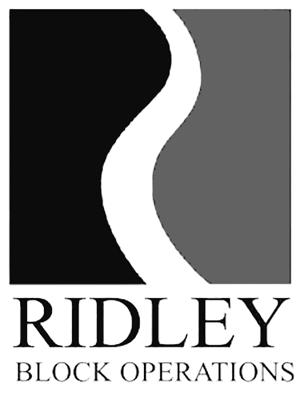
The Economics of Self Fed Supplements — How Crystalyx Pencils Out
Self fed or free choice supplements come in many forms and can be used effectively for a variety of applications. Supplementation generally gets a lot of commentary in the popular press, as well as extension and research publications. Oftentimes, however, the recommendations related to which type of supplement to use are based only on one factor or concept, such as the cost per pound of nutrient. What often gets overlooked when this happens is the larger picture of a beef cattle operation’s management and practicality. In this blog, I will highlight the elements of supplement economics that often get overlooked or underappreciated.
Value beyond the tag: What are some supplements missing? Last fall, I wrote a blog titled “Choosing the right self fed supplement for your operation” that focused on the various forms of free choice supplements on the market and how they can differ greatly. Crystalyx is a very practical option; it’s a complete free choice supplement that includes protein, minerals, and vitamins, as well as optional additions like fly control, Bio-Mos, and more. Many hand fed supplements, such as range cubes/ pellets, and commodity ingredients, such as distillers’ grains, are good sources of protein and energy and seem economical when they are evaluated solely based on the cost per pound of protein or other nutrients. What these supplements are missing, however, is vitamin and mineral fortification. As such, when making a true comparison of Crystalyx vs. a hand fed commodity supplement, the cost of a
mineral program — which many hand fed supplements are missing — must be taken into account.

Additionally, the hidden costs associated with feeding several times a week or even daily can make other supplement options very expensive. This aspect alone can add 50 percent or more to the cost of a hand fed supplement or commodity. Incorporate the additional costs of delivery, storage, and shrink, and the daily cost per head of a hand fed supplement is often higher than the cost of Crystalyx.

I once attended a producer meeting in Nebraska where a speaker gave a presentation about how to store wet distillers’ grains in the summer months for feeding in the fall and winter. The presentation focused more on how to build bunkers, use tarps, and mitigate spoilage than it did on the nutrient value of the commodity. Lower cost per ton byproduct ingredients are good sources of feed and work well in feed rations — if producers have the size and scale to invest in capital improvements that allow those ingredients to be properly stored, mixed, and fed. Again, however, the practicality and cost of investing when using these ingredients as a supplement — including those hidden costs — make offering Crystalyx as a free choice supplement a more practical option, especially when fall and winter grazing.
How does your free choice supplement measure up? Crystalyx is not a price in a tub. Our quality standards are not compromised by using poor molasses or low grade vitamins and minerals or
by including non-nutritive binders and fillers. When it comes to quality, there is no such thing as a “bargain” supplement; in fact, the “cheapest” tub on the market may actually cost the most to feed in terms of intake. Additionally, poor quality ingredients will only yield poor quality performance.
As an industry, we are learning a lot more about the interactions of lesser quality minerals — such as high levels of sulfates and oxides — both in the diet and in mixed feed. These ingredients may make a feed tag look good, but when they are fed, they can actually impede or reduce performance.
On the other hand, even the best fortified supplement can be ineffective or useless if it’s not managed correctly. Some of the biggest mistakes we see with feeding free choice supplements are the mismanagement of where a supplement is placed, as well as how much, which can lead to issues like overdiluting with salt or letting the supplement run out for days or weeks. This kind of mismanagement can lead to improper intake — either too much or too little — and can impact the performance and economic return of a program as a result. Providing Crystalyx can make managing your supplement much easier. It also provides the added benefit of improved pasture management via better grazing distribution, which is another way to improve forage utilization, manage through droughts, and reduce the
cost of and need for purchased forages.
I once had a discussion with a prominent ranch manager in the Western U.S., who said that Crystalyx was “way too much money to pay for protein.” I surprised him by agreeing with him — but I went on to clarify that protein is not all that Crystalyx provides. We then discussed the value of grazing distribution and other factors, and he eventually agreed that Crystalyx provided the best value for what he wanted to accomplish on his ranch.

Put a pencil to all costs. When assessing all of the costs and benefits of a supplement program, the cost per ton, tub, or pound is only a small part of the equation. Choosing a supplement is just like choosing a cow: It needs to fit your environment. How easy is it to manage? How practical is it? And is it of a high enough quality to generate an acceptable return?
The table below serves as a good illustration of the true costs and values of various options. While the cost per head per day will vary among different Crystalyx products and the regions in which they will be fed, considering what Crystalyx provides and the savings it offers, it’s still the best option on the market. Put your pencil to it, talk to your local Crystalyx dealer or representative, and be confident in Crystalyx as your go to brand for this fall and winter. Learn more at www.crystalyx.com
The Carolina Cattle Connection q OCTOBER 2023 PAGE 43
NEWS
Zoetis Presents First Donation of 2023 to Folds of Honor. Contribution supports education for spouses and children of military service members. Zoetis donated $250,000 in the first half of 2023 to Folds of Honor. This is the second year of partnership with the nonprofit, bringing Zoetis’ overall total contribution to $830,000, which has funded 166 scholarships to deserving recipients.
Folds of Honor was founded in 2007 by Lt. Col. Dan Rooney and is based in Owasso, Oklahoma. Folds of Honor provides academic scholarships to the families of men and women who have fallen or been disabled while serving in the U.S. armed forces.
Zoetis’ donation to the scholarship program is based on sales of select Zoetis products. “With the continued support of our beef and dairy producers, Zoetis helps fund scholarship programs for the families of heroes who help protect our rights and freedoms as Americans,” said Jared Shriver, U.S. Livestock Senior Vice
President at Zoetis.
Long time Zoetis customer and rancher Tyler Petrak of Martin, S.D., feels it’s his duty as an American patriot to support programs like Folds of Honor.
“Having the largest animal health company join this program speaks volumes,” Petrak said. “Anyone can sell pharmaceuticals, but the help Zoetis is able to provide to those families in need is extremely meaningful.”

• Since 2022, Zoetis has contributed $830,000
• Those donations have funded 166 scholarships
• Through the first half of 2023, Zoetis has donated $250,000
• 50 scholarships have been awarded in 2023
Zoetis is committed to supporting the legacy of military service members in agriculture and communities across the United States. Zoetis will donate a portion of sales of select cattle products through
December 31 to Folds of Honor. Qualifying products are Draxxin (tulathromycin injection) Injectable Solution, Draxxin KP (tulathromycin and ketoprofen injection) Injectable Solution, Excede (ceftiofur crystalline free acid) Sterile Suspension, and Excenel RTU EZ (ceftiofur hydrochloride) Sterile Suspension.
For more information about Folds of Honor, visit www.foldsofhonor.org. If you would like to learn more about how Zoetis works with Folds of Honor, contact your local Zoetis representative or visit www. zoetisus.com/misc/folds-of-honor-faq.aspx
About Zoetis. As the world’s leading animal health company, Zoetis is driven by a singular purpose: to nurture our world and humankind by advancing care for animals. After innovating ways to predict, prevent, detect, and treat animal illness for more than 70 years, Zoetis continues to stand by those raising and caring for animals worldwide — from veterinarians and pet owners to livestock farmers and ranchers. The company’s leading portfolio and pipeline of medicines, vaccines, diagnostics, and technologies make a difference in over 100 countries. A Fortune 500 company, Zoetis generated revenue of $8.1 billion in 2022 with approximately 13,800 employees. For more, visit www.zoetis.com
About Folds of Honor. Folds of Honor is a 501(c) (3) nonprofit organization that provides educational scholarships to the spouses and children of military members who have fallen or been disabled while serving in the United States Armed Forces. Beginning in 2022, it expanded its mission to include first responders. Our educational scholarships support private school tuition or tutoring in grades K-12, tuition for college, technical or trade school, and post graduate work, including a master’s degree, doctorate, or professional program. Funds for a second bachelor’s degree or trade/technical program certification are also available.
Since its inception in 2007, Folds of Honor has awarded about 44,000 scholarships totaling about $200 million in all 50 states. Among the students served, 41 percent are minorities. It is rated a four star charity by Charity Navigator and Platinum on GuideStar. It was founded by Lt. Col. Dan Rooney, the only ever F-16 fighter pilot (with three combat tours in Iraq) and PGA Professional. He is currently stationed at Headquarters Air Force Recruiting Service Detachment 1 at Joint Base San AntonioRandolph, Texas. For more information or to donate in support of a Folds of Honor scholarship, visit www.foldsofhonor.org
Contact these RAAC members to learn more about Red Angus genetics and how they can fit into your herd.

HARDROCK BEEF CATTLE
Ronnie & Donna Holman
4613 Hickory Nut Ridge Road • Granite Falls, NC 828-302-8659 ronnie@hardrockbeefcattle.com
JK RED ANGUS
Jeff Banfield & Madison Adams 331 Tee Jay Farm Road • Aberdeen, NC 910-315-3821 jkredangus@gmail.com
LANGDON RED ANGUS & SIMMENTAL
John & Eileen Langdon 7728 Raleigh Road • Benson, NC 919-796-5010 johnlangdon5@gmail.com
ROGERS CATTLE COMPANY
Johnny & Sharon Rogers 945 Woodsdale Road • Roxboro, NC 336-504-7268 rccbeef@gmail.com
PRESNELL RED ANGUS
Jonathan & Jacob Presnell 368 Whitaker Road • Shelby, NC 704-473-2627 (Jonathan) • 704-616-8775 (Jacob)
BULL HILL RANCH
Jim & Alvina Meeks • Raymond Prescott, Manager 1986 Trinity Church Road • Gray Court, SC 864-682-3900 • 864-682-2828 bullhill2@mindspring.com
COUNTRY BOY FARMS
Cole Maness, President - scmaness3@gmail.com
David Miller 316 Key Road • Edgefield, SC 706-840-3709
PAGE 44 The Carolina Cattle Connection q OCTOBER 2023
NEWS
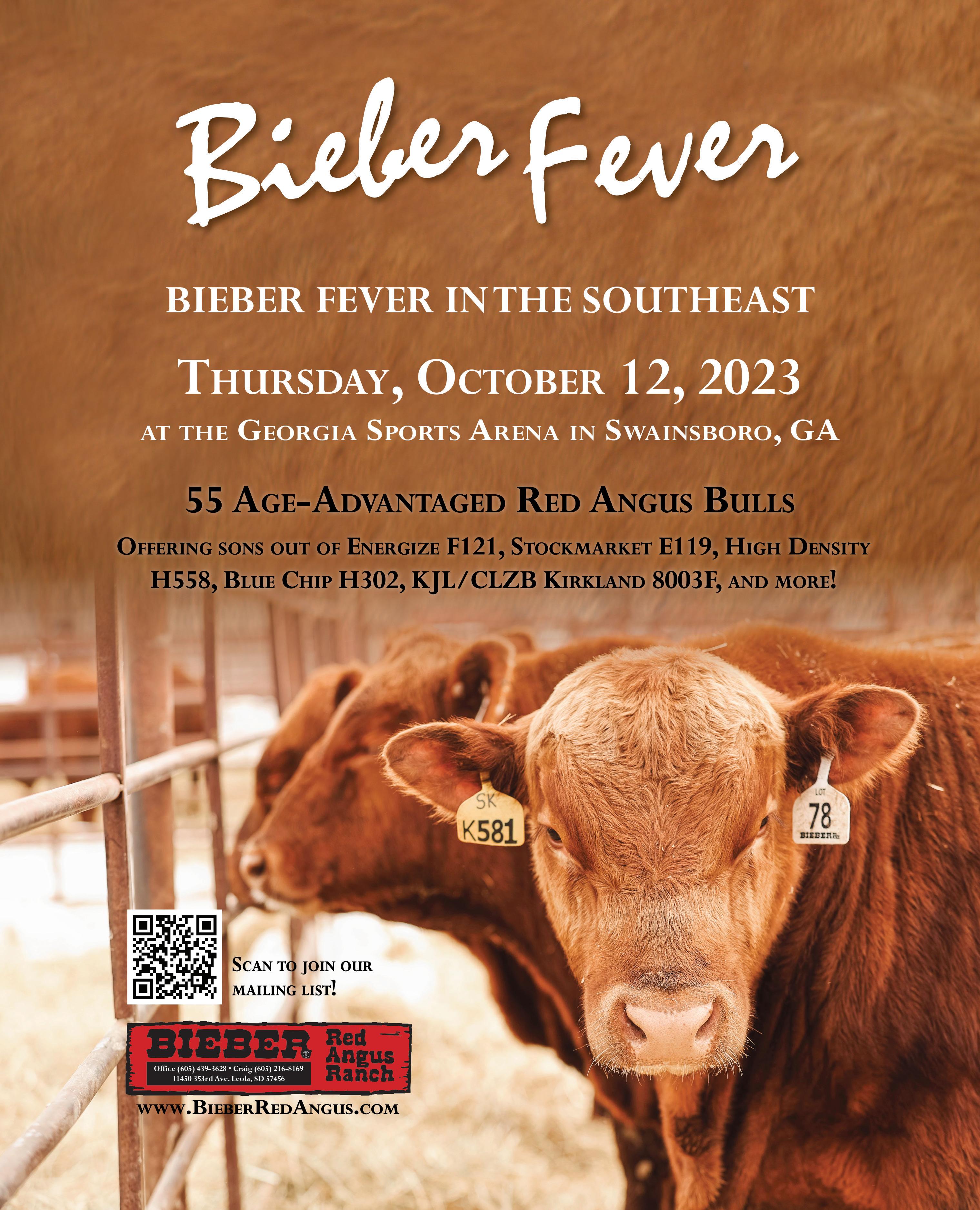
The Carolina Cattle Connection q OCTOBER 2023 PAGE 45

PAGE 46 The Carolina Cattle Connection q OCTOBER 2023

The Carolina Cattle Connection q OCTOBER 2023 PAGE 47

PAGE 48 The Carolina Cattle Connection q OCTOBER 2023
NEWS
Producer Profitability Initiative Seeks to Spark Conversation, Unite Industry. Livestock Marketing Association members have a front row seat to a disturbing trend: the continued loss of livestock producers across the United States. They see this as a critical threat, not only to the livestock industry but to the nation’s food supply. That’s why they’re launching an initiative to strengthen producers’ bottom lines and incentivize the next generation of farmers and ranchers.
Joe Goggins, owner of Public Auction Yards in Billings, Mont., said despite recent record high livestock prices, it’s tougher than ever to be a producer. Lack of access to land and
labor, over regulation, and input costs are causing more people to exit the business while preventing new producers from getting started.
“We continue to disperse cow herds,” he said. “We continue to disperse flocks of sheep. We continue to lose thousands and thousands of acres out of protein production. And we really feel that we better push back, we better unify this industry somehow, some way, to try to encourage and incentivize people to be in this business.”
Goggins said by working together, all industry segments can accomplish so much more than they can individually, and every voice matters.
“I’d encourage producers of all types,
GELBVIEH NEWS
Wellsandt Announced as American Gelbvieh Association Fall Intern. The American Gelbvieh Association (AGA) is excited to announce the hiring of Sydney Wellsandt of Unadilla, Neb., as the AGA fall intern. In her internship, Wellsandt will be assisting in all aspects of AGA operations, including members programs and services support, member education, and preparation for the 53rd Annual AGA National Convention and AGA National Show activities.
“Throughout the fall, Sydney will gain experience with all facets of a beef breed association,” said Megan Slater, AGA executive director. “We are excited to have her joining our AGA team to assist with customer service, communications, and planning our annual convention.”
Wellsandt grew up on an acreage in Unadilla, Neb., where she showed cattle with her sister across the state and was actively involved in her local 4-H and FFA programs. Through these activities, she grew a deeper passion for the beef industry and became dedicated to finding ways to give back to the industry. She is a junior at the University of NebraskaLincoln, where she is studying animal
science with minors in agribusiness, Krutsinger Beef Industry Scholars, and Engler Agribusiness Entrepreneurship. She is also involved in Block and Bridle and serves on the Young Nebraska Cattlemen board of directors. Wellsandt plans to pursue a career in the beef industry where she can share her passion with others and work alongside producers.
“I’ve always had an interest in breed associations and the role they play within the beef industry. I look forward to working with members of the AGA and learning how the association works with them to grow the breed,” said Wellsandt. “The team at the AGA is consistently working hard for the members and their cattle, and I’m excited to be a part of the positive impact they have on the industry.”
Wellsandt began her internship on September 8 and can be reached at intern@gelbvieh.org or at the AGA office at 303-465-2333.
About the American Gelbvieh Association. AGA is a progressive beef cattle breed association representing 1,100 members and approximately 40,000 cows assessed annually in a performance oriented total herd reporting system.
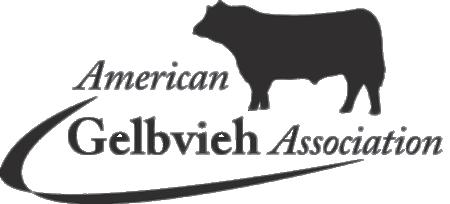
sizes, and locations to reach out to people in their network and to the organizations they are a part of to have conversations about the biggest barriers to profitability,” he said.
These include but are not limited to, the death tax, lack of incentives to keep land in livestock production, and competition for land and margin.
Mike VanMaanen, who owns Eastern Missouri Commission Company in Bowling Green, Mo., said despite the producer-focus of this initiative, they’re not trying to expand into an organization for farmers and ranchers — they just know every segment of the industry depends on the others for success.
“We just want to help our customer base by starting the conversation with them,” he said. “And hopefully they’ll take that to the organizations they belong to, and we can all work together toward a common goal.”
He said the producer’s livelihood is the livestock marketer’s livelihood, and for one to be successful, they both must be.
Mandy Geistweidt, who, alongside her husband Shaun and family, owns and operates Gillespie Livestock Company in Fredericksburg, Tex., said the initiative will help market owners help their customers — and she’s seen just how much help is needed.
“Our taxes are going up incredibly because the value of our land is rising astronomically,” she explained. “So, a lot of what was Dorper sheep and Angus cattle is now becoming vineyards and agritourism.

“On a personal note, I hope I can take this initiative back myself because we have so many small producers coming out of the city that are just coming to Mom and Dad’s place now. And I hope that I find some ways I can help even those small producers stay — stay active, stay producing.”
But while the message applies anywhere, the implications could be much farther reaching, Goggins said.
“It’s not only for our benefit if we keep these ranches in production,” he said. “We look at this thing as preserving our food independence in this country. Preserving our national security. The way we look at this is if the world wants the United States to produce the highest quality, safest product in the world, then all we ask is that these people can make a decent living.”
To join the conversation, visit www. producerprofitability.com or contact your local LMA member livestock marketing business.
About the Livestock Marketing Association. LMA, headquartered in Overland Park, Kan., is North America’s leading national trade association dedicated to serving its members in the open and competitive auction method of marketing livestock. Founded in 1947, LMA has more than 800 member businesses across the U.S. and Canada and remains invested in both the livestock and livestock marketing industries through member support, education programs, policy representation, and communication efforts.
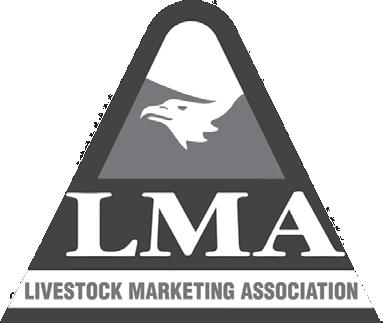
The Carolina Cattle Connection q OCTOBER 2023 PAGE 49
Be a winner! Join your local cattlemen’s association AND your state cattlemen’s association!
Predictive Performance Value

Add Program. Calves with a bolstered immune status and optimum gut health deserve a premium for their predictive performance in the feedyard. The Predictive Performance Program by Riomax provides a chance for folks using the Riomax tubs to get some recognition and some extra value. Firstly, it gives the feed yard confidence. Secondly, it gives the superior livestock rep credibility. And thirdly and most importantly, it gives the rancher an extra premium.
• 365 day Certification - The 365 day certification is strictly for animals that have access to the Riomax Tubs year round, 365 days a year. A year round approach gives those animals the optimum chance of performance and expression of genetic potential, whether in a feed yard or in a cow herd. With the proven compounding effects of good sound nutrition, it has longer term
benefits such as fetal imprinting, which has generational benefits.
• 90 day Certification - The 90 day certification is strictly for animals that have access to the Riomax Tubs for a minimum of 90 days prior to the date of the sale and through delivery. While a year-round approach (Predictive Performance 365) is without a doubt the optimum herd health program for the compounding effects of good sound nutrition, there are situations where, for certain reasons, the animals are not able to have access year round. With Predictive Performance 90 certified cattle, you can be assured the animals have been on Riomax for at least 90 days, which, according to Dr. Hall, is sufficient time to greatly enhance gut health and bolster immune status and performance.

Confidence for the Feedyard - Calves raised on a quality nutrition program come with a number of benefits, including
general health, strengthened immunity, vaccine responsiveness, efficiency, and weight gain. Sound nutrition takes away the headaches, heartaches, and stress of treats, labor, and medicine costs. The predictive performance program by Riomax is key for the feed yard because it is predictive of good performance. It gives confidence to buyers, knowing it will ultimately enable the feed yard to make more money.
Credibility for the Superior Livestock Rep - The rep is the middleman between the rancher and the feed yard. This program benefits their personal success and reputation by doing right for both parties. Riomax, “the tub that pays for itself,” is helping the rancher and his business through hay and forage savings, improved reproductive performance, herd health, and so on. Recommending this program enables ranchers to get an extra premium and the feed yard to get predictive performance and low risk.
An Extra Premium for the Rancher - Last but not least, what is in it for the rancher?
First of all, it is the tub that pays for itself. You might say, “Well, that sounds too good to be true!” But the consistent 15-30 percent forage savings alone has proven to pay for the product on ranches across North America. On top of that, there’s reproductive performance, weaning weights, and superior herd health, which will make a tangible and measurable difference to your ranching operation.
For those using the Riomax badge, the program is your way of saying, “Hey, I need some recognition. I need some representation for this because it’s my reputation, too.” You’re in the business of producing quality calves so feedlots can come back and say, “I trust that guy and I want those calves.”
A rancher in Montana told us that he sells to the same feed yard in Nebraska annually because they want his calves. However, what they really want is predictive performance, reduced risks, and added dollars.
Dr. Jeffery Hall, ex. head of diagnostic veterinary toxicology at Utah State University, said he had a couple of operations that switched to a quality nutrition program 25 years ago. The buyer called the rancher up and said, “I don’t know what you changed, but whatever it was, don’t ever change it back. Next year, I want to buy every single animal you have at weaning. If they do as good next year as they did this year, I’ll give you a nickel a pound premium to the backside.” He had less than 0.1% pulls on cattle that were well-supplemented. Quality nutrition = better doin’ cattle that are worth more.
• Esqort - Immune Status - The foundational impactor of immune status and
herd health is the Esqort mineral package, which uses 100 percent rumen bypass technology. This ensures the key trace minerals (copper, zinc, manganese, and selenium) have the highest scientific chance of getting into the bloodstream. Livestock with a strong immune status naturally fight off disease challenges from the inside out and consistently outperform livestock with a weak or compromised immune status.
• Nutrizorb - Gut Health - Every Riomax formula is infused with Nutrizorb, which is a powerhouse of all natural digestion ingredients, including yeast, enzymes, prebiotics, probiotics, and fungi fuel. Gut health is not only about digestive efficiency but also is a critical piece of the immune status, leading to more predictive performance in the feed yard.
How to get on the program:
1. Use Riomax, “the tub that pays for itself,” on your herd. If you’re not using it already, you can reach out to our family business, and we’d be glad to help you get started.
2. Let your Superior Livestock rep know. When it comes time to sell your calves, simply let your Superior Livestock rep know which tier of the Predictive Performance program you qualify for.
3. Get a premium for your calves. Buyers can recognize the value in good doin’ calves that will perform in the feedyard, and you’ll get a premium for that.
To summarize, The Predictive Performance Program by Riomax is good for the feed yard, good for the superior livestock rep, and good for the rancher. To achieve optimal herd health, it is necessary to have sound immune health and gut health. This sets up the animal to perform to its greatest potential, be it gains or fertility or overall health status.
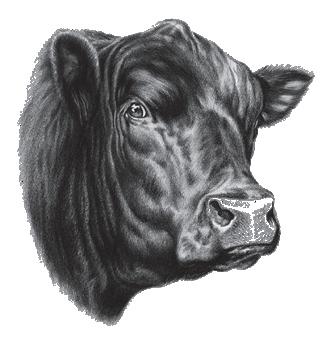
Taking Time to Do It Right. Jacob Tejral is making his mark in the ranching world. You can learn a lot when you’re just killing time. At least that’s Jacob Tejral’s story on why he started using Riomax.
He was at a trade show several years ago, killing time between speakers, when he started talking to a Riomax dealer who had a booth. “So I started picking his brain about it and he had a lot of really good things to say.”
Then, the dealer grabbed some customers who walked by. “They gave me their testimony and it sounded like a pretty good deal.” Turns out, it was. More on that in a moment.
Ranching in Hay Springs - First, meet Jacob. He, his wife, Maddison, and their young son Thatcher run about 50 black hided SimAngus cows while Jacob works as a ranch hand on a larger outfit south of Hay Springs, Neb., right on the edge of hard grass country and Sandhill country.
PAGE 50 The Carolina Cattle Connection q OCTOBER 2023
NEWS
Wilkes Livestock Exchange 106 Armory Road • PO Box 1394 North Wilkesboro, NC 28659 Phone: 336-838-3442 • Fax: 336-838-3591 Shelmer Blackburn, Jr. 919-270-1522 • shelmerblackburn@hotmail.com Seth Church 336-927-5370 • sethchurch@charter.net Weekly Sales - Wednesdays - 1:30 p.m. Take-up Tuesday Evenings Catching and Hauling Services Available
His wife works beside him, helping with the cattle, and works a couple of days a week at the local locker plant.
Their son has all the indications that he’ll follow in the ranching tradition. “He loves cows and loves tractors, making hay,” Tejral says.
“We lease all our ground at the moment. We don’t have any of our own stuff.” That may very well change someday. For now, however, the situation dictates that he often has to find winter corn stalks wherever he can. But he’s fortunate. “We have an abundance of corn stalks in our local area. We’re in a little pocket where we’ve got an irrigation district and plentiful groundwater. So there’s quite a few pivots.”
Often, he’ll run his cows on stalks along with the bosses’. Other times, he’ll find his own winter ground that’s a little cheaper.
He’ll go to summer grass in the middle of May and A.I. the cows, then turn the bulls out the last week in June for 60 days. The cows stay on the leased summer grass until corn stalks or other winter pasture becomes available after harvest, usually at the end of October. The cows stay on winter grazing until the middle of March when they come home to calve in a dry lot.
While he’s been using Angus semen and bulls on his cows, he’s going to make a change in his genetics that may be considered a little controversial. Rather than outcrossing with another of the more mainline breeds, he’s looking at turning out Aubrac bulls.
“They’re a pretty small breed,” he says, in terms of the number of cattle in the United States. “They came from France, but their ability to convert very low quality feed into a good meat product is what’s drawing us toward them.”
Because their numbers are few, their genetics are still consistent with their homeland cousins. “So the quality of the cattle is just a lot more consistent,” Tejral says. “We’re going to put those on our black cows and try to create crossbred females to go forward with.”
Riomax to the Rescue - Given that his cows spend the winter on very low quality feed while growing a calf, genetics are important. Adding Riomax to the mix provides the boost to allow those genetics to shine.
After his trade show experience, he and his wife decided to give the orange tubs a try. They decided to stay with Riomax for a year to give it a fair test and see if it really did all the things they had heard.
“We started in the fall of 2021,” he says when his cows were on corn stalks. But he didn’t notice much difference. He saw a little bit of hay savings when he


moved them to the dry lot for calving, “But it was tough because our cows were mixed with the bosses’ first calf heifers that had not been on Rio. So it wasn’t a very good trial run that first calving season.”
Then summer came around, and that’s when he began to see what Riomax can do. “I think one of the first things was a few of our old grandma cows that looked kind of rough the year before but got pregnant. They didn’t look so rough that year,” he remembers. “We noticed that they were holding condition and putting condition on, whereas the year before, we were thinking we were going to have to part ways with them.”
Given that summer that year was dry, that’s telling. His landlord was running some cows in an adjacent pasture, and a glance across the fence told the tale. “His cows were up at all hours of the day, looking for something to eat, pacing fences, and they weren’t content with what they had,” he says.
The landlord noticed the difference. “He asked me if my cows had enough to eat because his cows were acting like they didn’t have enough to eat and mine did. Mine would lay down by the middle of the morning because they were full and content. You could drive a vehicle out there and they weren’t running, looking for an open gate and new grass.”
If that didn’t seal the deal, preg check time came around and recorded a 98 percent rate. What’s more, between one round of A.I. and clean-up bulls, the vet called an 85 percent pregnancy rate for the first 21 days of the breeding season. The year prior, without Riomax, his cows came in 93 percent bred, with 70 percent in the first cycle.
“So that was a big thing for us. Something was going right.”
Normally, he and his wife background the calves before selling them in February. Given the dry year and expensive hay, he decided to sell that calf crop off the cow after weaning in October. “The steers went across the scale November 5 weighing 575 pounds, and the heifers averaged 535. That’s very similar to what the calves weighed in February the previous year. And these were four months younger.”
Then he went to winter pasture, and that sealed the deal. He leased some dryland corn stalks, wheat stubble, and a grass field that had been hayed, all in one piece. “The price was right and we took that chunk of ground and we’re going to let them stay as long as they could.”
On top of very low quality feed, it was a tough winter. “We had multiple blizzards, multiple sub-zero days, multiple days of 50 mile-an-hour wind and the cows didn’t miss a beat,” he says.
“They were out digging through
the snow, eating,” and their condition generally held in the tough weather and limited, low quality grazing. “I think we fed four or five bales of hay all winter to those cows, and they just didn’t need it. They didn’t act like they needed it; they didn’t look like they needed it.”
The Tub That Pays for Itself - The upfront cost of Riomax tubs can be a concern. But Tejral says, without a doubt, the Riomax tubs pay for themselves. “And then in 2023, we got the Repel tubs with garlic in them to try to reduce the fly pressure.” While flies were around, he noticed very few on the cows’ faces. Which, when it comes to pinkeye, is a great thing to see, he says.
“One thing I noticed is I see my cows spread out in the afternoon” on summer grass, he says. “Whereas most of the neighbor’s cows are tucked away in a corner, balled up, swatting flies off each other. I have yet to see my cows do that. I can see part of the pasture from the gravel road. Quite often, I see them spread out on the hillside, just lounging in the afternoon.”
Working With the Environment, Not Against It - When asked what makes a good rancher, he pauses, considering. “I guess it would be a person who is more concerned
about the land and the natural resources than just making money,” he replies. “There are a lot of things we can do to make an extra dollar, but some of those things are not good for the land, the environment.”
Instead, he advises young folks looking to get into ranching to work with the environment, not against it, and develop cows that are fit for the environment they live in. Cows that are too big for the conditions will wean big calves, he says, “But my cows that are fit to my environment, that don’t need hay all winter, that don’t have to overgraze the pasture to get through the summer and can get it done, that’s worth a lot in the grand scale of things.”
With a forward thinking mind tuned to stockmanship, the land, and what’s best for his cattle, Tejral will continue to make his place in ranching. Who wants to bet that he won’t run on leased ground forever?
About Riomax. Riomax started in a one-car garage and today works with countless ranchers all across the United States and Canada. Their mission? To bring profitability back into agriculture. Learn more about their nutritional products for cattle, horses, sheep, and soil at www.riomax.net/products.
The Carolina Cattle Connection q OCTOBER 2023 PAGE 51
Virginia Herd Health Management Services, PC For more information, contact: PAT COMYN, DVM P.O. Box 555 Madison, Va. 22727 540-829-3625 (cell) • 540-948-5238 (office/fax) pcomyn@verizon.net Visit us online at www.vhhms.com. In Vitro Fertilization (IVF) & Embryo Transfer (ET) * On-farm aspiration of oocytes via Ultrasound Guided Ovum Pick-Up (OPU). * Embyos come back in 8 days for placement or direct thaw freezing on-farm. * Can do on donors aged 8 months and older, up to 120-150 days pregnant Doesn’t interfere with pregnancy. * Pregnant cows work really well, so the cow doesn’t get out of her production group. * Can do a donor every 2 weeks. * NOW AVAILABLE * Small Ruminant Laparoscopic Artificial Insemination (AI) & Embryo Transfer (ET) Oocytes fertilized at BoviteqUSA in Madison, Wisconsin. www.boviteq.com
Windy Hill Farms Becomes a New Satellite Location for Vytelle — Making Better Cattle Through In Vitro Fertilization
Global Trends Say the Time to Utilize
IVF is Now - Mating selection and reproduction method are two of the most important decisions a cattle producer makes, impacting profit, efficiency, and overall sustainability of their operation. The adoption and use of in vitro fertilization (IVF) has experienced tremendous growth and success, driven by the ease of use and opportunity to achieve faster genetic improvement, unmatched by other reproductive methods.
According to the latest data published by the International Embryo Technology Society (IETS), 80 percent of all reported embryo production was made through IVF versus in vivo derived (IVD) embryo production, commonly referred to as conventional flushing. In the United States alone, there were three times more IVF embryos produced than IVD embryos, contributing to the 1.5 million IVF embryos reported worldwide. The proof is in the numbers; producers prefer to use IVF as their reproductive method, and there are several reasons why.
• Double monthly embryo production compared to conventional flushing

• Genetic gain from both the donor and sire, not just the sire
• Collecting heifers, pregnant cows, or cows that have recently calved
• Less invasive
• Little to no donor preparation
• One straw of semen for several donors
The evolution of this technology has allowed farmers to continue their artificial insemination (A.I.) breeding programs while still collecting donors for IVF. The improvements to the IVF process have
allowed the embryos to produce pregnancy rates comparable to conventional flush embryos as well, making the advantages of this reproductive method impossible to ignore, regardless of the operation’s current breeding strategy.
The Easy and Affordable Reproductive Method - The use of IVF technology is well established and widely adopted. The ability to make embryos on a donor every two weeks allows producers to keep up with the competitive genetic pace and contribute to the rapid evolution of genetics, all while managing their day-to-day responsibilities. IVF is the easiest embryo production method available, even more so with a hormone free system. Modern IVF process doesn’t require the use of FSH, removing the added cost and labor of injections from the producer. Hormone free IVF adds a superior level to cow comfort, and as a result, many producers are seeking out IVF technologies that do not require FSH.
Historically, IVF has been viewed as expensive. However, now it’s more affordable than ever. The industry is moving towards a simple, outcome based pricing approach, where you only pay for the embryos produced. This allows for a more affordable reproductive solution, enabling more producers to access the technology with the ability to clearly calculate their return on investment.
How It Works
1. Ovum Pick-Up (OPU) - During an OPU, the technician uses ultrasound to tactfully remove all available follicles off each ovary; each follicle houses one oocyte. Once the OPU technician has finished this quick 15 minute procedure,

the oocytes are put into maturation media and transported to a lab, where fertilization takes place the following day.
2. Fertilization and Embryo Development - The IVF process allows producers to use conventional, pre-sorted, or reverse sorted semen, using significantly less compared to A.I. or IVD. Because the semen is directly introduced to the oocytes in a dish, lab technicians can use one straw of high quality semen for several donors, enabling producers to maximize expensive units of semen. Once fertilization has occurred, the oocytes are incubated for a week to enable development.
3. Fresh or Frozen Embryos - After a week of incubation, producers can either utilize the embryos for fresh implantation or freeze for later use.
To support the growing demand
for IVF services, Windy Hill Farms has become a Powered by Vytelle Satellite location and currently offers monthly OPU collections. Windy Hill is located in Ramseur, N.C., and enables producers throughout the Carolinas and southern Virginia to access IVF services locally. Contact Will Moss at Windy Hill Farms at 336-460-7451 for more information.
About Vytelle. Vytelle is a precision livestock company reshaping how cattle producers worldwide optimize their herds. Through Vytelle’s integrated technology platform, generations of genetic gains can be made in just a few years. This allows producers to sustainably deliver more protein with fewer inputs, helping to ensure meat and milk are viable, competitive food choices for future generations. For more information about Vytelle, please visit www.vytelle.com
S.C. Cattle Receipts, Trends, and Prices for the Month of AUGUST 2023
Cattle Receipts: 10,010 • Previous Month: 7,667
Feeder supply - 30% steers • 43% heifers • 27% bulls
PAGE 52 The Carolina Cattle Connection q OCTOBER 2023 NEWS
Figure 1. The advantages of IVF compared to conventional flushing
FEEDER STEERS (Medium and Large 1-2) Wt. Range Avg. Wt. CWT Avg. Price 400-450 427 $244.12 $1,042.39 450-500 478 $238.52 $1,140.13 500-550 523 $244.16 $1,276.96 550-600 577 $238.87 $1,378.28 600-650 618 $235.27 $1,453.97 650-700 680 $226.01 $1,536.87 FEEDER BULLS (Medium and Large 1-2) Wt. Range Avg. Wt. CWT Avg. Price 400-450 419 $229.97 $963.57 450-500 472 $225.51 $1,064.41 500-550 522 $220.02 $1,148.50 550-600 568 $216.21 $1,228.07 600-650 617 $205.89 $1,270.34 650-700 665 $200.32 $1,332.13 FEEDER HEIFERS (Medium and Large 1-2) Wt. Range Avg. Wt. CWT Avg. Price 400-450 425 $219.58 $933.22 450-500 478 $216.42 $1,034.49 500-550 522 $211.04 $1,101.63 550-600 569 $206.77 $1,176.52 600-650 619 $205.09 $1,269.51 650-700 670 $205.61 $1,377.59 Source: S.C. Dept. of Agriculture - USDA Market News Service, Columbia, S.C. - 803-737-4491 SLAUGHTER CLASSES Avg. Wt. Price Cows - % Lean Breaker 1,464 $109.51 Boner 1,201 $108.60 Lean 976 $98.30 Bulls - Yield Grade 1-2 1,587 $129.56 FEEDER CLASSES
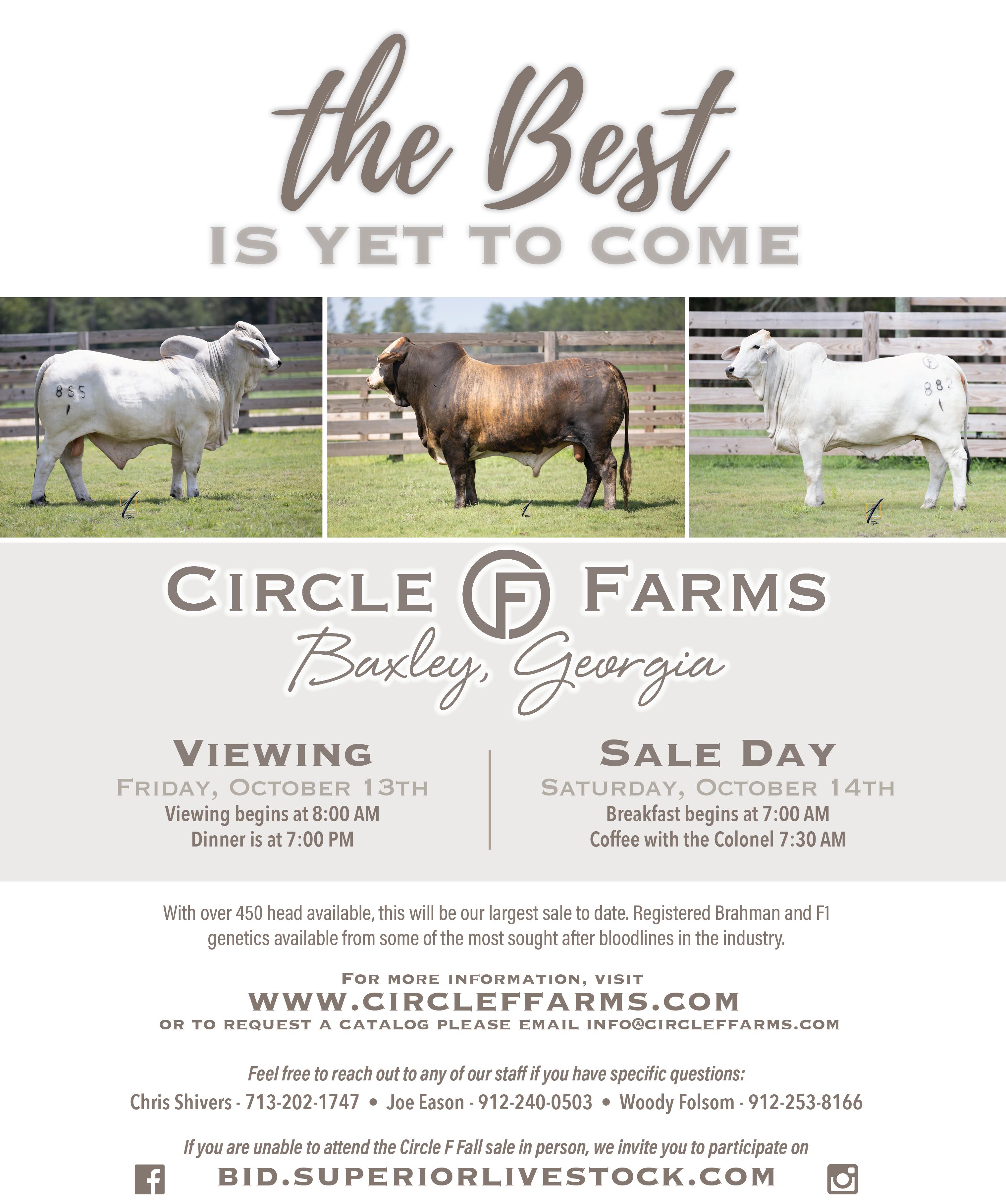
The Carolina Cattle Connection q OCTOBER 2023 PAGE 53
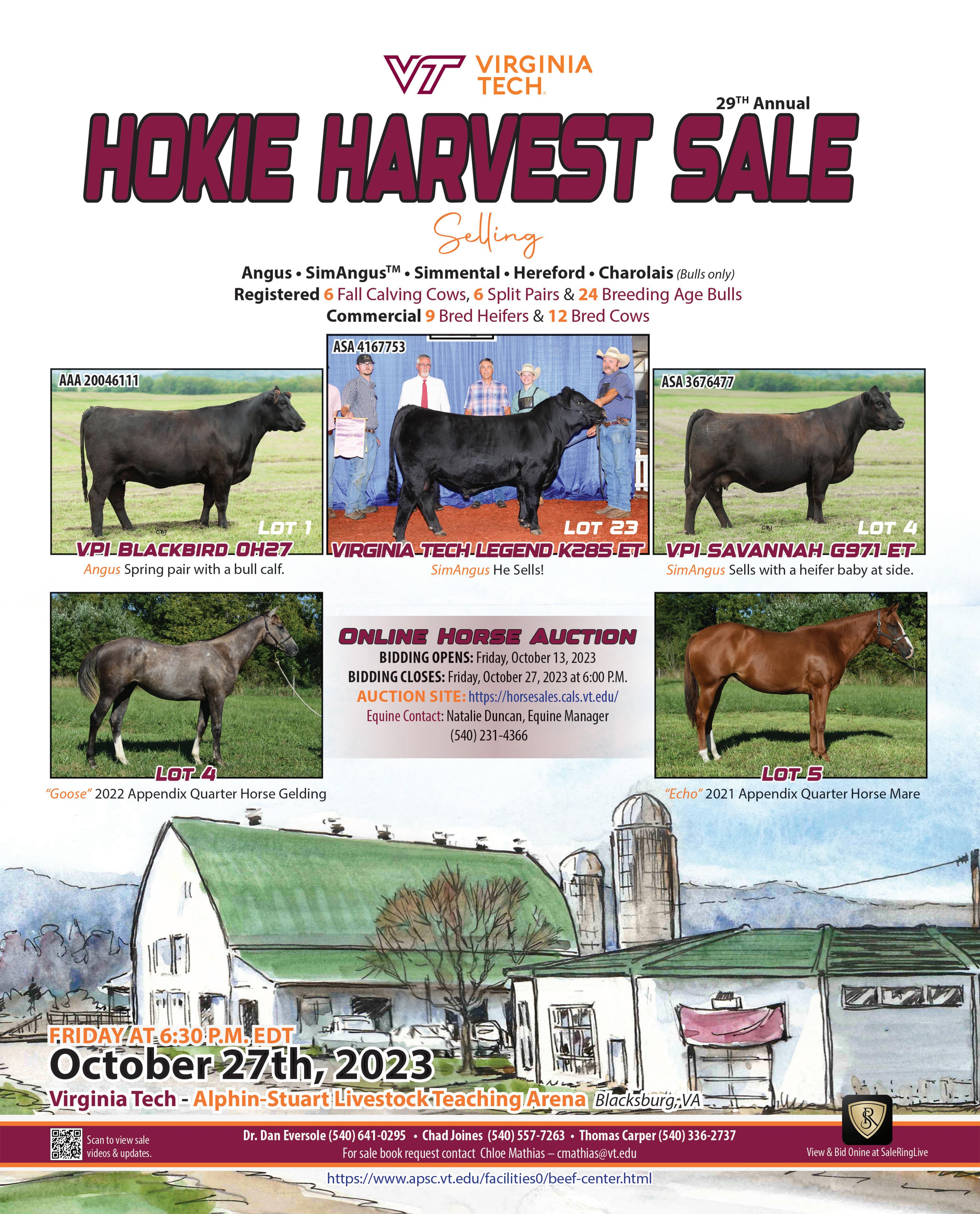
PAGE 54 The Carolina Cattle Connection q OCTOBER 2023

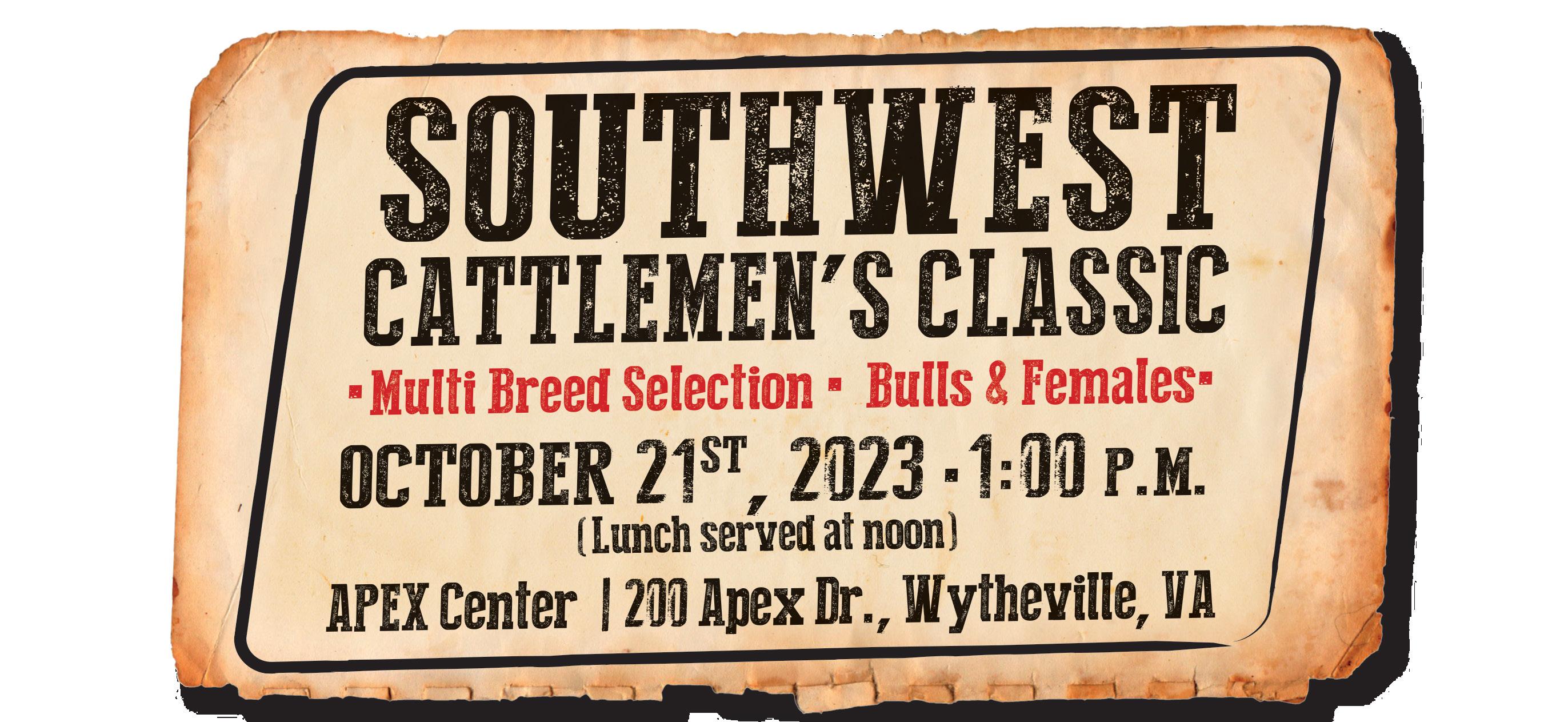






The Carolina Cattle Connection q OCTOBER 2023 PAGE 55

PAGE 56 The Carolina Cattle Connection q OCTOBER 2023
InternatIonal Brangus Breeders assocIatIon news

Nominations Wanted! Nominations are now open for Breeder of the Year, Pioneer of the Year, Commercial Producer of the Year, and Top Hand of the Year awards. Please see the description of each award below and send your nominations to Mandie at the IBBA office at msadovsky@ gobrangus.com by December 29.
To ensure that your nominee receives full and fair consideration, please provide an essay highlighting the achievements, characteristics, and involvement of the nominee. Illustrate how they have advanced the Brangus breed and benefitted fellow breeders. Please do not assume that the Awards Committee knows all the reasons that your nominee should be selected to receive the award.
Breeder of the Year - A current member of the IBBA deserving recognition for his/her achievements with an emphasis on their contribution to the genetic advancement of the Brangus breed.
Pioneer of the Year - Recognizes an IBBA member - past or present - for his/ her service, loyalty, and contributions to the association, their fellow breeders, and the Brangus breed.
Commercial Producer of the Year - Highlights a commercial producer’s achievements incorporating Brangus genetics into their breeding program.
Top Hand of the Year - Recognizes a current member of the IBBA who has gone “above and beyond” in service to their fellow breeders and the Brangus breed during the year.
Want Your Ranch Included?
Attention all IBBA members! Don’t forget to sign up for our breeder map, a valuable tool that can help connect you with potential customers and increase your exposure. By adding your farm or ranch to the map, you’ll be able to showcase your Brangus cattle and breeding program to a wider audience. This is a fantastic opportunity to get your name out there and expand your network of contacts. Let’s work together to promote the Brangus breed and grow our community of breeders.
Learn more and view the map at www.gobrangus.com/breeders/breederdirectory-map . Visit www.gobrangus. com/breeders/create-breeder-profile to build your breeder profile.
Do You Export? Calling all members
who export semen, embryos, and live animals… Through the IBBA’s partnership with USLGE, we have received a few trade leads from CNOG Mexico, held May 2123, ILDEX Phillippines, held June 7-9, AgroExpo Bogota, held July 13-23, and La Rural Buenos Aires, held July 20-30. These are international customers who are interested in Brangus or, generically, beef cattle.
Inquiries are from breeders, producers, consultants, extensions, and other industry contacts. If you are interested in obtaining a copy of this trade lead list in order to reach out to some potential international contacts, please email Macee Prause at mprause@ gobrangus.com requesting this list.

About the International Brangus Breeders Association. The International Brangus Breeders Association, headquartered in San Antonio, Tex., strives to provide the commercial cattle industry, domestically and internationally, with the best genetics possible. Founded in 1949 as the American Brangus Breeders, the organization has since evolved into the IBBA. The IBBA’s purpose is to enable its members to produce quality beef for the commercial cattle industry and its consumers. For more information about IBBA, visit www.gobrangus.com
Carolina Cooking
Cheeseburger Dip
Total Time - 30 minutes
1 pound 90% lean ground beef
¾ cup onion, diced
2 Tablespoon ketchup
8 ounces cream cheese
1½ cups Cheddar cheese
1 Tablespoon Worcestershire sauce
1 teaspoon granulated garlic
1 teaspoon freshly ground black pepper
¾ cup dill pickle, chopped, divided
2 Tablespoon fresh parsley, chopped
¼ cup Roma tomatoes, diced
Heat a nonstick skillet over medium heat until hot. Add ground beef; cook 8-10 minutes, breaking into ¾ inch crumbles and stirring occasionally. Add in onion and continue to cook for 3-4 minutes. Remove from heat and allow to cool.
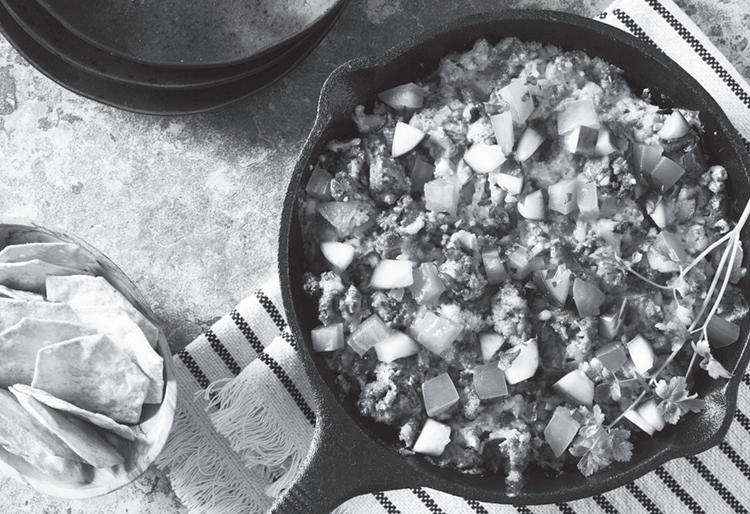
In a standing mixer, combine cream cheese, cheddar cheese, ketchup, Worcestershire sauce, garlic, pepper, and ½ cup of diced pickles until well incorporated. Add cooled beef mixture and mix until well incorporated. Remove bowl from mixer and refrigerate for at least 30 minutes or until ready to bake.

for 25 minutes or until golden brown and edges are bubbling. Remove from oven and top with remaining pickles, parsley, and diced tomatoes. Serve warm with potato chips or crackers.
Makes 12 servings.
Spread the dip into an 8” cast iron or oven proof skillet. Bake in a 375°F oven Cheeseburger Dip
The Carolina Cattle Connection q OCTOBER 2023 PAGE 57
NCBA PresideNt’s rePort
By TODD WILKINSON
National Cattlemen’s Beef Association
Setting the Standard
I’ve had the opportunity to attend various cattlemen’s meetings across the country this summer. The common theme is that, as cattle producers, we’re doing something right. We’re producing a consistent, quality product, we’re promoting it effectively, and we’re staying engaged with decision makers at every level. NCBA has gone toeto-toe with multinational companies, federal regulators, Congress, and deep pocketed animal rights groups to make sure that we have the freedom to operate and a business climate that presents opportunities for profitability. It’s thanks to you, the members of this organization, that we’re able to do that. NCBA continues to set the standard for the cattle industry because its members are willing to gather, share perspectives, discuss the issues, and determine a path forward.

In August, NCBA President Elect Mark Eisele and I had the opportunity to represent NCBA at the Canadian Beef Industry Conference (CBIC) in Calgary hosted by the Canadian Cattle Association (CCA). NCBA participated in multiple CCA committee meetings as well as the U.S.-Canada Bilateral Meeting and a Trilateral Meeting with CCA and the Confederación Nacional de Organizaciones Ganaderas (CNOG) from Mexico. I also had the opportunity to participate in a general session panel discussion with the presidents of both organizations. Key topics discussed throughout the meeting included animal disease preparedness, drought recovery and wildfires, product labeling, cellcultured protein, concerns with European Union policies, and sustainability. I was proud to see NCBA taking the lead and the U.S. setting the standard in several of these areas.
Our efforts to safeguard the industry from threats of foreign animal disease and secure funding for a Foot-and-Mouth Disease (FMD) vaccine bank was a major topic of conversation at this meeting. Canada has been working to set up a
vaccine bank, and earlier this year, the Canadian government allocated funding for the creation of a vaccine bank and preparedness planning. This achievement is important, and we reinforced NCBA’s position of prioritizing animal disease preparedness efforts in the upcoming Farm Bill. In recent years, the Mexican government withdrew its participation in the North American Foot-and-Mouth Disease vaccine bank and has not taken steps to protect the Mexican cattle sector from the growing threat of FMD. NCBA and CCA both emphasized the importance that CNOG continue to advocate for the development of a Mexican FMD vaccine bank. Likewise, all three nations must and will push for greater collaboration of bilateral and trilateral efforts in animal disease preparedness to protect our respective cattle herds.
Most everyone in the northern half of the U.S. has been blanketed by smoke at some point this summer from the Canadian wildfires. When natural disaster strikes, conversations around sustainability often follow, and that topic was the focus of several discussions.
There is a growing threat in Canada that their government may require companies involved in the supply chain to monitor and report greenhouse gas emissions. NCBA was able to provide feedback on similar efforts from the Securities and Exchange Commission in the U.S., underscored the need for alignment and support of accurate emissions methodologies like GWP*, and called on CCA and CNOG to unite in support of GWP*. We all know there is a common misperception about cattle’s role in climate variability, and we need to clearly define how to accurately measure emissions and adopt the GWP* methodology.
Our sustainability story and the U.S. as the model for efficient production practices is not something the European Union (E.U.) likes to give us credit for. The growing threat of subjective
European trade policies was discussed and extends beyond animal health to include animal welfare and climate agendas.
The E.U. is masterful at creating new trade barriers for imported products, like a provision last year that prohibits the importation of food products from animals given antibiotics from an arbitrary list created by the European Commission. This creates a dangerous precedent for future compounds to be added without scientific justification. We also discussed another emerging E.U. trade barrier: certification of deforestation-free products like beef. Even though deforestation is not a problem in the U.S., it will result in additional compliance costs for producers who choose to raise cattle bound for the E.U. market. By simply substituting deforestation with another subjective term, U.S. cattle producers become subject to unfair trade barriers, setting a dangerous precedent that must be addressed.
Shifting to another topic — MCOOL. First, I’d like to make a point. MCOOL supporters argue that market momentum in past cycles was attributable to MCOOL. That’s clearly not the case, as the market this year has been nothing short of phenomenal, and it happened
without MCOOL. The mere suggestion of the U.S. restoring MCOOL triggers an immediate response from CNOG and CCA that their countries will retaliate if necessary. Concerns were also expressed with USDA’s proposed rule on “Product of USA” labels. NCBA reinforced the need for a voluntary, trade compliant solution that allows for verifiable claims through existing USDA-Agricultural Marketing Service programs.
Finally, my favorite thing to talk about — cell cultured crap. This goop is one of the biggest threats to our industry. No matter what they say, it is not climate friendly. We need to make sure it’s properly regulated with a strong set of labeling requirements, ensuring it’s clearly distinguishable from real beef. I was happy to share information about NCBA’s industry leading efforts to do just that. Canadian cattle producers were considering their policy positions on cellcultured products at CBIC.
NCBA is committed to continuing to be at the forefront of discussions with partners in the industry and leading on issues that impact our livelihoods. A sincere thank you to our members for continuing to support the work of this organization.
Purina Animal Nutrition launches scholarship program for students involved in animal agriculture. Applications open through October 12. Purina Animal Nutrition, along with the Land O’Lakes Foundation, is announcing its new scholarship program designed to assist students involved in agriculture and livestock production in pursuing their passions and furthering their educations.

Current undergraduate students who have experience raising and caring for small or large livestock, equine, and/ or poultry are eligible to apply for four $5,000 scholarships. Along with the impact animal agriculture has had on their lives, desired applicants will be able to demonstrate academic excellence, leadership skills, and community involvement and have a clear vision for their future.
Scholarship applications will be accepted through October 12. Awardees will receive their scholarship funds for the Spring 2024 semester at their current educational institution. The scholarship
is open to all undergraduate students enrolled in an accredited two or four year college, university, or vocationaltechnical school.
To learn more about the Feed Greatness Scholarship and apply today, visit www.learnmore.scholarsapply.org/ purina
About Purina Animal Nutrition. Purina is a national organization serving producers, animal owners, and their families through more than 4,700 local cooperatives, independent dealers, and other retailers throughout the United States. Every feed and nutritional product Purina makes is packaged with a purpose: to maintain the integrity of the innovative nutrition inside. Purina is now partnering with forward thinking retailers and producers to give this packaging new life in an effort to leave a lasting legacy and impact for generations to come. Purina Animal Nutrition is headquartered in Arden Hills, Minn., and is a wholly owned subsidiary of Land O’Lakes, Inc. For more information, visit www.purinamills.com
PAGE 58 The Carolina Cattle Connection q OCTOBER 2023 NEWS








The Carolina Cattle Connection q OCTOBER 2023 PAGE 59 • Join one of the largest mineral buying groups in the Southeast • Trial opportunities available • Delivery available in most areas of North Carolina • Make your own buying group in your area THE BARN LOFT 1475 National Highway • Thomasville, NC 27360 Store - 336-886-1737 • Cell - 336-250-0572 www.thebarnloft.com

PAGE 60 The Carolina Cattle Connection q OCTOBER 2023
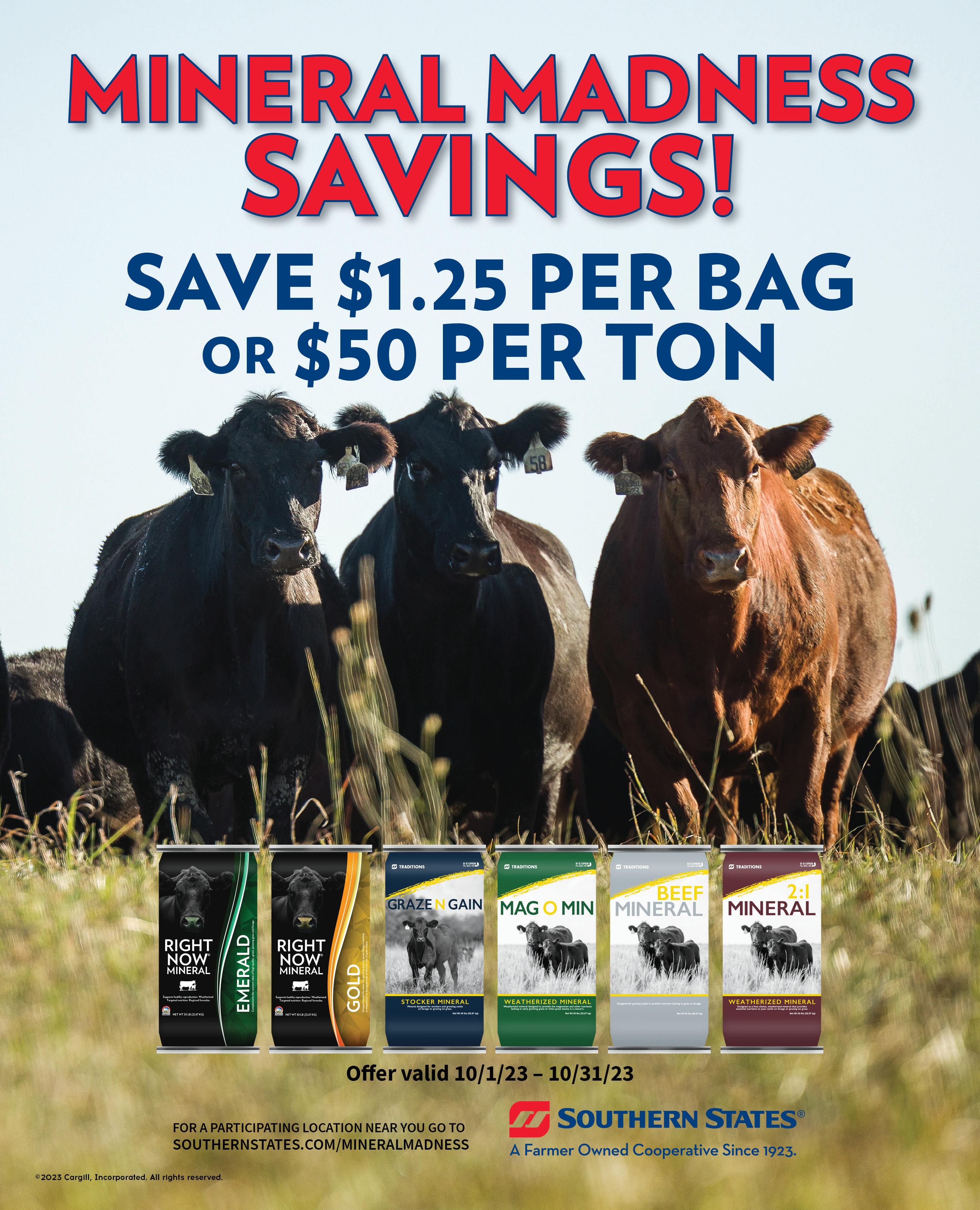
The Carolina Cattle Connection q OCTOBER 2023 PAGE 61
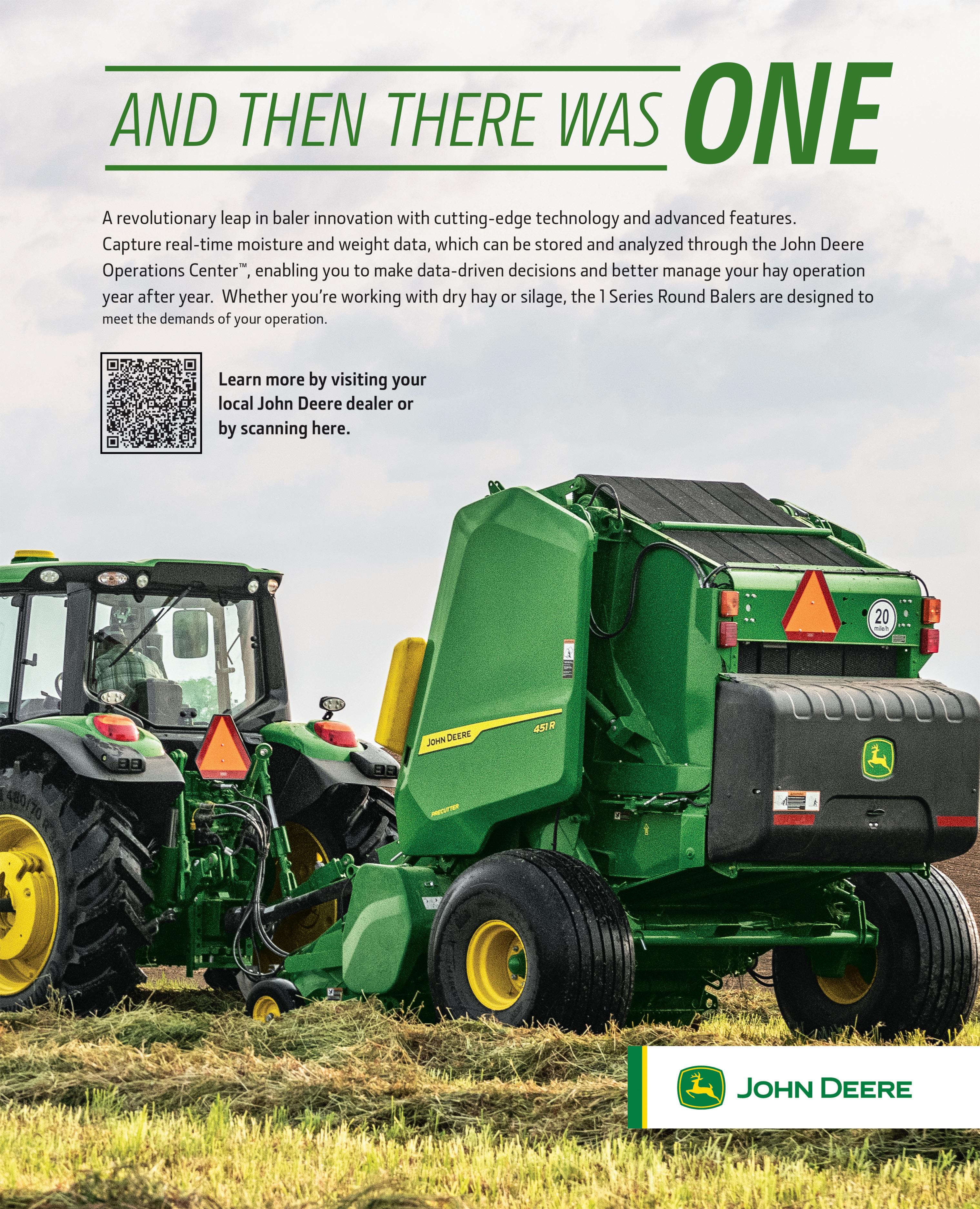
PAGE 62 The Carolina Cattle Connection q OCTOBER 2023
New John Deere 1 Series Round Balers are fast and efficient while capturing important bale data. John Deere’s new 1 Series Round Balers help farmers ensure optimal moisture levels and consistent bale weights are maintained in every field, in every windrow, and with every bale.
The 1 Series features innovative Bale Doc technology to document bale moisture and weight in near real time. That data can then flow into the John Deere Operations Center for post harvest analysis. After analysis is completed, farmers can make informed decisions about nutrient management or use the data to help get the best prices possible for their bales or to reduce fertilizer costs.
“No matter what the size of your operation, John Deere offers a 1 Series Round Baler that delivers consistent, high quality round bales,” said Chase Milem, marketing manager for John Deere. “Operators can see in real time what the moisture levels are of the bales they are making, right from the cab. This is information farmers can use to decide if they need to stop baling for the day, or whether they should apply a preservative like John Deere GREEN-GARD.”
John Deere 1 Series Round Balers also reduce operator fatigue thanks to integrated technology that automates gate cycle functions. Baler Automation automatically opens and closes the gate at the right time, eliminating repetitive tasks, reducing operator error, and minimizing downtime, helping farmers get the most bales as quickly as possible. Regardless of the age of their tractor, Milem said there are many good reasons for farmers to upgrade to the 1 Series, considering Baler Automation compatibility.
A new, standard 8 inch G5e display provides operators with an easy-tolearn, consistent experience, giving them total visibility and control over baling operations. The 1 Series also features a new optional High Capacity Pickup to help farmers finish baling more quickly compared to previous models. Internal testing showed the high capacity pickup was able to pick up and feed crop with up to 33 percent increased capacity compared to previous models.
“Customers said reliability, serviceability, and productivity were three important factors for them when considering the purchase of a new round baler,” Milem said. “We took what farmers liked most about our previous round balers and added new features to boost their baling capacity and new technology to better help farmers make informed agronomic decisions based on real time data.”
The John Deere 1 Series Round Baler lineup includes the 451E, 451M, 451R, 461M, 461R, 551M, 561M, and 561R. The “E” model designates the baler is equipped with a regular pickup; the “M” denotes the baler is equipped with the MegaWide Plus pickup, and the “R” model shows the round baler is equipped with the High Capacity or the High Capacity and Precutting feeding system.
Net Lift Assist, Net Lighting, and a Preservative System are options available for the 1 Series. With Net Lift Assist, there is a 90 percent reduction in lifting effort as the connecting linkage attaches to the netwrap handles and the netwrap roll is moved into position. Net Lighting illuminates the netwrap and wrapping components, making it easy to reload the baler in low light conditions. The
Preservative System for the 1 Series utilizes a tank, sensors, controller, and distribution system to ensure the right amount of preservative is applied to each bale.
To learn more about John Deere 1 Series Round Balers, visit www.JohnDeere. com or contact your local John Deere dealer.

About John Deere. Deere & Company is a global leader in the delivery of agricultural, turf, construction, and forestry equipment. We help our customers push the boundaries of what’s possible in ways that are more productive and sustainable to help life leap forward. Our technology enabled products, including John Deere Autonomous 8R Tractor, See & Spray, and E-Power Backhoe, are just some of the ways we help meet the world’s increasing need for food, shelter,
and infrastructure. Deere & Company also provides financial services through John Deere Financial. For more information on Deere & Company, visit us at www.deere.com
Don’t get caught napping! Deadline is 5th of month prior to issue!

NCBA News
NCBA Statement on Updated WOTUS Rule. Recently, National Cattlemen’s Beef Association (NCBA) Chief Counsel Mary-Thomas Hart released a statement following the Environmental Protection Agency’s revised Waters of the United States (WOTUS) rule that is intended to conform with the Supreme Court’s decision in Sackett v. EPA:

“The entire cattle industry breathed a sigh of relief when the Supreme Court curtailed the EPA’s overreach under the Clean Water Act. The revised WOTUS definition is an important step toward bringing the EPA more in line with the Supreme Court’s ruling. NCBA looks forward to working with the agency to protect farmers and ranchers from
2023 South Carolina Sale Barn Cattle Receipts
burdensome regulations and provide them with lasting certainty on WOTUS.
“NCBA was proud to lead the fight against burdensome WOTUS rules from Congress to the courts. We will continue analyzing this latest development to ensure that cattle producers are protected.”
About the National Cattlemen’s Beef Association. NCBA has represented America’s cattle producers since 1898, preserving the heritage and strength of the industry through education and public policy. As the largest association of cattle producers, NCBA works to create new markets and increase demand for beef. Efforts are made possible through membership contributions. To join, contact NCBA at 866-BEEF-USA or membership@beef.org
The Carolina Cattle Connection q OCTOBER 2023 PAGE 63
NEWS
January February March April May June July August September October November December Darlington 1,205 1,103 2,424 1,360 1,973 1,547 921 1,789 Laurens 1,755 1,219 1,619 1,506 1,593 1,616 911 1,484 Orangeburg 998 1,093 1,214 966 1,308 936 778 1,032 Saluda 2,785 2,511 2,739 2,670 3,311 3,585 2,122 3,854 Williamston 2,646 2,220 2,975 2,321 2,413 3,000 1,848 2,938
NEWS
Study Shows First Year Management Practices Critical to Maximizing Alfalfa Yield. Why is the reported average yield of alfalfa for U.S. farms well below the potential of what growers could actually produce? This is not only a question asked by many alfalfa farmers but many researchers as well – and one which the Alfalfa Checkoff funded study, “Closing the Alfalfa Yield Gap While Improving Soil Fertility and Health,” sought to answer.
The National Alfalfa & Forage Alliance established the Alfalfa Checkoff, also known as the U.S. Alfalfa Farmer Research Initiative (USAFRI), to facilitate a farmer funded program to advance industry research. NAFA’s Alfalfa Checkoff funds alfalfa related research to help drive innovation and profitability in the alfalfa industry and to support public research into alfalfa and alfalfa forage systems.
“The goal of our project was to identify critical relationships between alfalfa yields, management practices, and soil fertility and health indicators, through a management survey that identified farms with high alfalfa yields and the production practices they used,” said Principal Investigator Nicole Tautges, Agroecology Program Director at the Michael Fields Agricultural Institute. “We felt a better understanding of common management practices, especially on high yielding operations, and key
differences among alfalfa farms, could help to reverse the recent declining trends of alfalfa production and reinvigorate the perception of alfalfa as a highly productive and efficient crop.”
After the analysis of all the variables associated with higher productivity of alfalfa, the study found the management practices that maximized alfalfa yields most in this study were a greater number of cuts per season, manure application, and the use of potassium (K) and sulfur (S) in the first year, suggesting that nutrient application in the establishment year is positively associated with greater alfalfa yields throughout the life of the stand.
Additionally, strong positive relationships emerged between soil carbon pools (soil organic matter and permanganate oxidizable or active carbon) and critical soil components for alfalfa growth, including pH, K, S, calcium, and cation exchange capacity (CEC). Furthermore, soil microorganisms showed potential positive associations with SOM, highlighting their role in maintaining healthy soils.
Tautges added, “Overall, these findings highlight the significance of maintaining a good nutrient supply to ensure higher alfalfa yields throughout the stand’s life and suggest that a fertile and healthy soil condition characterized by balanced nutrient availability, active microbial communities, and positive interactions among soil
components, can provide a favorable soil environment for alfalfa productivity.”
For a full copy of the project’s final report, located on NAFA’s Alfalfa Checkoff Final Reports page, visit https://alfalfa.org/pdf/USAFRI/Final Reports/2020/20-1Tautges.pdf. A handy two page summary can be found at https://alfalfa.org/pdf/USAFRI/Final Reports/2020/Tautges-2page-2020-1.pdf
About the National Alfalfa & Forage Alliance. Formed in 2006, NAFA is an umbrella organization of state and regional alfalfa seed and alfalfa hay associations, genetic suppliers, seed marketers, and allied industry members dedicated to promoting the interests of the nation’s alfalfa, alfalfa seed, and forage producers through education, research, promotion, and advocacy.
NAFA’s primary focus is issue advocacy and policy development/implementation
in all areas affecting the alfalfa seed and forage industry, such as federal research funding, farm policy, agricultural coexistence, crop insurance, environmental regulation, and biotechnology.
NAFA educational activities focus on its highly respected and popular Alfalfa Intensive Training Seminar, held each fall and featuring the latest information with regard to genetics, varieties, seed production, growth and development, soils, fertility, management, and a host of other topics intended to give participants the knowledge they need to make the most of their alfalfa investment.
NAFA is governed by a 27 member board of directors, which includes alfalfa seed and forage producers, university researchers, and representatives from allied industry organizations who guide the direction of NAFA activities.
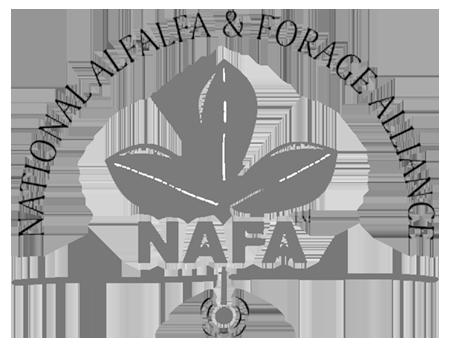
FORAGE NEWS

S.C. Forage & Grazing Lands Coalition Annual Meeting
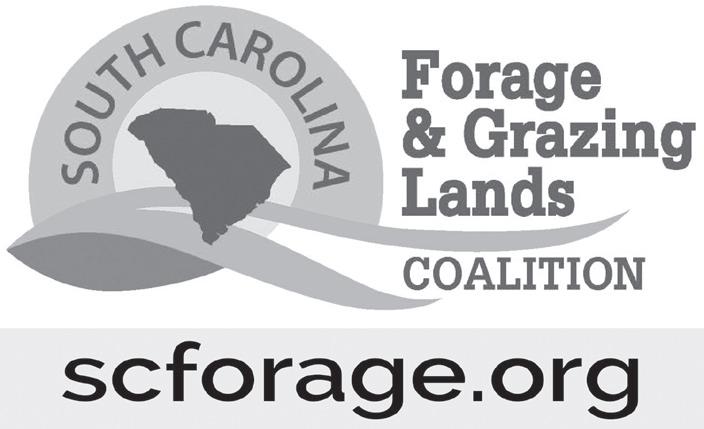
Renowned grazing expert Jim Gerrish will be the featured speaker at the S.C. Forage and Grazing Lands Coalition annual meeting on October 25 at the S.C. Farmers Market. Members and the public are invited. There will also be presentations on native warm season grasses and cover crop/grazing partnerships. Lunch is included. For details and sign-up, visit www.scforage.org/annual-meeting
Gerrish is an independent grazing lands consultant providing services to farmers and ranchers on public and private lands across five continents.
He has written a regular monthly column in The Stockman Grass-Farmer magazine for over 12 years. He has authored two books on grazing and ranch management. Management intensive Grazing: The Grassroots of Grass Farming was published in 2004, and Kick the Hay Habit: A Practical Guide to Year Round Grazing was published in 2010.
Gerrish was co-founder of the popular three-day grazing management workshop program at the University of Missouri Forage Research Systems Center. These schools were attended by over 3,000 producers and educators from 39 states and 4 Canadian provinces from their inception in 1990 through
2003. There are 15 other states that have conducted grazing workshops based on the Missouri model, and Jim has taught in 11 of these states. He is an instructor at the University of Idaho’s Lost River Grazing Academy, held twice annually near Salmon, Idaho. He typically speaks at 40-50 producer oriented workshops, seminars, and field days around the United States and Canada each year.
About the S.C. Forage & Grass Lands Coalition The SCFGLC is a non-profit group that works closely with the Natural Resources Conservation Service, Clemson University Extension, and other partners to promote the health and sustainability of South Carolina grazing lands. Workshops and events cover areas such as soil health for grazing management practices on pastureland, forestland, and cropland; prescribed grazing; silvopasture; and other conservation interests.
PAGE 64 The Carolina Cattle Connection q OCTOBER 2023
I got
in
Check out the expert A.I, superior genetics, fine purebreds and terrific farm supplies offered!
a great buy
the Classifieds in The Carolina Cattle Connection!

The Carolina Cattle Connection q OCTOBER 2023 PAGE 65
A MessAge froM the Ceo
By COLIN WOODALL National Cattlemen’s Beef Association

As Grassroots as It Gets
Throughout our 125 year history, NCBA’s grassroots policy development process has been critical to our effectiveness and success in being the trusted leader and definitive voice of the U.S. cattle and beef industry. If anyone doubts we are cattle producer driven and led, then they definitely were not in attendance at the NCBA board meeting held during the Cattle Industry Summer Business Meeting in San Diego in July. Producer engagement and decision making were on full display.
NCBA’s process is simple but effective. Twice a year, NCBA members meet to decide what policy positions they want to take. The first opportunity is at CattleCon each winter and then again during the Summer Business Meeting like the one we recently conducted. As part of these meetings, NCBA’s policy committees convene to discuss the hot topics the industry is facing. Our policy committees, Live Cattle Marketing, Agriculture & Food Policy, Tax & Credit, Federal Lands, Property Rights & Environmental Management, International Trade, and Cattle Health & Wellbeing, cover all the significant issue areas we engage in. These committees are led by a chair and vice chair nominated by their states and appointed by the NCBA officer team. The committees are made up of producers designated by their state associations to represent them and engage in debate.
The policy committee meetings typically include several speakers to discuss committee-related subjects or to provide updates on the actions of working groups or task forces created by the committee or NCBA leadership. Then, they transition to the consideration of resolutions. Like many membership organizations, parliamentary procedure based on Robert’s Rules of Order are used to guide the process. Committee members can bring resolutions to the floor to discuss an action the committee member would like NCBA to take. Resolutions can result in a policy that takes a stance
on a specific topic, a recommendation for NCBA to take some particular action or a directive that tells NCBA staff to complete a certain task. The resolution is debated and voted on. If the policy committee votes to adopt the resolution, it then goes to NCBA’s Resolutions Committee.
The Resolutions Committee reviews the resolution for grammar and flow and to determine if it conflicts with other policies or is duplicative of existing policy. The Resolutions Committee cannot make any changes to the intent of the resolution. Once it is through the resolution process, the proposed policy is considered by the policy division of the NCBA Board of Directors. If the board approves the policy during convention, that policy is considered interim in nature and must come up again during the Summer Business Meeting. In addition, all expiring policies come up for review during the summer meeting. NCBA’s policies are only good for five years before they must be renewed or allowed to expire. Finally, every resolution, interim policy, or expiring policy passed by the board goes out to all NCBA members to be voted on.
Once every NCBA member has a chance to vote on the proposed policies, they are finalized and published in our policy book in early January. This policy book is what guides our action on all the issues discussed and is the playbook used by our team in Washington, D.C.
In San Diego, we saw all aspects of the policy making process play out. There was intense debate during the Live Cattle Marketing Committee, which led to roll call votes. During the Resolutions Committee review, it was determined that two of the resolutions passed out of Live Cattle Marketing conflicted with each other, and the NCBA board would need to decide how to handle them. After more debate among the board, we saw some of the closest votes to happen during our board meeting in many years. Ultimately, it was decided the conflicting policies needed to go back to the Live
Cattle Marketing Committee to be sorted out when they meet during CattleCon24 in Orlando.
In each step of the process, it was NCBA’s producer members who debated, voted, and made the decision on what the association needs to do. Each time a
vote was held, every single vote counted and made a difference in the outcome. Whether you make it to the policy committees or not, you now have the opportunity to be heard, so I encourage you to fill out the ballot. That is the grassroots strength of NCBA.
News
Get more out of your cover crops with Renovo Seed’s Rye Cocktails. It’s prime cover crop planting season, a time when farmers can feel at a loss when it comes to seed choices. A desire to simplify and improve that decision making with cover crop mixes that work for both livestock operations and grain farms inspired Renovo Seed’s Rye Cocktail mixes.
Each proprietary mix is anchored with hearty rye, a winter annual and nutrient catching cover crop workhorse that does well both in the Upper Midwest and Corn Belt states. The Rye Cocktails add other broadleaves and legumes based on a producer’s specific end goal, such as increasing soil biology and plant diversity or decreasing water erosion.
“Cover crops add diversity with multiple species in one planting,” explains Renovo Seed Product Expert Justin Fruechte. “That improves land resiliency and helps mitigate risk stemming from each season’s unique weather, weed, and pest challenges.”
“No matter the situation, you’re giving yourself an opportunity to be covered,” he adds. “Pun intended.”
It starts with a need - Most farmers, ranchers, and landowners try a cover crop after being presented with a need — often a livestock farmer in need of feed, according to Fruechte. “If that farmer is going to plant rye as a forage, it makes sense to add something to it to make it work even harder.”
That was the case for David Larson, a row crop and beef producer in Stevens County, Minnesota. He used the Mellow Maker Rye Cocktail in a field where cattle grazed over winter and corn followed in spring. “The seedbed was much better and more ideal to plant into,” shares Larson. “The corn came out of the ground
faster and with a better stand. It tasseled earlier. I even had a slight increase in yield.”
The long term return on investment is building organic matter, Larson says. “I want the soil to be here for the next couple hundred years and as healthy and productive as possible.”
Those results don’t surprise Fruechte. The Mellow Maker Rye Cocktail is made for acres that need increased water infiltration and decreased compaction. The cocktail’s radish, turnip, and rapeseed work together to create alleyways for water to seep into the soil. Species in this mix also work to suppress weeds and keep necessary nutrients in the soil for cash crops.
A smarter way to use cover cropsRenovo Seed’s expert team and robust supply chain have simplified the buying process and taken out the guesswork of trying cover crops. Other cocktail mixes include the All American, a good all around mix that builds nitrogen levels for cash crops to utilize, and Winter Wonder, which gets fields ready for a green spring and minimizes early weeds.
Farmers, ranchers, and landowners can learn more about how Renovo Seed and its pre-built seed mixes can help mitigate risk, maximize profitability, and establish long-term resiliency at www. renovoseed.com
About Renovo Seed. Renovo Seed enters the seed industry as a visionary in positive land use solutions. Backed by Millborn’s powerful supply chain, Renovo Seed works to improve the resiliency of the land for generations to come with a robust seed lineup and unmatched team of experts who design practical, tailored solutions for farmers, ranchers, and landowners. For more information, visit www.renovoseed.com

PAGE 66 The Carolina Cattle Connection q OCTOBER 2023

The Carolina Cattle Connection q OCTOBER 2023 PAGE 67

PAGE 68 The Carolina Cattle Connection q OCTOBER 2023

The Carolina Cattle Connection q OCTOBER 2023 PAGE 69
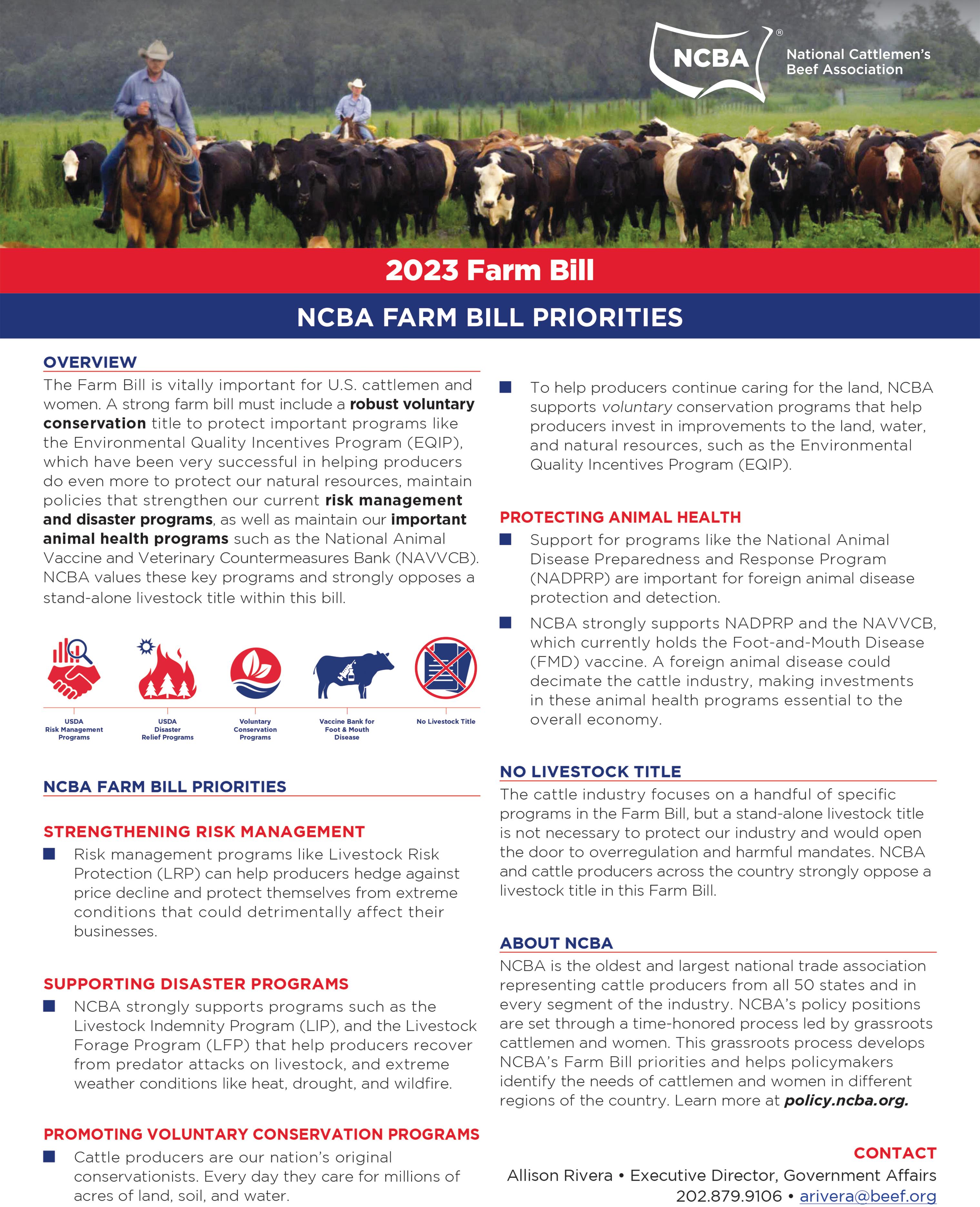
PAGE 70 The Carolina Cattle Connection q OCTOBER 2023
Cattlemen’s Beef Board Update
Beef Promotion Operation Committee Approves Fiscal Year 2024 Checkoff Plan of Work. The Cattlemen’s Beef Board (CBB) will invest approximately $38 million into programs of beef promotion, research, consumer information, industry information, foreign marketing, and producer communications during fiscal 2024, subject to USDA approval.
In action at the end of its September 6-7 meeting in Denver, Colorado, the Beef Promotion Operating Committee (BPOC) approved Checkoff funding for a total of 12 “Authorization Requests” – or grant proposals – for the fiscal year beginning October 1. The committee, which includes ten producers and importers from the Cattlemen’s Beef Board and ten producers from the Federation of State Beef Councils, also recommended full Cattlemen’s Beef Board approval of a budget amendment to reflect the split of funding between budget categories affected by their decisions.
Nine contractors and three subcontractors brought 15 Authorization Requests worth approximately $49 million to the BPOC this week, roughly $11 million more than the funds available from the CBB budget.
“We’re consistently impressed with the proposals that our contractors bring forward each year, and choosing which initiatives to fund is a real challenge,” said Jimmy Taylor, CBB and BPOC chair. “Our budget amounts to slightly less each year because of inflation. To put it in perspective, a dollar in 1985 is worth just 35¢1 today. That means we simply don’t have the buying power that we had when this program first started.
“As we expected, the Authorization Requests we reviewed this week were full of new ideas and innovative approaches supporting the Checkoff’s core programs of research, promotion, foreign marketing, industry information, consumer information, and producer communications. Our committee did a great job of balancing our budget and distributing our limited funds in what we believe is the most optimal way possible. I personally thank our contractors and committee members for all their hard work, and I look forward to future Checkoff successes throughout FY24.”
In the end, the BPOC approved proposals from eight national beef organizations for funding through the
FY24 Cattlemen’s Beef Board budget, as follows:
• American Farm Bureau Foundation for Agriculture - $800,000
• Cattlemen’s Beef Board - $1,800,000
• Foundation for Meat and Poultry Research and Education - $500,000
• Meat Import Council of America/ Northeast Beef Promotion Initiative$900,000
• National Cattlemen’s Beef Association - $25,405,000
• National Institute for Animal Agriculture - $60,000
• North American Meat Institute$330,000
• United States Meat Export Federation - $8,150,000
Broken out by budget component –as outlined by the Beef Promotion and Research Act of 1985 – the FY24 Plan of Work for the Cattlemen’s Beef Promotion and Research Board budget includes:
• $9,275,000 for promotion programs, including beef and veal campaigns focusing on beef’s nutritional value, eating experience, convenience, and production.
• $8,300,000 for research programs focusing on pre and post harvest beef safety, scientific affairs, nutrition, sustainability, product quality, culinary technical expertise, and consumer perceptions.
• $7,600,550 for consumer information programs, including Northeast influencer outreach and public relations initiatives; national consumer public relations, including nutrition influencer relations; and work with primary- and secondary school curriculum directors nationwide to get accurate information about the beef industry into classrooms of today’s youth. Additional initiatives include outreach and engagement with food, culinary, nutrition, and health thought leaders; media and public relations efforts; and supply chain engagement.
• $2,819,450 for industry information programs, including dissemination of accurate information about the beef industry to counter misinformation from other groups, as well as funding for Checkoff participation in the annual national industrywide symposium about antibiotic use. Additional efforts in this program area include beef advocacy training and issues/crisis management and response.
• $8,150,000 for foreign marketing
and education, focusing on 13 regions, representing more than 90 countries around the world.
• $1,800,000 for producer communications, which includes investor outreach using national communications and direct communications to producers and importers about Checkoff results. Elements of this program include ongoing producer listening and analysis, industry collaboration and outreach, and continued development of a publishing strategy and platform and a state beef council content hub.
The full fiscal 2024 Cattlemen’s Beef Board budget is approximately $42 million. Separate from the Authorization Requests, other expenses funded include $270,000 for program evaluation, $640,500 for program development,
$200,000 for Checkoff education resources, $550,000 for USDA oversight, $205,000 for state services, $270,000 supporting services and litigation; and $2.0 million for CBB administration. The fiscal 2024 program budget represents a decrease of slightly less than 1.6 percent, or $605,000, from the $38.6 million FY23 budget.
For more information about the Beef Checkoff and its programs, including promotion, research, foreign marketing, industry information, consumer information, and safety, contact the Cattlemen’s Beef Board at 303-220-9890 or visit www.DrivingDemandForBeef. com
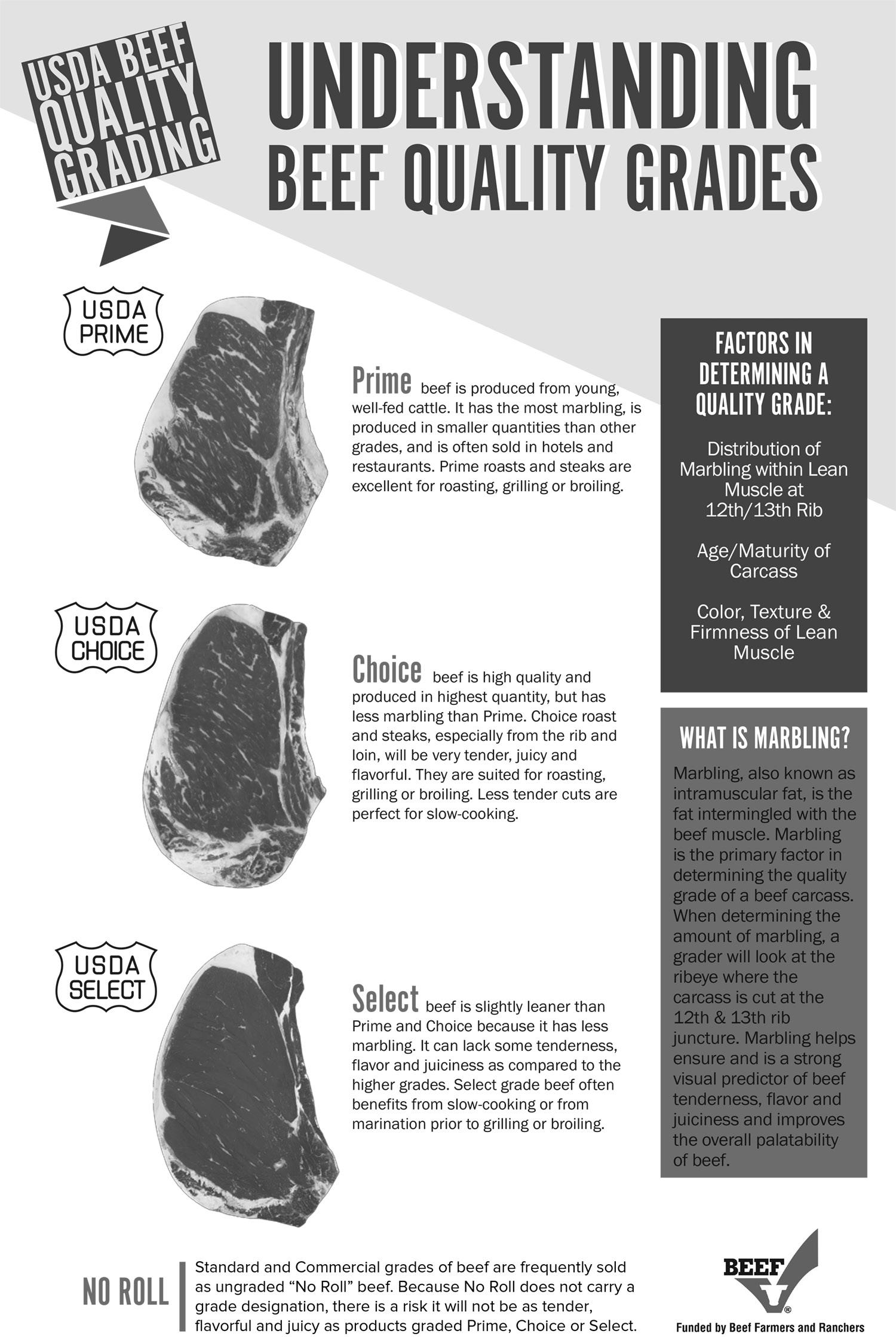
Reference
1Source: January 2023 Consumer Price Index Inflation Calculator
The Carolina Cattle Connection q OCTOBER 2023 PAGE 71
2023 N.C Junior Beef Round-Up Results

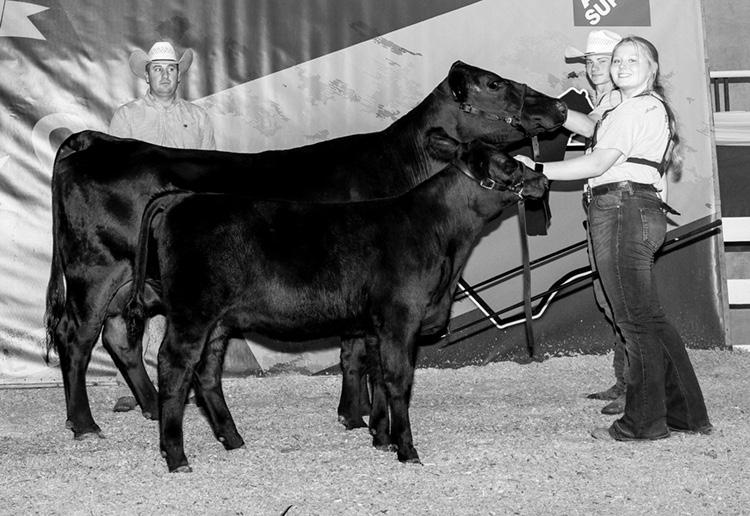



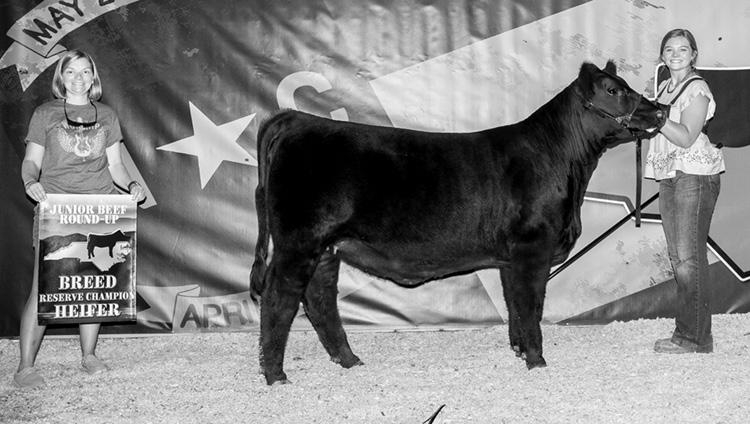



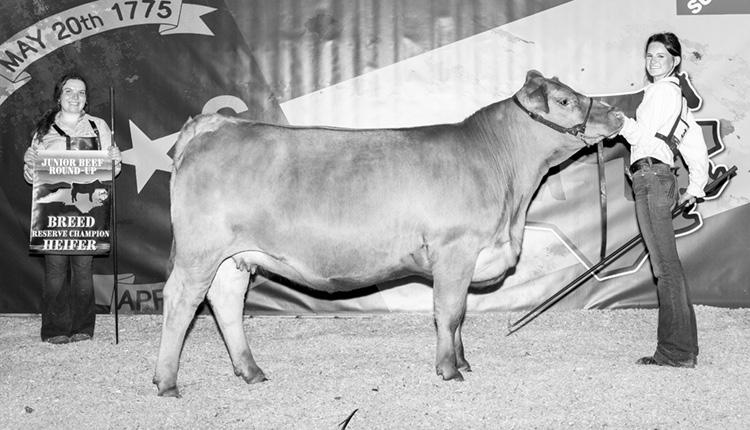


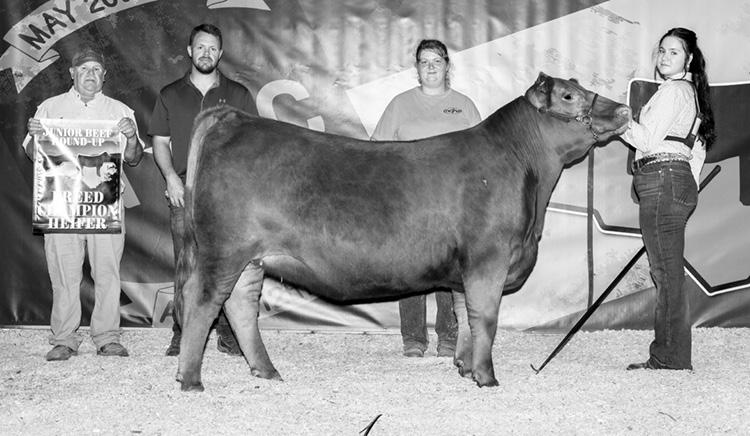

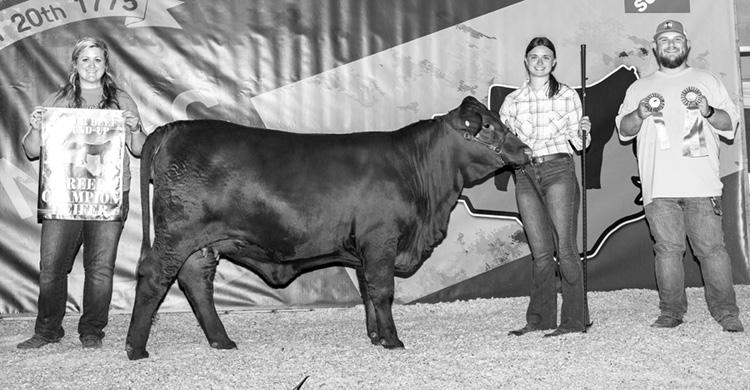


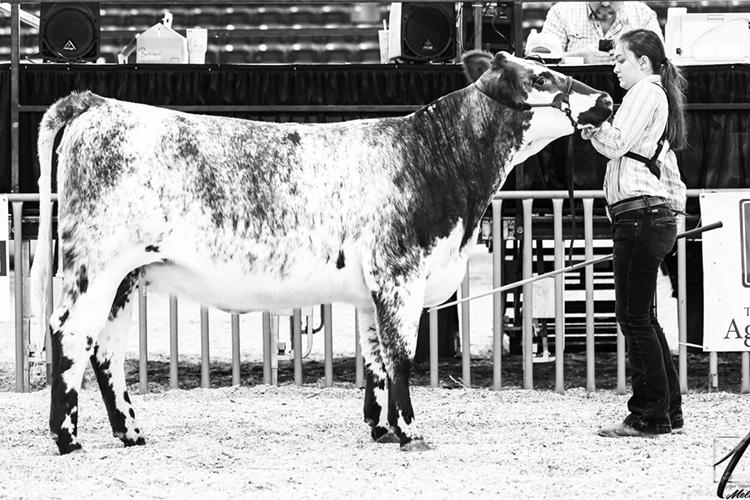
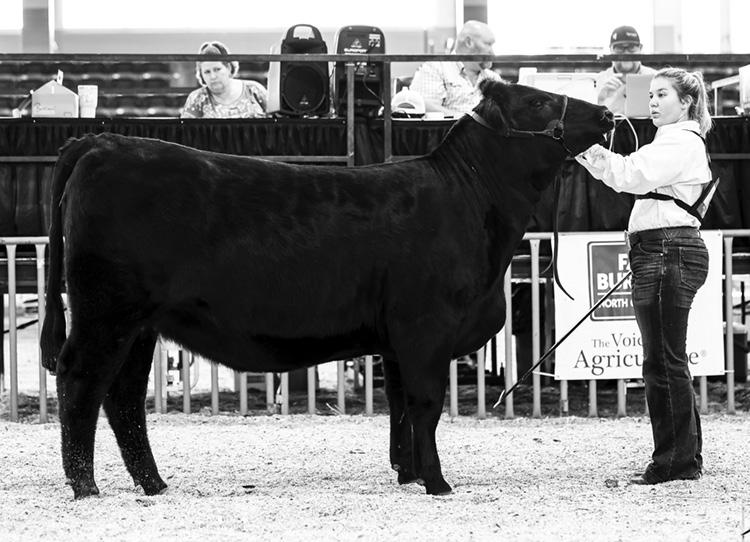
PAGE 72 The Carolina Cattle Connection q OCTOBER 2023
Grand champion Simmental heifer, shown by Marcie Harward
Reserve champion Shorthorn heifer, shown by Rylea Suddreth
Grand champion Shorthorn heifer, shown by Trey Davis
Reserve champion Santa Gertrudis heifer, shown by Jonathan Rathbone
Grand champion Santa Gertrudis heifer, shown by Madelyn Snead
Reserve champion Red Angus heifer, shown by Rex Howard
Grand champion Red Angus heifer, shown by Abigail Edwards
Reserve champion Hereford heifer, shown by Jordan Mitchem
Grand champion Hereford heifer, shown by Mattie Harward
Reserve champion Gelbvieh heifer, shown by Molly Anderson
Grand champion Gelbvieh heifer, shown by Molly Anderson
Reserve champion Commercial heifer, shown by Rex Howard
Grand champion Commercial & 3rd overall heifer, shown by Mattie Harward
Reserve champion AOB, shown by Hannah Smith
Grand champion AOB & supreme champion heifer, shown by Shane Kendall
Reserve champion Angus, shown by Maddie Carpenter
Grand champion Angus & 4th overall heifer, shown by Emma Vanhoy
ALL Regular Copy for the NOVEMBER ISSUE by OCTOBER 5! ALL Spotlight Material for the NOVEMBER ISSUE By OCTOBER 1!
Grand champion Commercial & reserve supreme cow/calf pair, shown by Shane Kendall
Novice

New NCCA Members for 2023
In 2007, the NCCA Membership

Committee passed a resolution to recognize all NEW members, defined as someone who has never been a member or has rejoined after a break in membership, in The Carolina Cattle Connection. Below are NCCA’s new members for the last month:
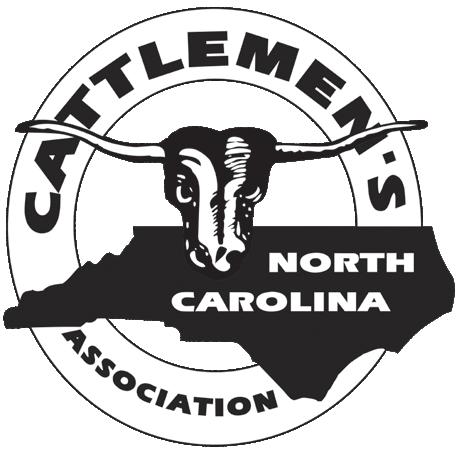
Anson
John Crawford – Lanes Creek Farm
Catawba County
Terrance Hood – Hood Family Farms
Cleveland County
Meghan Barelick
Myron Edwards
Gary & Karen Grigg– Grigg Braunvieh Farm
Bill Hoyle
John B. Lattimore – John Lattimore Farm
Gene McCurry
Cody McCurry – McCurry Farms
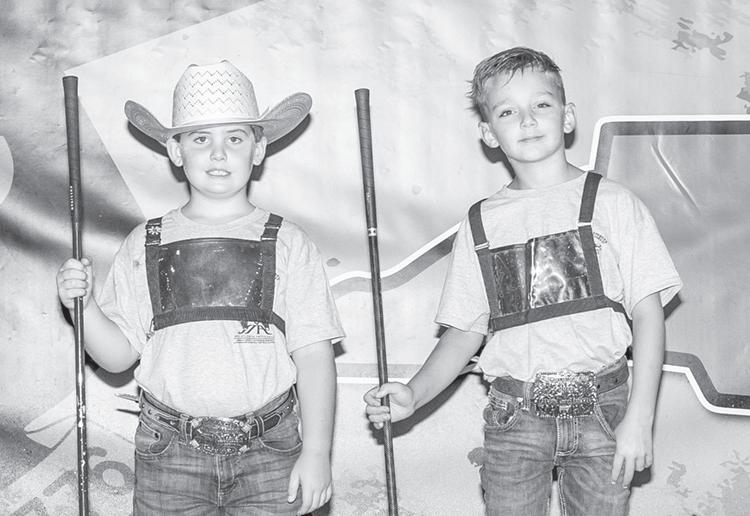
Dan O’Shields
Ben Roy Ousley, DVM – Circle BR Farm
Donald S. Peeler – Grassy Branch Farms
Greyson Peeler
Butch & Dee Dee Pfeifer


Steve Weathers
Paul Wilson
Davidson County
Chris Nobles – C&G
Duplin County
Marlee Maready – Maready Farms

Gaston County
Joseph Lineberger – Triple J Farm
Lincoln County
Mark Parker
Randolph County
Scott Dunbar – CR Farms






Rutherford County
Jerry and Brenda Smith – Scenic View Farms
Vance County
Hope Crabtree – Crabtree Farms
Chris Vick – Circle V Farms
Hunter Wilson
Wake County
Katie Williams
The Carolina Cattle Connection q OCTOBER 2023 PAGE 73
Reserve champion Steer, shown by Hope Latta
Grand champion Steer, shown by Emily Oberman
Reserve champion Percentage Simmental & 5th overall heifer, shown by Trey Davis
Grand champion Percentage Simmental & reserve supreme heifer, shown by Trey Davis
Reserve champion Simmental heifer, shown by Cullen Joines
Grand champion Simmental & supreme champion cow/calf pair, shown by Rylea Suddreth
showmanship - grand champion Trey Davis & reserve champion Carter Slate
Senior showmanship - grand champion Shane Kendall & reserve champion Rex Howard
Intermediate showmanship - grand champion Ky Alford & reserve champion Jordan Mitchem
Junior showmanship - grand champion Blain Abruzzino & reserve champion Addison Revis
Pasture Management Systems, Inc.
MILE OF FENCE PROGRAM

New Members by County in 2023 (as of 9-12-23)
Grand Total 859
PAGE 74 The Carolina Cattle Connection q OCTOBER 2023
Alamance 3 Alexander 2 Alleghany 2 Anson 4 Ashe 3 Avery 0 Beaufort 2 Bertie 1 Bladen 0 Brunswick 2 Buncombe 87 Burke 2 Cabarrus 3 Caldwell 1 Camden 23 Carteret 0 Caswell 1 Catawba 9 Chatham 8 Cherokee 2 Chowan 0 Clay 0 Cleveland 20 Columbus 1 Craven 1 Cumberland 2 Currituck 0 Dare 0 Davidson 6 Davie 3 Duplin 11 Durham 1 Edgecombe 3 Forsyth 4 Franklin 14 Gaston 3 Gates 0 Graham 0 Granville 4 Greene 3 Guilford 7 Halifax 12 Harnett 2 Haywood 77 Henderson 59 Hertford 0 Hoke 0 Hyde 0 Iredell 7 Jackson 2 Johnston 8 Jones 0 Lee 2 Lenoir 1 Lincoln 7 McDowell 4 Macon 42 Martin 1 Madison 3 Mecklenburg 1 Mitchell 0 Montgomery 0 Moore 3 Nash 5 New Hanover 0 Northampton 1 Onslow 3 Orange 2 Pamlico 0 Pasquotank 0 Pender 1 Perquimans 64 Person 5 Pitt 5 Polk 4 Randolph 79 Richmond 2 Robeson 2 Rockingham 30 Rowan 4 Rutherford 3 Sampson 4 Scotland 0 Stanly 0 Stokes 44 Surry 7 Swain 1 Transylvania 23 Tyrrell 0 Union 10 Vance 3 Wake 10 Warren 5 Washington 0 Watauga 4 Wayne 5 Wilkes 5 Wilson 57 Yadkin 1 Yancey 0

The Carolina Cattle Connection q OCTOBER 2023 PAGE 75

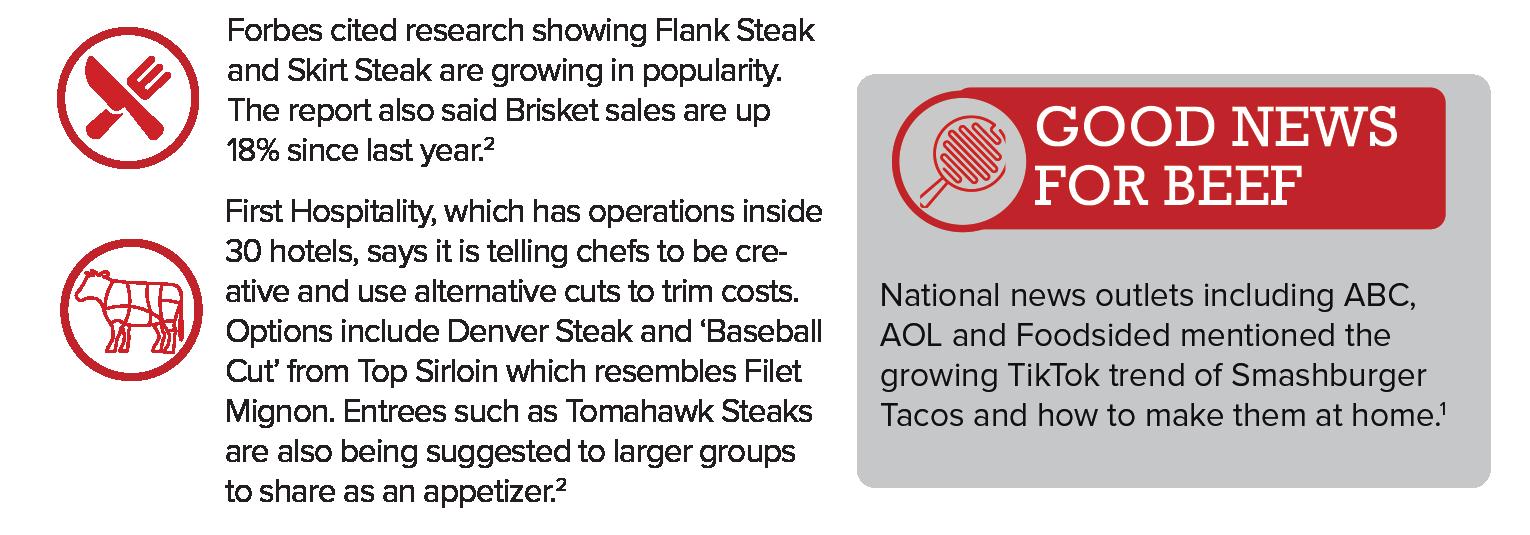

PAGE 76 The Carolina Cattle Connection q OCTOBER 2023
Beef CheCkoff News
Unified Vision Drives Beef Checkoff Success. Since 1963, the Federation of State Beef Councils has been committed to building beef demand by inspiring, unifying, and supporting an effective and coordinated state and national Checkoff partnership. By working together with one unified vision and plan, the National Cattlemen’s Beef Association, a contractor to the Beef Checkoff, and state beef councils continue to set a positive course for beef’s future.
Here are a few examples of recent program successes:
Nutrition Research - Research continues to serve as the foundation for all Beef Checkoff funded initiatives. Nutrition research provides proof that beef has a role in a healthy, sustainable diet. Current projects focus on human clinical trials investigating healthy diets across the lifespan, where beef is the primary source of dietary protein, and focus on the impact of cardiometabolic health, strength, and performance, and the benefits of beef in the diets of children and adolescents.
National Beef Quality Audit - The National Beef Quality Audit (NBQA), conducted approximately every five years since 1991, is foundational research that provides an understanding of what quality means to the various industry sectors and the value of those quality attributes. This research helps the industry make
modifications necessary to increase the value of its products. The findings from the 2022 NBQA serve to improve quality, minimize economic loss, and aid in advancements in producer education for the U.S. beef industry.
Results from the 2022 NBQA indicate that the beef cattle industry is producing a high quality product that consumers want more efficiently, and the industry’s primary focus across the supply chain remains food safety. In addition, there was an increase in the frequency of Prime and Choice quality grades, with 7.5 percent of carcasses grading Prime, the highest since audits began. Market sectors also reported that their companies strive to increase their sustainability and work with the entire beef supply chain to do so.
Beef Quality Assurance - Cow/ calf producers, stockers, and feedyards implement Beef Quality Assurance (BQA) practices on their operations to produce the highest quality cattle and provide consumers with the best possible eating experience. BQA principles don’t end at the farm gate, and cattle haulers can also become BQA Transportation (BQAT) certified through recently updated modules. Since BQAT began in 2017, more than 32,000 certifications have been completed.
E-Commerce - With consumers making more shopping decisions online, e-commerce efforts are essential to driving beef sales. National e-commerce
campaigns during the holidays and summer grilling months helped put beef front and center for consumers shopping online. These e-commerce campaigns delivered impressive results, generating more than $22 million in incremental beef sales and reaching nearly 16 million households.
Advocacy - Ten Trailblazers from eight states were selected for the second cohort of beef community spokespeople, beginning the year-long program, which includes in-person and virtual training opportunities to prepare the next generation of advocates who will help protect the reputation of the beef industry.
The unified vision of the Federation

of State Beef Councils continues to drive Beef Checkoff success. For more information, visit www.ncba.org/ federation
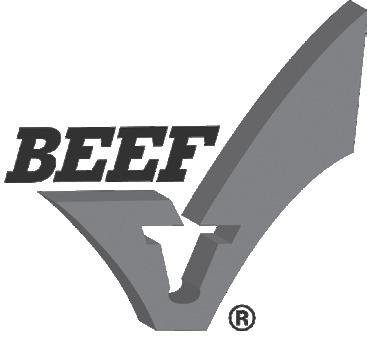
About the Beef Checkoff. The Beef Checkoff was established as part of the 1985 Farm Bill. The Checkoff assesses $1 per head on the sale of live domestic and imported cattle, in addition to a comparable assessment on imported beef and beef products. States may retain up to 50¢ of the dollar and forward the other 50¢ per head to the Cattlemen’s Beef Promotion and Research Board, which administers the national checkoff program, subject to USDA approval.

NEWS
Endovac celebrates 40 years of transforming animal health. Endovac Animal Health began as a small, family owned company 40 years ago. Today, the company is celebrating 40 years of providing superior science in the animal health industry throughout the nation and internationally.
In 1983, Ron Sprouse, M.D., Ph.D., and Harold Garner, DVM, both working at the University of Missouri-Columbia, researched and developed a vaccine for horses that proved effective against a broad spectrum of bacteria. Along with Dr. Sprouse’s wife, Dorothy, and Dr. Garner’s wife, Patsy, they founded the company, formerly known as IMMVAC, to commercialize the novel technology.
Endovac manufactures vaccines for livestock to aid in the protection of numerous diseases caused by gram negative bacteria. The first product, Endoserum for Equine, received its USDA license in 1986. Over the years, the company grew and specialized in providing products for other industries, including Endovac-Dairy, Endovac-Beef, Endovac-Porci, and Endovac-Equi.
“It started with an idea to make a difference in agriculture. And, it has. It’s made a profound difference,” says Kevin Sprouse, Endovac chairman and CEO. “We built something that is pretty special, and I’m very proud of it.”
As part of the celebration, President Steve Knorr unveiled a Legacy Wall at the company headquarters that highlights the company’s history. “Forty years in this business for a company this size is
incredible,” says Steve Knorr, Endovac president. “The impact that Endovac’s going to have over the next 40 years is going to be transformational. The foundation has been put in place for us to continue to grow and improve.”
With national and international sales, the company continues to grow. Endovac moved to its new 25,000 square foot headquarters with production and office space in 2020. The following year, Endovac became ISO certified, meeting all international quality management system standards. The rigorous ISO certification process means that Endovac meets all customer and other stakeholder needs within statutory and regulatory requirements.
About Endovac Animal Health. Located in Columbia, Mo., Endovac Animal Health was founded in 1983 and is owned by the Sprouse family. A proactive animal health company that is focused on premium science, we maintain a culture that is dedicated to customer centric integrity and an animals first mentality.
Endovac Animal Health manufactures vaccines for livestock and companion animals to aid in the protection of numerous diseases caused by gram negative bacteria. Today, our main focus is beef and dairy cattle, with developing product lines for equine and swine. Our dynamic team is here to assist veterinarians and producers with any questions about our product portfolio.
For more information, visit www. endovacanimalhealth.com
The Carolina Cattle Connection q OCTOBER 2023 PAGE 77
Our breed Spotlight special sections are excellent forums to reach producers and cattle industry insiders in the Carolinas and throughout the Southeast. Advertisers also receive a special discount for placing their message in the Spotlight.
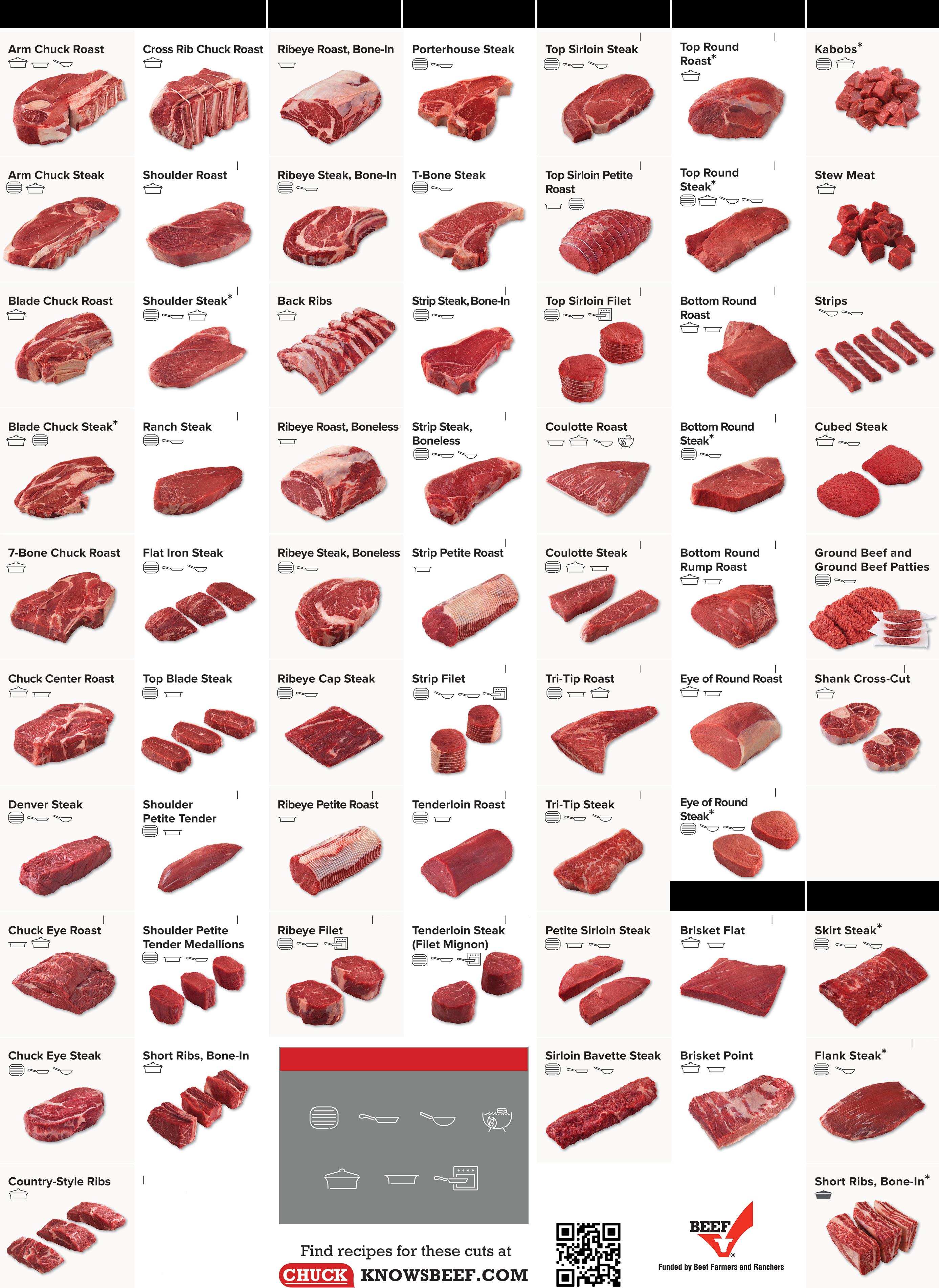

PAGE 78 The Carolina Cattle Connection q OCTOBER 2023 SHANK BRISKET CHUCK RIB PLATE LOIN FLANK SIRLOIN ROUND SHANK INGEDIENT CUTS ROUND SIRLOIN LOIN RIB CHUCK PLATE & FLANK BRISKET KEY TO RECOMMENDED COOKING METHODS GRILL or BROIL PAN BROIL/ SKILLET STIR-FRY INDIRECT GRILLING BRAISE/ POT ROAST ROAST SKILLET TO OVEN * MARINATE BEFORE COOKING FOR BEST RESULTS These cuts meet the government guidelines for lean, based on cooked servings, visible fat trimmed A cut of cooked fresh meat is considered ‘lean’ when it contains less than 10 grams of total fat, 4.5 grams or less of saturated fat, andless tahn 95 mg of cholesterol per 100 grams(3½ oz) and per RACC (Reference Amount Customarily Consumed), which is 85 grams (3 oz.) LEAN LEAN LEAN LEAN LEAN LEAN LEAN LEAN LEAN LEAN LEAN LEAN LEAN LEAN LEAN LEAN LEAN LEAN LEAN LEAN LEAN LEAN LEAN LEAN LEAN LEAN LEAN LEAN LEAN LEAN LEAN
federation of state Beef CoUnCils Update
Beef. It’s What’s For Dinner. Launches “Cattle Calling” Docuseries. The first episode of a new docuseries entitled “Cattle Calling” shares the story of Kinzie Burtrum Borgerding and the Burtrum family of Burtrum Cattle, LLC in Stillwater, Oklahoma, as they work to ensure their ranch and their family thrive despite a complex and changing landscape. The recently released episode, which highlights the people who raise cattle and sheds light on their way of life, is available to view at www.CattleCalling.org
“As a rancher, our connection to the land, our heritage, and our family run deep so we were honored to be a part of this effort to share the story of ranching and raising beef in Oklahoma,” said Clay Burtrum.
The new docuseries, produced by the National Cattlemen’s Beef Association, a contractor to the Beef Checkoff, invites consumers to step into the world of modern day cattle ranchers as they navigate the trials and tribulations to continue the lineage of the American beef producer. The film provides consumers with an in-depth look at the cattle farming and ranching industry and encourages them to follow along to see how this Oklahoma family adapts to care for the land and the cattle and ensure their operation can continue.
“My dad has been a source of inspiration for me since I was a little girl, so the opportunity to be a part of this with him was very meaningful,” said Kinzie Burtrum Borgerding.
“Cattle Calling” continues the Beef Checkoff’s ongoing emphasis on connecting with consumers and sharing the stories of beef producers. The video project aims to connect consumers with the cattlemen and women who are working to ensure they are adopting tools and technologies that help beef farmers and ranchers become more sustainable over time.
For more information and to watch the first episode, visit www.CattleCalling. org
Music Makes for Memorable
Beef Experience. The iconic “Rodeo” music composed by Aaron Copland has long been associated with the Beef Checkoff funded Beef. It’s What’s For Dinner. brand, but it is now being served in a new form. To celebrate National Grilling Month in July, approximately 50 influencers, content creators, and media
members received a special gift box in the mail, complete with its own beefy soundtrack.
The Beef. It’s What’s For Dinner. boxes were designed to look like a grill, and when opened, the “Rodeo” music played while recipients unpacked aprons, BBQ seasoning, and cast iron skillets, along with beef recipes and nutrition information. The goal was to grow and expand influencer relationships and extend reach and engagement with consumers.
“It is exciting to see big name chefs with large consumer audiences sharing their passion for our product,” said Aimee Long, NCBA’s senior director of influencer engagement and partnerships. “Beef. It’s What’s For Dinner. is a brand thought leaders want to be associated with, and we want to continue developing those relationships.”
Influencers and thought leaders help extend beef messaging with their large and engaged audiences. These third party advocates, which include food bloggers, chefs, recipe creators, farmers, and ranchers, humanize beef’s story as they share their personal beef experiences with consumers across the country on social media platforms. One way to encourage influencers to post about beef’s taste and versatility is by sending them information and tools they can use.
While sending gift boxes to influencers is common, the addition of music is unique and makes for a memorable beef experience. Omnivorous Adam, a Chicago cook and creator of food related videos, exclaimed, “No song gets me more fired up!” as he shared his box with followers through an online video.
In addition to strengthening relationships, the gift boxes provided a reason for influencers to post new beef content. From beauty products and toys to high tech gadgets and cooking tools, unboxing videos on social media are extremely popular. Consumers experience a rush watching someone open a product for the first time. Not only do they learn something new about a product they wish to purchase, but they also share in the excitement from the influencer. Consumers rely on these influencers for information and make buying decisions based on what they learn from them.
“A lot of brands send gifts during the holidays; however, summer grilling
makes sense for beef,” said Long. “When we send something that stands out at a different time of year, our information generates greater attention.”
Work with influencers complements the promotional work the National Cattlemen’s Beef Association conducts as a contractor to the Beef Checkoff. While advertising uses the Beef. It’s What’s For Dinner. brand channels to convey information to consumers, influencers serve as third party endorsements, extending beef’s positive message.
So far, 15 of the influencers have shared their summer grilling boxes on their social media channels, with a total audience size of more than two million consumers.
“We hope box recipients use the high quality aprons and skillets when they create new beef content,” said Long. “These sizzling gifts were extremely
popular, and we expect to see social posts continue for the next several months, keeping beef top of mind with consumers.”
2023 Spotlight iSSueS Schedule
Most of the breed associations in North and South Carolina have stepped forward and renewed their contracts for Spotlight sections in The Carolina Cattle Connection for 2023. If your breed is not featured as a Spotlight section and you would like to inquire on any open months please feel free to contact me. Below is the tentative schedule for the upcoming year.
2023 Reserved Spotlight Issues
About the Federation of State Beef Councils. Created in 1963, the Federation of State Beef Councils represents the 43 Qualified State Beef Councils and is committed to its vision, which is to build beef demand by inspiring, unifying, and supporting an effective and coordinated state and national Checkoff partnership. State beef councils voluntarily invest in the Federation to enhance the national Checkoff and leverage producer dollars through a coordinated partnership. Housed at the National Cattlemen’s Beef Association, a contractor to the Beef Checkoff, the Federation is a grassroots organization run by producers across the country. For more information

The Carolina Cattle Connection q OCTOBER 2023 PAGE 79
your breed’s Spotlight Issue, contact: The Carolina Cattle Connection 2228 N. Main Street • Fuquay-Varina, NC 27526 919-552-9111 • mail@nccattle.com
about
JANUARY CHAROLAIS FEBRUARY FORAGES MARCH ANGUS APRIL PIEDMONTESE MAY BRAHMAN JUNE HEREFORD JULY GELBVIEH AUGUST SIMMENTAL SEPTEMBER SANTA GERTRUDIS OCTOBER WAGYU NOVEMBER BRANGUS DECEMBER ---------------
Beef’s Contribution to Global Food Security. The research behind food security suggests that only a handful of nations are protein insecure. But is the data overlooking the importance of protein quality? Dr. Vaughn Holder, ruminant research director at Alltech, joined the Ag Future podcast in 2022 to discuss the role digestibility plays in getting an accurate gauge of global protein security and the positive impact that cattle have on the health of people and the planet.
Rethinking protein security: a paradigm shift - Dr. Holder kicked off the conversation by challenging the conventional approach to evaluating food security. The existing framework primarily focuses on the quantity of protein consumption in different nations, overlooking the crucial factor of protein digestibility.
Not all proteins are created equal. Animal derived proteins tend to be complete proteins with high digestibility, closely aligned with the human body’s needs. In contrast, plant proteins often have lower digestibility, making them less efficient sources of nutrition.
Dr. Holder referenced the groundbreaking work of Paul Moughan, a researcher from a university in New Zealand, who highlighted the necessity of adjusting protein intake based on the body’s ability to absorb and utilize it effectively. By factoring in protein quality and digestibility, the scope of protein insecurity expands significantly, potentially affecting a much larger portion of the global population.
Impacts on human health and development - Protein malnutrition has far-reaching implications for human health, particularly in terms of its effects on brain development in infants and on overall physical development. Dr. Holder cited research suggesting that addressing protein insufficiency could potentially elevate the global population’s average IQ by ten points. This underscores the profound impact of protein quality on societal progress and well being.
Plant based alternatives and food production - In discussing the rise of plant based meats and milks as alternatives to conventional animal products, Dr. Holder acknowledged the value of these products in terms of taste and consumer preferences. However, he raises a critical point: While plant based options can be part of a nutritious diet, they should not replace actual protein
production. The distinction lies in the fact that plant based alternatives are essentially processed foods.
Ruminants as nature’s recyclers - Annually, about 40 metric tons of byproducts are being fed into the dairy industry. Dr. Holder described ruminants as natural recycling centers, converting both food waste and nutrient rich plant byproducts that humans can’t use into valuable protein sources.
What’s more, cattle are reducing the greenhouse gas footprint of those byproducts.
“If there aren’t cattle utilizing those byproducts, those byproducts end up in compost heaps or landfills,” Dr. Holder explained. “As byproducts entering compost heaps, they will end up generating five times the amount of greenhouse gases that they would if they went through a cow, and they’d generate 49 times as many greenhouse gases if they went into a landfill than if they went into a cow.”

The path forward: an ecosystem centric approach - Dr. Holder concluded with an exciting glimpse into the future of ruminant research. He introduced a paradigm shift in viewing protein production, emphasizing the importance of ecosystems as units of production. This holistic approach considers not only the role of cattle in protein production but also the broader impact on carbon capture and nutrient cycling within ecosystems.
Alltech awards young leaders in agricultural communications at 2023 Ag Media Summit. During the 2023 Ag Media Summit (AMS), held in Palm Springs, Calif., on July 30–August 2, agricultural communications students were honored for their excellence, professionalism, and leadership. The Livestock Publications Council (LPC) Student Award Program, sponsored by Alltech, provides travel scholarships for four students to attend AMS. This year’s finalists were Molly Biggs of Kansas State University, Tessa Erdmann of South Dakota State University, Maddy Rohr of Kansas State University, and Carlye Winfrey of Texas Tech University.
Following a competitive application and interview process, Carlye Winfrey from Texas Tech University was awarded the LPC Forrest Bassford Student Award. She is a senior pursuing a Bachelor of Science in Agricultural Communications with a minor in political science.
“This award is more than my name or college receiving recognition but showcases
the contributions Forrest Bassford made so agricultural communications students like me can achieve success,” Winfrey said. “I am thankful to the faculty at Texas Tech for encouraging me to apply and am grateful for the countless mentors I have in this field.”
Winfrey is currently interning in Washington, D.C., through her college’s congressional internship program. She was previously editor for The Agriculturist , a student led publication produced by the Department of Agricultural Education and Communications at Davis College of Agricultural Sciences and Natural Resources. Winfrey also completed internships with the United States Department of State in their Global Public Affairs Bureau and with the Merck Animal Health Public Policy Team, and she was a student assistant on campus for the Texas Tech University System.
“In my future career, I want to help shape policy to best serve the people of rural America,” Winfrey said. “My agricultural communications degree will allow me to walk through the halls of the U.S. Congress and share the stories that rural America is so desperately needing to be told. The narrative of agricultural communications is changing, and I am responsible to help change it.”
“Alltech is proud to support the next generation of agricultural communicators as the ambassadors and voice of our industry,” said Jenn Norrie, Alltech’s communications manager for North America and Europe. “These young leaders are playing an instrumental role in sharing stories of farmers and ranchers and helping to educate the urban population on where and whom their food comes from.”
The Forrest Bassford Student Award was established in 1992 to honor Bassford’s contributions to the Livestock Publications Council and passion for supporting young people in the agricultural communications field. To learn more about this award and past recipients, visit www. livestockpublications.com/students/ forrest-bassford-award
About Alltech. Founded in 1980 by Irish entrepreneur and scientist Dr. Pearse Lyons, Alltech delivers smarter, more sustainable solutions for agriculture. Our products improve the health and performance of plants and animals, resulting in better nutrition for consumers and a decreased environmental impact.
We are a global leader in the animal health industry, producing specialty ingredients, premix supplements, feed, and complete feed. Strengthened by more than 40 years of scientific research, we carry forward a legacy of innovation and a unique culture that views challenges through an entrepreneurial lens.

Our more than 5,000 talented team members worldwide share our vision for a Planet of Plenty™. We believe agriculture has the greatest potential to shape the future of our planet, but it will take all of us working together, led by science, technology, and a shared will to make a difference.
Alltech is a private, family owned company, which allows us to adapt quickly to our customers’ needs and maintain a focus on advanced innovation. Headquartered just outside of Lexington, Ken., Alltech has a strong presence in all regions of the world. For more information, visit www.alltech.com
PAGE 80 The Carolina Cattle Connection q OCTOBER 2023 NEWS

The Carolina Cattle Connection q OCTOBER 2023 PAGE 81

PAGE 82 The Carolina Cattle Connection q OCTOBER 2023

The Carolina Cattle Connection q OCTOBER 2023 PAGE 83 Additional CapacityProductionNow! CALL US!
Know the Rules, Regulations before Heading to Shows. There is a crisp in the air. Hoodies or jackets are required in the early morning and late evenings, yet we run fans in the barn by day. These temperature shifts mean that fall majors and winter jackpots are not far away.
While many exhibitors and their families anticipate the fall show run, shows don’t function without a set of guidelines. Often, those are updated from year to year. Show rules change. Health requirements are updated, and deadlines shift with the calendar. Make sure you know the rules and check all show regulations before you head out to any show.
Just like your nutrition plan or hair and skin routine is part of how you #PreptoWin, it is imperative you also know the showing rules and regs. At BioZyme, our marketing and sales staff is comprised of some past show management staff. They offer some of their top tips for staying organized and in the know before the show.

Read the Premium Book - The premium book is the guide to all major shows and state fairs. Read it. Know it. If you are showing just one species, print off the section that applies to you. Rules, regulations, and deadlines are in the premium book.
“I find it helpful to highlight any important deadlines as well as any rule changes or things that stand out of the ordinary from other shows,” said Shelia Grobosky, BioZyme PR & Content Manager, whose daughter shows pigs. “I print those pages and put them in the show binder, so I don’t have to keep going online, unless I am looking for any updates.”
Not only do the premium books list important rules about entering livestock, but they also have rules about specific shows. What kind of bedding is allowed? Is bedding furnished? Are generators allowed? What are the fitting rules?
Know the Health Requirements
- Biosecurity is vital to the future of the livestock industry. That is why each show has a specific set of health requirements based on its location. Health requirements vary by state and species, so read these in the premium book with plenty of time before you leave for the show.
Some shows require animals to be tested for various diseases, which require bleeding the animals. It takes time for
your veterinarian to draw the sample and send it to the lab for testing. Be sure to schedule time well in advance, but within a proper window that the show requires.
Establishing a relationship with your veterinarian helps reduce the pressure of obtaining health papers prior to a show. Vets will need the name, address, and dates of the show and often will need to obtain a permit number for you to travel to that state.
Bring Healthy Animals - Since your vet has issued health certificates for your animals, it is imperative for you to bring animals in good health to the actual show. A sick animal is a germ spreader, a potential risk to others, and a liability to the show should it die. In addition, the additional stress of hauling and change in environment can cause it to get sicker, adding to decreased performance.

“I encourage every exhibitor to look at their animals. If they are sick or just feeling under the weather, leave them home, and bring a healthy animal to the show,” said Morgan Weinrich, Missouri Area Sales Manager, who worked as a livestock superintendent at the National Western.
Know Important Dates and Deadlines - Dates and deadlines can sneak up on a person. However, most shows have a standard set of ownership and entry dates. Pay attention because these are always subject to change.
Show deadlines are important from a management perspective so they can make sure the flow of the show runs smoothly. Again, read the deadlines carefully. Is an entry deadline absolute, or is it a postmark deadline? It can make a big difference.
Most shows offer online entries now, which makes it convenient. However, be sure to push submit and be sure you receive a confirmation email. That means your entries went through.
“As a parent and past show manager, I would print out the confirmation for your online entry to have in your show folder. It should have a time stamp on it. Keep it with you until you are successfully checked in at the show, as proof that you did check in if any questions arise about your entries,” Grobosky said.
Remember your Paperwork - Every show and every breed association will differ when it comes to paperwork. Weinrich reminds exhibitors to, again, know the rules of the show and the
association they are working with. Abide by those policies.
“Make sure you have your health and registration papers before you get to the show. And always check your pig’s ear notches or other species’ tattoos against the papers you receive from the breeders before you come to the show,” Weinrich reiterates. “If those permanent forms of identification don’t match the registration papers when you get to the show, you are going to have a problem. And with ear notches, especially, many times they are read differently by different people.”
Keeping all important show papers in one safe place, like a folder or binder, is a good way to ensure they arrive at the show. That binder should stay in the show box until the animal is checked in with the show. Then it should be kept secure, so it isn’t misplaced when hauling the animal home and to the next event.
Differentiate the Shows - Every show has different rules and guidelines. Maybe you can use specific coloring agents and adhesives at one. That doesn’t mean they are acceptable at every show. This circles back to reading the premium book and knowing the showing rules for each.
Other regulations that might vary include the types of bedding that can be used, fitting policies, who can actually fit an animal, the use of generators, and move in and release schedules.
Don’t Argue with Superintendents
- Weinrich reminds exhibitors that the superintendents don’t make the rules. They are merely there to enforce showing rules and encourage exhibitors. As a former association activities director, Grobosky agrees.
“Rules are typically made by a board or governing body who aren’t always present at the show. It isn’t worth getting worked up and arguing with or yelling at a superintendent, usually a volunteer, over a rule. Read the premium book and know the rules. Enjoy the experience,” Grobosky said.
Have Fun Along the Journey
- Showing livestock should be an educational and fun experience for the entire family. The best way to ensure your experience is positive from start to finish. Learn all necessary showing rules and #PreptoWin.
Making memories in the barn and on the show road while teaching the next generation responsibility and animal care practices is what showing is about.
Take the photos. Make the pitstops. And enjoy the journey. Make the most of your time in the barn and at the show with your family and your show family. If you fail to read the show rules and get eliminated, that can make a potentially
fun experience a miserable trip.
Other ways to #PreptoWin - So, are you up to date on the showing rules you’ll need to be successful this season?
If you’ve read the premium book and have met entry deadlines, you can get busy in the barn. Keep your animals feeling their best with a winning combination of Sure Champ and Vita Charge. We’ve got a complete line of products to get your animals eating, drinking, and feeling their best.
Grauer Show Cattle Focus on Future, Family. John and Mackenzi Grauer, owners of Grauer Show Cattle, emphasize raising and selling quality show cattle to good families across the country. At the same time, they are prioritizing raising two young boys in the livestock industry that they grew up in and learned to love. However, the Grauers know that raising boys and raising livestock are two challenges that require commitment and the proper tools.
The Grauers own and operate Grauer Show Cattle in Shiloh, Ohio. They run about 60 mama cows that are primarily Maine and Chi-influenced. The full service cattle operation raises cattle and sells show cattle year round, including two online sales in the fall. John and Mackenzi provide their customers with advice and support as needed. John said one of the best parts of their business is watching their customers succeed.
“It’s fun to see our own boys do well,
Continued on page 86
Have you forgotten something?
Make sure your cattlemen friends are members of your state association!
PAGE 84 The Carolina Cattle Connection q OCTOBER 2023 NEWS

The Carolina Cattle Connection q OCTOBER 2023 PAGE 85
but it is even more fun to work with good families and help build them up. It is neat to watch them have success and meet their goals, whether that is winning the county fair or their state fair,” John said.
As if they weren’t busy enough raising kids and cattle, Mackenzi is also the editor of Show Circuit magazine. She is also trained in MagnaWave technology for livestock as a side business.
Mackenzi and John have two sons, Weston and Lawson. She shares why their family is such big fans of youth programs.
“We are big supporters of junior livestock programs. I am a firm believer that these programs are one of the best ways for kids to grow up,” she said.
Rooted in Agriculture - John and Mackenzi had very different beginnings in the cattle business. Growing up in Texas, Mackenzi showed cattle across the country. She was involved in the American Junior Maine-Anjou Association (AJMAA) and active on its junior board. She was also the National
Maine-Anjou Queen.
John is a first generation cattle producer. He bought his first two heifers as a high school freshman in 2000. His dad always challenged that they would never have more than ten cows on the farm. His goal at that time was to raise his own feeder calves for the fair. With three younger brothers who wanted to show heifers, the herd expanded.
John also showed pigs when he was younger — his dad owned large finishing houses until 2019.
His parents are still involved in grain farming. However, John prefers to help with the hay and straw production and fence building on the family farm while building the cow herd.
And remember that Maine-Anjou Queen, Mackenzi? Well, that is how the two of them met. She was in backdrop photos when John’s younger brothers had a successful run. A love of a breed turned into a love for each other.
Sharing the Passion with the Next
Generation - Mackenzi and John are so grateful to share their love for livestock with their boys. Their lifestyle offers a plethora of other benefits that Weston and Lawson are reaping.
“Our boys would rather be outside in the barn, working with cattle or playing with tractors, than inside playing video games,” John said.
He listed the skills they are learning each day:
• Responsibility
• Work ethic
• How to win
• How to lose
• Good things – appreciate a new baby calf
• Working through heartache – life and death situations
Some of the aspects the Grauers appreciate most about the AJMAA include the Littles Program and Rookie age division at the Maine-Chi Junior National. Although he just started first grade, Weston competed in several
contests and showed at the Junior National as a Rookie. Many associations require youth to be at least nine years old to compete.
Mackenzi challenged Weston to compete in either salesmanship or speech. Since he did not fully understand that he didn’t have to actually sell the possession of his heifer, he chose public speaking.
“It turns out speech was his favorite part of junior nationals! He came out of that room and proclaimed, ‘I stood up tall and talked loud,’” Mackenzi recalls. “I don’t know how many strangers he practiced his speech on that week!”
Attending shows isn’t just part of the customer service that the Grauer family provides. It is also a great way to raise their boys. John and Mackenzi know that another great service they can provide is keeping the cattle they raise and sell healthy and performing.
Grauer Show Cattle Relies on BioZyme - “John has used BioZyme products for as long as I can recall. He
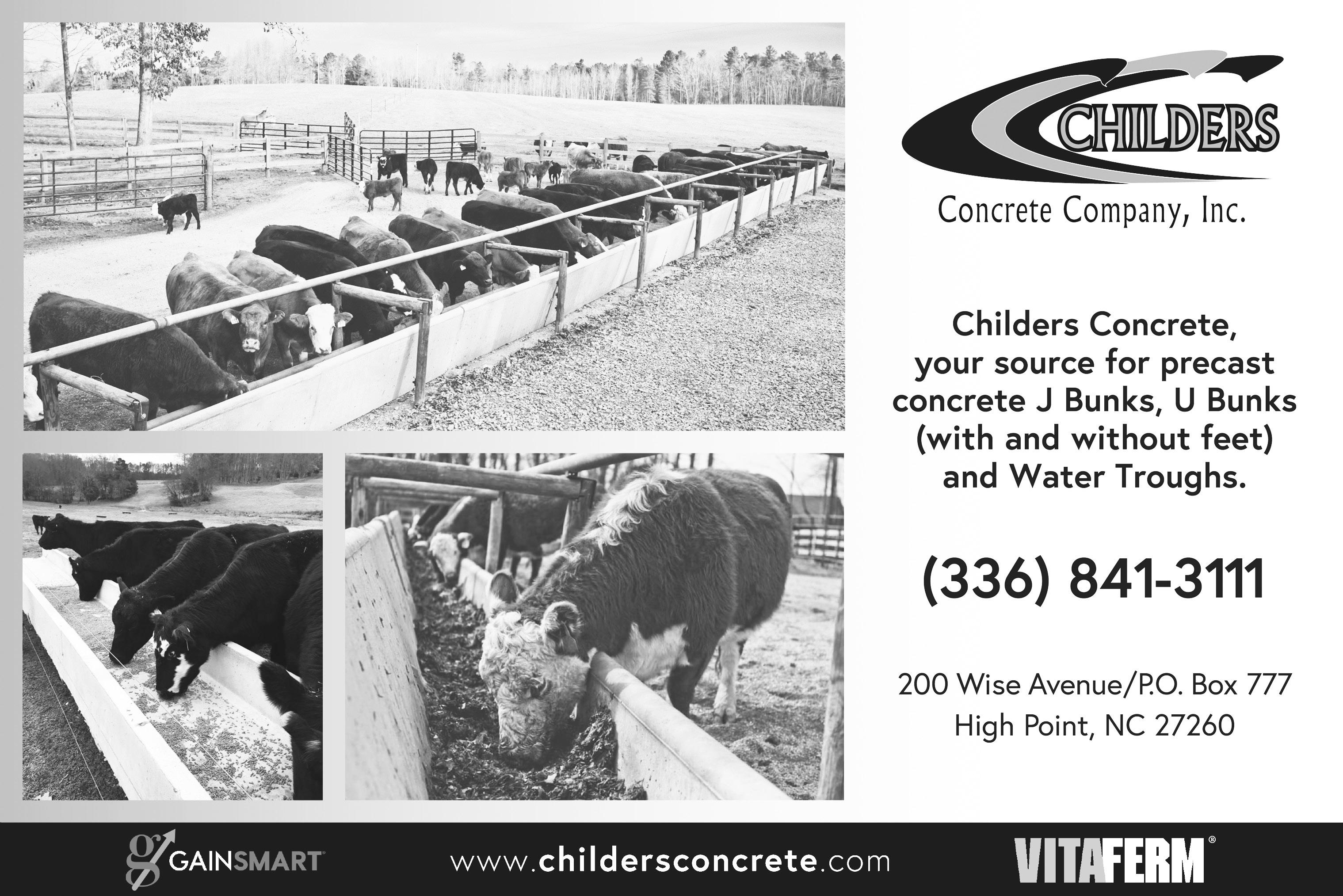
PAGE 86 The Carolina Cattle Connection q OCTOBER 2023
BioZyme News continued from page 84
was using them before I came into the picture,” Mackenzi said.
As owners of Grauer Show Cattle, John and Mackenzi are big believers in the BioZyme family of brands. But they have also been BioZyme dealers for ten years. They rely on the products for results and consistency.
“Our overall conception rate on our cows is significantly higher when we feed them Concept•Aid,” John said.
For show and sale cattle, his #Formula4Success includes a combination of the Vita Charge Stress Tubs HEAT and Vita Charge Liquid Boost.
“We see a huge difference in the overall health and condition of calves when incorporating the Vita Charge Stress Tubs with HEAT into the daily routine. We like to add in the Liquid Boost,” John adds.
The BioZyme products are known for their key ingredient, AO-Biotics Amaferm, a prebiotic research proven to enhance digestibility. BioZyme products are American made by people who care about livestock and animals as much as our customers do.
The VitaFerm Concept•Aid line is a vitamin and mineral supplement that promotes effective, easy breeding when fed 60 days pre-calving through 60 days post breeding. With multiple formulas to match the management scenario for you, you can learn more and find the Concept•Aid formula for you with our Concept•Aid Product Navigator.

Vita Charge is a line of fast acting, multi-specie livestock products for support before, during, and after stressful times. The Vita Charge Stress Tubs HEAT contain the prebiotic Amaferm and a heat tolerant probiotic. In addition, they contain mannan oligosaccharides or MOS to support the ability to recover from the effects of stress. Further, the 50 pound tubs are convenient and easy to feed. They contain HEAT technology, a combination of essential oils and garlic, to support animals when heat and insects are a challenge.
Liquid Boost is for all livestock and is designed to provide immediate support to the animal’s digestive and immune systems. In addition to Amaferm and MOS, it contains organic Zinc, the antioxidant Vitamin E and B vitamins, as well as a fruit flavoring to promote water and feed intake.
Mackenzi and John work intensely to promote their cattle while helping their customers. This includes discussing freely with anyone who will listen to the benefits of the BioZyme products and youth livestock programs. They feel both the BioZyme brands like Sure Champ and
junior breed programs help young people develop skills and their network.
It only makes sense to have Sure Champ and Vita Charge Brand Ambassadors like John and Mackenzi Grauer from Grauer Show Cattle. They are raising kids in a livestock environment and promoting brands that are at the center of care that comes full circle.
Thanks for all you do, Grauer family. We look forward to seeing Weston and
Lawton in front of the backdrop as they #PreptoWin in the future.
To learn more about the products, visit www.surechamp.com
About BioZyme Inc. BioZyme Inc., founded in 1951, develops and manufactures natural, proprietary products focused on animal nutrition, health, and microbiology. With a continued commitment to research, BioZyme offers a complete line of feed additives and high density, highly available vitamin, mineral,
trace mineral, and protein supplements for a variety of animals, including cattle, pigs, poultry, sheep, goats, horses, and dogs. BioZyme brands include AO-Biotics ® , VitaFerm®, Gain Smart®, Vita Charge®, Sure Champ®, Vitalize®, DuraFerm®, and Backyard Boost ®. With headquarters in St. Joseph, Mo., the company reaches a global market of customers that stretches into countries across five continents. For more information about BioZyme, visit www.biozymeinc.com
The Carolina Cattle Connection q OCTOBER 2023 PAGE 87


PAGE 88 The Carolina Cattle Connection q OCTOBER 2023 1 Spot Color - $100 • Full Color - $300 $575 - Open Rate $530 - 6 Month Contract $460 - 12 Month Contract $400 - Open Rate $375 - 6 Month Contract $320 - 12 Month Contract $225 - Open Rate $200 - 6 Month Contract $180 - 12 Month Contract $200 - Open Rate $185 - 6 Month Contract $160 - 12 Month Contract $40 $80 $80 $160 Please contact for Contract Rates!
Beef Promotion and Research Program

PRIVATE TREATY SALES CHECKOFF INVESTMENT FORM
Information is required by (7 CRF 1260.201). Failure to report can result in a fine. Information is held confidential (7 CRF 1260.203).
Today’s Date: ________________
Seller’s Name: ____________________________
Buyer’s Name: ____________________________
Address: Address:
City: ________________ State: ____ Zip: City: ________________ State: ____ Zip: ______
Seller’s Signature: _________________________
Buyer’s Signature: _________________________
Both the seller & the buyer are responsible for making sure that the $1.50 per head assessment is collected and remitted to the Beef Promotion & Research Board.
Total Number of Cattle Sold: ___________________ x $1.50 Per Head = $
Date of Sale: __________________ Person remitting assessment form: Seller o Buyer o
* State of Origin of Cattle:
* If the cattle purch ased came from another state within the last 30 days, indicate from which state the cattle were purchased.
Send Report and Remittance to:
SOUTH CAROLINA BEEF COUNCIL
P.O. Box 11280

Columbia, SC 29211
According to the Paperwork Reduction Act of 1995, an agency may not conduct or sponsor, and a person is not required to respond to a collection of information unless it displays a valid OMB control number. The valid OMB control number for this information collection is 0581-0093. The time required to complete this information collection is estimated to average 1.8 minutes per response, including the time for reviewing instructions, searching existing data sources, gathering and maintaining the data needed, and completing and reviewing the collection of information.
The U.S. Department of Agriculture (USDA) prohibits discrimination in all its programs and activities on the basis of race, color, national origin, gender, religion, age, disbility, sexual orientation, marital or family status, political beliefs, parental status, or protected genetic information. (Not all prohibited bases apply to all programs.) Persons with disabilities who require alternative means for communication of program information (Braille, large print, audiotape, etc.) should contact USDA’s TARGET Center at 202-720-2600 (voice and TDD).
To file a complaint of discrimination, write USDA, Director, Office of Civil Rights, Room 326-W, Whitten Building, 14 th and Independence Avenue SW, Washington, DC 20250-9410 or call 202-720-5964 (voice and TDD). USDA is an equal opportunity provider and employer.
The Carolina Cattle Connection q OCTOBER 2023 PAGE 89
Joe
Robin Hampton 345 Withrows Creek Lane Mt. Ulla, NC 28125
BLACK GROVE
Breeding Registered Angus since 1962


Walter D. Shealy III and Family 20977 US Hwy 76 • Newberry, SC 29108

Walter Shealy • 803-924-1000
Dixon Shealy • 803-629-1174 walter@blackgrove.com • dixon@blackgrove.com www.blackgrove.com
“Cattle with Something Extra”
REGISTERED POLLED HEREFORDS • EST. 1998 “Quality Cattle For Quality People”


Cattle Available Private Treaty
John Wheeler • 910-489-0024 doublejfarm@yahoo.com • www.doublejfarmllc.com
Headquarters - 775 Clacton Circle • Earlysville, VA 22936
Cattle located in Traphill, N.C.
SPRINGFIELD ANGUS 104 Springfield Lane Louisburg, NC 27549
Phil Goodson: 919-880-9062
• Performance Tested
• Ultrasound and 50K Evaluated
• Registered Angus Bulls


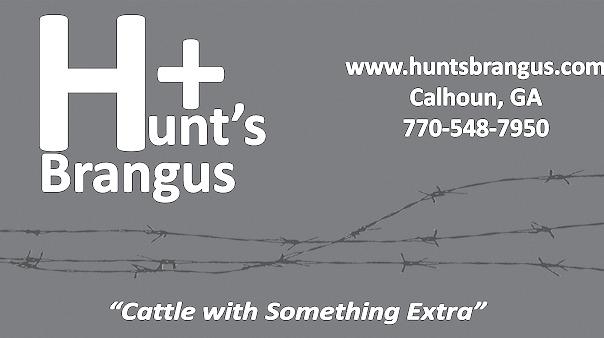

328 Fowken Farm Rd. • Jonesville, SC
More than 70 years of breeding grass type cattle!
Carcass Data • Fescue Suited • Southern Bred EPDs Breeding Soundness
www.fowkenfarm.com

RICHARD KIRKMAN, DVM 20416 US 64 West Siler City, NC 27344-0350
• rdkirkman@centurylink.net






FOR SALE
BBU Registered Beefmaster Bulls and Females WHITEHALL BEEFMASTERS

Joe and Ann Logan 214 Cowhead Creek Road Greenwood, SC 29646
Telephone: 864-538-3004
Autryville, NC 28318 www.howardbrosfarms.com
Darryl Howard Cell: 910-990-2791
A young boy enters a barber shop and the barber whispers to his customer, “This kid comes in here all the time, and he is the dumbest kid in the world. Watch while I prove it to you.”
The barber puts a dollar bill in one hand and two quarters in the other, then calls the boy over and asks, “Which do you want, son?” The boy takes the quarters and leaves.
“What did I tell you?” said the barber. “Every time he comes in here I ask if he’d rather have the doller bill or the two quarters, and every time he chooses the quarters. That kid never learns!”
Later, when the customer leaves, he sees the same young boy coming out of the ice cream parlor.
“Hey, son! May I ask you a question? Why did you take the quarters instead of the dollar bill?”
The boy licked his cone and replied:
“Because the day I take the dollar the game is over!” * * *
An MIT linguistics professor was lecturing his class the other day. “In English,” he said, “A double negative forms a positive. However, in some languages, such as Russian, a double negative remains a negative. But there isn’t a single language, not one, in which a double positive can express a negative.”

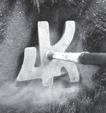
A voice from the back of the room said, “Yeah, right.”
* * *
A guy is sitting at home when he hears a knock at the door. He opens the door and sees a snail on the porch. He picks up the snail and throws it as far as he can.
A year later, there’s another knock at the door. He opens it and sees the same snail. The snail says, “What was that all about?”
* * *
A cruise ship passes by a remote island, and all the passengers see a bearded man running around and waving his arms wildly.
“Captain,” one passenger asks, “who is that man over there?”
“I have no idea,” the captain says, “but he goes nuts every year when we pass him.”
* * *
A tough old cowboy from Texas counseled his granddaughter that if she wanted to live a long life, the secret was to sprinkle a pinch of gun powder on her oatmeal every morning.
The granddaughter did this religiously until the age of 103, when she died.
She left behind 14 children, 30 grandchildren, 45 great-grandchildren, 25 great-great-grandchildren, and a 40-foot hole where the crematorium used to be.
PAGE 90 The Carolina Cattle Connection q OCTOBER 2023 LASSIFIED ... P UREBRED C ATTLE B REEDERS A NIMAL H EALTH Carolinas Animal Health, LLC 519 Morgan Mill Rd., Monroe, NC 28112 704-289-5083 • 704-289-1696 • 800-222-8638 C. A. H. Brent Glenn, DVM Lancaster, S.C. Jim Traynham Wingate, N.C. 704-233-5366 Cell - 704-292-4217 A UCTIONEERING ® Ernest B. Harris President Phone: 252-257-2140 Mobile: 252-430-9595 Email: ebharris@ebharris.com www.ebharris.com Inc. / Auctioneers 3200 NC Hwy. 58 • Warrenton, NC 27589 NCAL #1468 • NC#C#4264 • VAL #146 • SCAL #3895
919-742-5500
KEEP POSTED FOR UPDATES ON THE Tarheel Angus/4K Farm Production Sale I NSURANCE AUTO • HOME • LIFE BUSINESS • FARM & RANCH 803-789-7000 Cell: 803-385-8161 Email: djosey@truvista.net 2610 Kee Moore Drive Chester, SC 29706 The Josey Agency, Inc. Douglas Josey Multi-Line Agent
and
704-880-2488 BACK CREEK ANGUS
Exam on Two-Year-Old Bulls Norris Fowler - 864-219-0182 Greg - 864-426-7337 • Rogers - 864-426-3281 CATTLE FOR SALE PRIVATE TREATY AT ALL TIMES! www.huntsbrangus.com Calhoun, GA 770-548-7950
QUALITY GELBVIEH, ANGUS, & BALANCER CATTLE DUANE & WENDY STRIDER, OWNERS Duane Cell: 336-964-6277 Wendy Cell: 336-964-5127 Home: 336-381-3640 Fax: 910-428-4568 ccrosscattle@yahoo.com • ccrosscattle.com THE HERD THAT CONSISTENTLY PRODUCES CATTLE WITH PERFORMANCE, CARCASS, AND EYE APPEAL. Your Ad Here! HE IDE
NDEX OF DVERTISERS
The Carolina Cattle Connection q OCTOBER 2023 PAGE 91
12th Annual Southeast Bull Expo & Sale ..................................................... 30 15th Annual EBS Select Bull & Female Sale ................................................. 22 15th Annual SimAngus Solution ................................................................. 37 22nd Annual E.B. & Shane Harris Influence Female & Bull Sale .................. 16 29th Annuel Hokie Harvest Sale ................................................................. 54 4K Farms/Tarheel Angus ........................................................................... 90 48th Annual Union County Performance Tested Bull Sale ........................... 14 8th Annual Pounds & Profit Bull & Female Sale ........................................... 23 All American Panel .................................................................................... 60 American Angus Association ..................................................................... 31 American National Insurance — The Josey Agency ................................... 90 Apple Brandy Prime Cuts ........................................................................... 10 Back Creek Angus ...................................................................................... 90 Barnett Angus Ranch 4th Annual Bull Sale ................................................. 24 Bieber Fever in the Southeast .................................................................... 45 Biltmore Livestock .................................................................................. 32 BioZyme — VitaCharge Cattle Drench ...................................................... 85 Black Crest Angus 26th Annual Production Sale ......................................... 29 Black Grove Angus .................................................................................... 90 Brubaker Family Angus ............................................................................. 90 C-Cross Cattle Company ............................................................................ 90 Carolinas Animal Health ........................................................................... 90 Châtel Farms 2023 Fall Bull Sale ................................................................ 25 Childers Concrete Company, Inc. .............................................................. 86 Circle F Farms Fall Sale .............................................................................. 53 Conquest Insurance Agency, Inc. ............................................................... 57 Double J Farms .......................................................................................... 90 Dura•Cast ................................................................................................. 15 E.B. Harris Auctioneers, Inc. .................................................................... 90 First Choice Insurance Partners — Donna Byrum ...................................... 17 Flatlands Insurance Group — Ruth Fulford ................................................. 7 Fowken Farms ........................................................................................... 90 Fred Smith Company Ranch ...................................................................... 90 Fred Smith Company Ranch 7th Annual Extra Effort Fall Sale ..................... 39 Gibbs Farms 18th Annual Bull & Replacement Female Sale ........................ 38 Howard Brothers Farms ............................................................................ 90 Hunt’s H+ Brangus ................................................................................... 90 International Brangus Breeders Association ............................................ 56 JMAR Genetics “Quality Over Quantity” Charolais Bull & Heifer Sale ..... 21 John Deere .............................................................................................. 62 Knoll Crest Farm Total Performance Bull Sale ........................................... 81 Locust Level Farms Bull & Female Sale ...................................................... 28 McMahan Farm & Hancock Angus Annual Registered Angus Bull Sale .... 29 Mid-Atlantic Cattle Sales — Stockyard Schedules ..................................... 19 N.C. Angus Association Directory ….......................................................... 27 N.C. Cattlemen’s Association Membership Application ............................ 73 N.C. Hereford Association Directory ........................................................ 41 N.C. Meat Suite ........................................................................................... 3 N.C. Simmental Association ..................................................................... 36 National Beef Checkoff/North Carolina Cattle Industry Assessment ..... 13 National Cattlemen’s Beef Association 2023 Farm Bill Priorities .......... 70 National Cattlemen’s Beef Association 2023 Policy Priorities .................. 67 National Cattlemen’s Beef Association Membership Application .......... 69 National Cattlemen’s Beef Association Recruitment ................................ 68 Pasture Management & N.C. Cattlemen’s Association “Mile of Fence” Membership Program .................................................. 75 Pearson Livestock Equipment .................................................................... 4 Peidmont Custom Meats ........................................................................... 83 Premier Select Sires ................................................................................. 34 Red Angus Association of the Carolinas Directory .................................... 44 Rusty Thomson & Family Cattle Fencing and Equipment .......................... 82 S.C. Forage & Grazing Lands Annual Meeting ........................................... 65 Sequatchie Valley Angus Mature Cow Herd Dispersale Sale ..................... 26 South Carolina Private Treaty Sale Checkoff Investment Form ................. 89 Southern Partners in Performance Sale .................................................... 40 Southern States — Mineral Madness Savings! .......................................... 61 Southwest Cattlemen’s Classic ................................................................. 55 Springfield Angus ..................................................................................... 90 The Barn Loft — Purina ............................................................................. 59 The Carolina Cattle Connection 2023 Spotlight Schedule ......................... 79 The Carolina Cattle Connection Advertising Rates & Sizes ........................ 88 TJB Gelbvieh & Balancer Annual Bull Sale ................................................ 48 Virginia Herd Health Management Services ............................................. 51 Wax Company — Marshall Ryegrass ........................................................... 2 West End Precast — Feed Bunks ................................................................ 20 West End Precast — Feed Bunks & Troughs ............................................... 43 Whitehall Beefmasters ............................................................................. 90 Wilders Wagyu .......................................................................................... 90 Wilders Wagyu Stay Wild ‘23 Production Sale ..................................... 46-47 Wilkes Livestock Exchange ....................................................................... 50 Yon Family Farms Maternal Roots Angus Female & Bull Sale .................... 33 For Your Advertising Needs, Contact: The Carolina Cattle Connection • 919-552-9111 The Livestock Advertising Network • 859-278-0899
ANGUS
Oct. 14 — Chessie Creek Farm & Partners
2nd Annual Fall Bull Sale, Walterboro, S.C.
Oct. 14 — Fred Smith Company Ranch
Extra Effort Fall Sale, Clayton, N.C.
Oct. 21 — Southwest Cattlemen’s Classic, Wytheville, Va.
Oct. 21 — Whitestone Brand of Quality
Angus Sale, Aldie, Va.
Oct. 27 — 29th Annual Hokie Harvest Sale, Blacksburg, Va.
Oct. 27 — Yon Family Farms Maternal
Roots Fall Female Sale, Ridge Spring, S.C.
Oct. 28 — Yon Family Farms Maternal
Roots Fall Bull Sale, Ridge Spring, S.C.
Nov. 3-6 — American Angus Association
Annual Convention, Orlando, Fla.
Nov. 4 — Barnett Angus Ranches
4th Annual Bull Sale, Washington, Ga.
Nov. 4 — Châtel Farms 2023 Fall Bull
Sale, Reidsville, Ga.
Nov. 4 — Locust Level Farms
Bull & Female Sale,Vernon Hill, Va.
Nov. 4 — Sequatchie Valley Angus Mature
Cow Herd Dispersal Sale, Cookeville, Tenn.
Nov. 4 — 15th Annual SimAngus Solution
Sale, Burlington, N.C.
Nov. 4 — TJB Gelbvieh & Balancer
Annual Bull Sale, Chickamauga, Ga.
Nov. 10 — Lane Angus Bull & Female
Sale, Rocky Mount, N.C.
Nov. 11 — 22nd Annual E.B. & Shane Harris
Influence Female & Bull Sale, Oxford, N.C.
Nov. 18 — Gibbs Farms 18th Annual Bull & Replacement Sale, Ranburne, Ala.
Nov. 18 — McMahan Farm & Hancock
Angus Annual Registered Bull Sale, Mocksville, N.C.
Nov. 18 — Southeast Bull Expo & Sale, Asheboro, N.C.
Nov. 18 — Strickland Cattle 12th Annual
Angus & SimAngus Bull & Female Sale, Glennville, Ga.
Dec. 1 — Knoll Crest Farm Total
Performance Bull Sale, Red House, Va.
Dec. 2 — 8th Pounds & Profit Bull & Female Sale, Asheboro, N.C.
Dec. 2 — 48th Annual Union County
Performance Tested Bull Sale, Monroe, N.C.
Dec. 9 — Brushy Mountain Genetics
Bull & Female Sale, Taylorsville, N.C.
2024
Jan. 6 — 15th Annual EBS Select
Bull & Female Sale, Monroe, N.C.
Feb. 8 — 31st Edition UGA Focus on
Genomic Enhanced EPDs Sale, Athens, Ga.
Feb. 10 — Black Crest Farm 26th Annual
Production Sale, Sumter, S.C.
Feb. 17 — Yon Family Farms Spring Bull & Female Sale, Ridge Spring, S.C.
Feb. 24 — Blue Ridge Brutes Bull & Commercial Female Sale, Mt. Airy, N.C
VENTS
Apr. 13 — Knoll Crest Farm Spring Bull & Female Sale, Red House, Va.
Sep. 28 — Biltmore Livestock Sale, Asheville, NC
BRAHMAN
Oct. 14 — Circle F Farms Sale, Baxley, Ga.
Nov. 7-8 — American Brahman Breeders Association Annual Meeting, Bryan, Tex.
BRAngus
Oct. 27 — Yon Family Farms Maternal Roots Fall Female Sale, Ridge Spring, S.C.
Oct. 28 — Yon Family Farms Maternal Roots Fall Bull Sale, Ridge Spring, S.C.
Charolais
Oct. 7 — Southern Connection Sale, Knoxville, Tenn.
Oct. 12 — JMar Genetics Quality Over Quantity Charolais Bull & Female Sale, via DVAuction.com
Oct. 27 — 29th Annual Hokie Harvest Sale, Blacksburg, Va.
Nov. 12-13 — American International Charolais Association Annual Meeting, Louisville, Ken.
Dec. 2 — 8th Pounds & Profit Bull & Female Sale, Asheboro, N.C.
GELBVIEH
Oct. 21 — Southwest Cattlemen’s Classic, Wytheville, Va.
Nov. 4 — TJB Gelbvieh & Balancer
Annual Bull Sale, Chickamauga, Ga.
Nov. 29-Dec. 1 — 53rd Annual American Gelbvieh Association Convention, Omaha, Neb.
Dec. 1 — Knoll Crest Farm Total
Performance Bull Sale, Red House, Va.
Dec. 2 — 48th Annual Union County
Performance Tested Bull Sale, Monroe, N.C.
2024
Feb. 24 — Blue Ridge Brutes Bull & Commercial Female Sale, Mt. Airy, N.C
Apr. 13 — Knoll Crest Farm Spring
Bull & Female Sale, Red House, Va.
HEREFORD
Oct. 19-22 — American Hereford Association Annual Meeting, Kansas City, Mo.
Oct. 23 — White Hawk Ranch Beef Maker
Bull & Female Sale, Buchanan, Ga.
Oct. 27 — 29th Annual Hokie Harvest Sale, Blacksburg, Va.
Nov. 18 — Southern Partners in Performance Sale, Union Grove, N.C.
Dec. 9 — Brushy Mountain Genetics
Bull & Female Sale, Taylorsville, N.C.
Dec. 1 — Knoll Crest Farm Total Performance Bull Sale, Red House, Va.
2024
Feb. 8 — 31st Edition UGA Focus on Genomic Enhanced EPDs Sale, Athens, Ga.
Apr. 13 — Knoll Crest Farm Spring
Bull & Female Sale, Red House, Va.
red angus
Oct. 12 — Bieber Fever in the Southeast, Swainsboro, Ga.
santa gertrudis
Nov. 11 — 22nd Annual E.B. & Shane Harris
Influence Female & Bull Sale, Oxford, N.C.
SIMMENTAL
Oct. 14 — Chessie Creek Farm & Partners
2nd Annual Fall Bull Sale, Walterboro, S.C.
Oct. 14 — Fred Smith Company Ranch
Extra Effort Fall Sale, Clayton, N.C.
Oct. 21 — Southwest Cattlemen’s Classic, Wytheville, Va.
Oct. 27 — 29th Annual Hokie Harvest Sale, Blacksburg, Va.
Nov. 4 — 15th Annual SimAngus Solution
Sale, Burlington, N.C.
Nov. 11 — 22nd Annual E.B. & Shane Harris
Influence Female & Bull Sale, Oxford, N.C.
Nov. 18 — Strickland Cattle 12th Annual
Angus & SimAngus Bull & Female Sale, Glennville, Ga.
Dec. 2 — 48th Annual Union County
Performance Tested Bull Sale, Monroe, N.C.
WAGYU
Nov. 3 — Wilders Wagyu Wildfest ‘23
Pre-Sale Social, Turkey, N.C.
Nov. 4 — Wilders Wagyu Stay Wild ‘23
Production Sale, Turkey, N.C.
Nov. 11 — 22nd Annual E.B. & Shane Harris
Influence Female & Bull Sale, Oxford, N.C.
Commercial cattle
Oct. 21 — Southwest Cattlemen’s Classic, Wytheville, Va.
Oct. 27 — 29th Annual Hokie Harvest Sale, Blacksburg, Va.
Nov. 11 — 22nd Annual E.B. & Shane Harris
Influence Female & Bull Sale, Oxford, N.C.
Nov. 18 — Southern Partners in Performance Sale, Union Grove, N.C.
Dec. 2 — 8th Pounds & Profit Bull & Female Sale, Asheboro, N.C.
2024
Jan. 6 — 15th Annual EBS Select
Bull & Female Sale, Monroe, N.C.
Feb. 8 — 31st Edition UGA Focus on Genomic Enhanced EPDs Sale, Athens, Ga.
Feb. 24 — Blue Ridge Brutes Bull & Commercial Female Sale, Mt. Airy, N.C
OTHER EVENTS
Oct. 11-22 — S.C. State Fair, Columbia, S.C.
Oct. 12-22 — N.C. State Fair, Raleigh, N.C.
Oct. 17-19 — Sunbelt Ag Expo, Moultrie, Ga.
Oct. 25 — S.C. Forage & Grazing Lands Annual Meeting, West Columbia, S.C.
Nov. 16 — Graded Feeder Calf Sale, Norwood, N.C.
Livestock market sales
Oct. 2 — Harward Brothers Livestock
Market Weekly Sale, Statesville, N.C.
Oct. 3 — Mid-Atlantic Cattle Sales
Video Auction, via macsvideo.com
Oct. 4 — Stanly County Livestock
Market Weekly Sale, Norwood, N.C.
Oct. 4 — Wilkes Livestock Exchange
Weekly Sale, North Wilkesboro, N.C.
Oct. 9 — Harward Brothers Livestock
Market Weekly Sale, Statesville, N.C.
Oct. 11 — Stanly County Livestock
Market Weekly Sale, Norwood, N.C.
Oct. 11 — Wilkes Livestock Exchange
Weekly Sale, North Wilkesboro, N.C.
Oct. 16 — Harward Brothers Livestock
Market Weekly Sale, Statesville, N.C.
Oct. 17 — Mid-Atlantic Cattle Sales
Video Auction, via macsvideo.com
Oct. 18 — Stanly County Livestock
Market Weekly Sale, Norwood, N.C.
Oct. 18 — Wilkes Livestock Exchange
Weekly Sale, North Wilkesboro, N.C.
Oct. 23 — Harward Brothers Livestock
Market Weekly Sale, Statesville, N.C.
Oct. 25 — Stanly County Livestock
Market Weekly Sale, Norwood, N.C.
Oct. 25 — Wilkes Livestock Exchange
Weekly Sale, North Wilkesboro, N.C.
Oct. 30 — Harward Brothers Livestock
Market Weekly Sale, Statesville, N.C.
Nov. 1 — Stanly County Livestock
Market Weekly Sale, Norwood, N.C.
Nov. 1 — Wilkes Livestock Exchange
Weekly Sale, North Wilkesboro, N.C.
Nov. 6 — Harward Brothers Livestock
Market Weekly Sale, Statesville, N.C.
Nov. 7 — Mid-Atlantic Cattle Sales
Video Auction, via macsvideo.com
Nov. 8 — Stanly County Livestock
Market Weekly Sale, Norwood, N.C.
Nov. 8 — Wilkes Livestock Exchange
Weekly Sale, North Wilkesboro, N.C.
Nov. 13 — Harward Brothers Livestock
Market Weekly Sale, Statesville, N.C.
Nov. 15 — Stanly County Livestock
Market Weekly Sale, Norwood, N.C.
Nov. 15 — Wilkes Livestock Exchange
Weekly Sale, North Wilkesboro, N.C.
Nov. 20 — Harward Brothers Livestock
Market Weekly Sale, Statesville, N.C.
Nov. 21 — Mid-Atlantic Cattle Sales
Video Auction, via macsvideo.com
Nov. 22 — Stanly County Livestock
Market Weekly Sale, Norwood, N.C.
Nov. 22 — Wilkes Livestock Exchange
Weekly Sale, North Wilkesboro, N.C.
Nov. 27 — Harward Brothers Livestock
Market Weekly Sale, Statesville, N.C.
Nov. 29 — Stanly County Livestock
Market Weekly Sale, Norwood, N.C.
Nov. 29 — Wilkes Livestock Exchange
Weekly Sale, North Wilkesboro, N.C.
PAGE 92 The Carolina Cattle Connection q OCTOBER 2023










































































 ~ E.B. Harris
~ E.B. Harris


































































































































































































